MANUFACTURING PRODUCTION
EXHIBITION
SOUTHERN MANUFACTURING & ELECTRONICS: THE ALL-IN-ONE SHOW
TECHNOLOGY ARE DRONES IN THE PIPELINE?

FEBRUARY 2023
PRODUCTION
ENGINEERING MANUFACTURING
design and commissioning of bespoke systems solutions ranging from small assemblies through to fully






Agreements
Thorite service are on hand 365 days a year to help your business. Offering a range of aftermarket services to ensure consistent operating performance while prolonging the life of your equipment, saving you time and money.
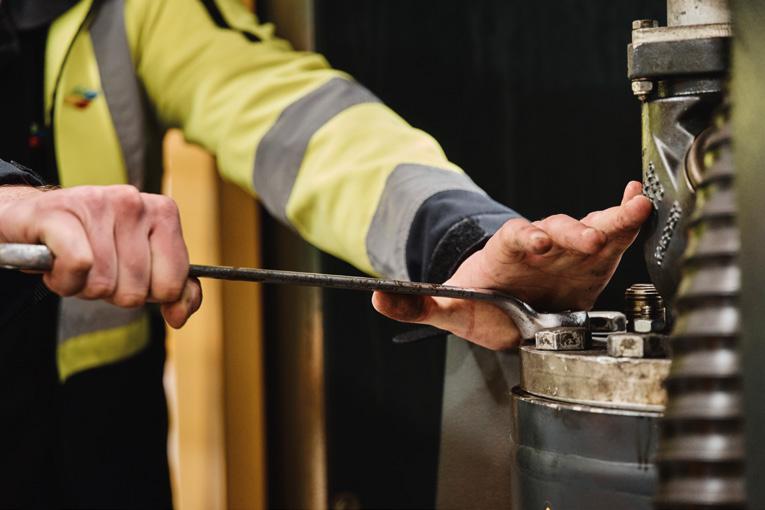
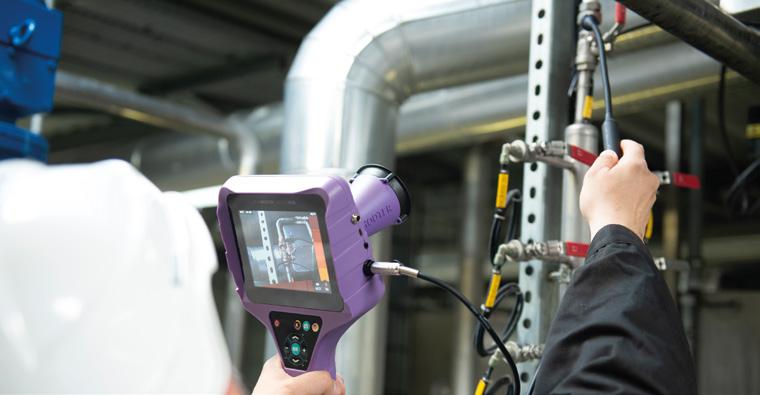

Pneumatic

Leading UK Supplier of compressed air, vacuum, pneumatic & fluid power process products. SHOP NOW
DISCOUNT
FIRST ONLINE ORDER * USE OFFER CODE
The
THORITE.CO.UK
YOUR
& Ancillary Equipment
& Consumables
Compressors
Pneumatic Accessories
Control Equipment
& Pumping
Process Control
Vacuum Products & Solutions Electro Mechanical Drives
to
www.thorite.co.uk 0800 034 5850
EASIER. FASTER. MORE INTUITIVE. A simplified shopping experience from beginning
end.
Editors Note
the
Manufacturing event at the ExCEl, London on 20-22nd March and Southern Manufacturing & Electronics 2023 in Farnborough from 7th to 9th February.
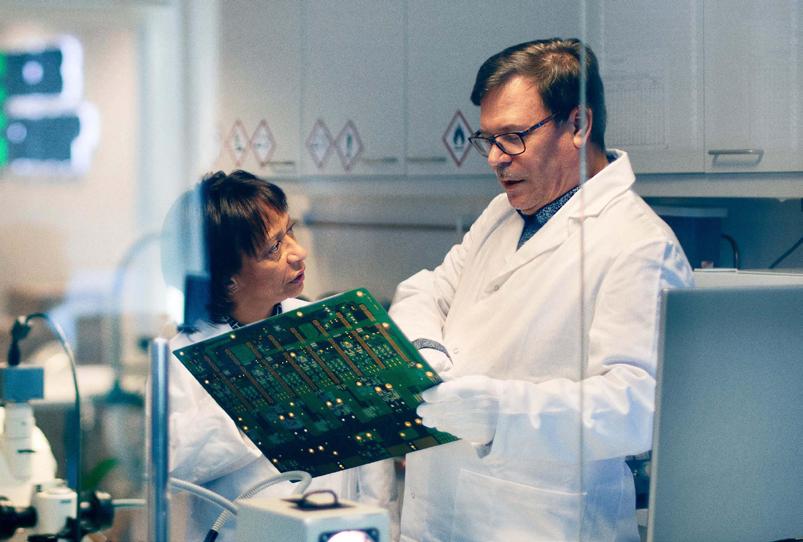


We also take a look at ways that using low cost smart energy sensors can facilitate manufacturing efficiency and increase savings in the industry and speak to Mike Cumbry on the subject, he gives us an insight on unlocking higher productivity and making big energy savings.

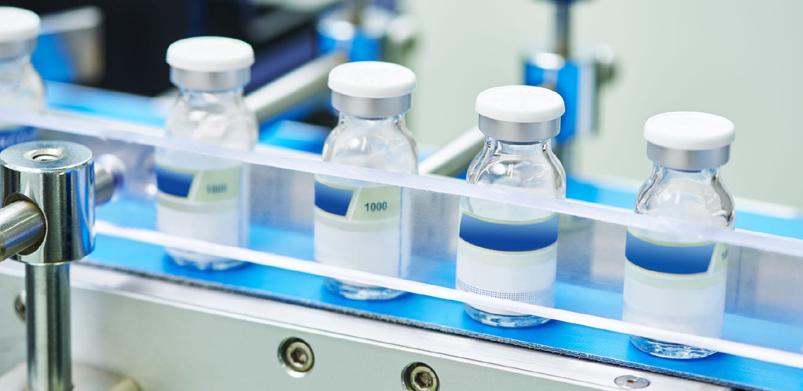


We hope you enjoy this issue and as always, if you have any news that you would like to feature, please email details to editor@mpemagazine.co.uk
We wish all our readers and their Companies a prosperous year ahead.
Every effort is made to ensure the accuracy and reliability of material published in Manufacturing & Production Engineering Magazine however, the publishers accept no responsibility for the claims or opinions made by advertisers, manufactures or contributors. No part of this publication may be reproduced or transmitted in any form or by any means, mechanical, electronic (including photocopying) or stored in any information retrieval system without the prior consent of the publisher.
03 Manufacturing & Production Engineering Magazine CONTENTS Editor Paul Attwood editor@mpemagazine.co.uk Senior Editorial Assistant Francesca Amato editorial@mpemagazine.co.uk Features Editor Harry Peters editorial@mpemagazine.co.uk Production/Design Laura Whitehead laura@lapthornmedia.co.uk Sales Manager Charlotte Chapman charlotte@mpemagazine.co.uk Sales Executive Felicity Hamilton sales@mpemagazine.co.uk Accounts Richard Lapthorn accounts@mpemagazine.co.uk Circulation Manager Leo Phillips subs@mpemagazine.co.uk Publishing Director Maria Lapthorn maria@lapthornmedia.co.uk Lapthorn Media Ltd 5-7 Ozengell Place, Eurokent Business Park, Ramsgate, Kent, CT12 6PB Tel: 01843 808 117 04 07 38 46 48 TISICS awarded UK Space Agency funding for sustainable launch tech Exhibition: Southern Manufacturing & Electronics: the all-in-one show Health & Safety: Managing contamination risks in pharma settings Exhibition: IFE Manufacturing returns for the food processing and packaging sector Technology: Are drones in the pipeline? The buzz around drones in the oil industry 04 48 38 07 46 Welcome to the first issue of Manufacturing & Production Engineering Magazine in 2023. With 2022 behind us, we can hopefully look forward to a New Year with new opportunities throughout the numerous manufacturing and production sectors. In this issue we
year
the usual mix of news and features including
begin the
with
reviews of
IFE
Attwood Editor @mpemaguk mpemagazine.co.uk
Paul
TISICS awarded UK Space Agency funding for sustainable launch tech
Aerospace manufacturing specialists, TISICS, have received funding from the UK Space Agency to develop demisable launcher components that will reduce the risk of damage to spacecraft by space debris, whilst reducing the processing time and materials waste experienced from current HPV-liner manufacturing.

According to the Government’s National Space Strategy, published in 2021, the UK’s space sector is growing faster than the rest of the UK economy, currently employing 47,000 people directly and supporting 190,000 jobs throughout the supply chain. The sector contributes almost £7 billion to the UK economy each year. With the global space economy
projected to grow to £490 billion by 2030, it’s critical that the UK builds on the commitments of the National Space Strategy to ensure continued growth and a safe, sustainable space industry.
Building spacecraft that demise during re-entry is key to future sustainability. TISICS aims to develop a weld-free, one piece aluminium liner/ tank addressing the need for low-cost launcher components, by way of flexible design, reduced process steps and improved materials efficiency.

Demisability gives launcher manufacturers advantages over conventional approaches and allows compliance with recently imposed Space Debris Mitigation requirements. Design for demisability reduces the additional mass penalty and consequent increase in spacecraft size, necessary for controlled re-entry.
The programme aims to accelerate the creation of a UK launch supply chain and ensure lasting competitive advantage to deliver the UK’s ambition of becoming the leading commercial spaceflight provider in Europe by 2030.
Altus Assists Customers in the Drive to Automate Labour-Intensive Processes
Lean manufacturing goals are still top of the agenda for companies producing electronic devices. Maximising productivity while minimising waste within a manufacturing operation is the main objective, and an important part of this principle is automation. Altus Group, a leading distributor of capital equipment, is assisting its customers with assembly solutions, including platforms designed to improve and automate high volume, high mix placement processes.
Labour intensive THT (Through Hole Technology) is still used in the assembly of PCBAs. This process is
not only expensive, but also requires highly-skilled operators with the added challenge of human-error reducing quality. To automate the process and improve productivity Altus advises using Cencorp odd-form solutions.
Joe Booth, Altus CEO said: “Oddform process automation is an efficient way to improve profitability significantly by increasing the throughput and assembly quality.
“They come into their own with the most complex and varied components, with flexible and sometimes bespoke gripper fingers to meet the requirements of picking and placing conventional parts.
“It is the ideal solution when production control is a high priority. Cencorp’s platforms include traceability software, increased assembly reliability, accuracy, labour savings, assembly yield improvements and even floor space savings. Cencorp’s odd-form range meets the demands of the toughest quality requirements and works in harmony with lean manufacturing and automation solution principles.”
To find out more about Cencorp odd-form solutions, or methods to improve automation within your facility contact Altus, www.altusgroup.co.uk
Company News 04 Manufacturing & Production Engineering Magazine
Ministry of Defence selects Atos for CORTISONE programme contract
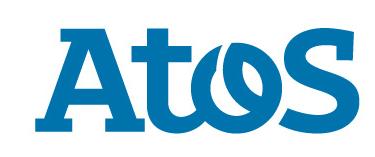
Atos will continue to provide support to the Ministry of Defence (MoD) for three years, with an optional extension year to be determined by MoD, through the renewal of its contract to help deliver CORTISONE - the programme focused on transformation of Defence Medical Services delivery within the UK’s Defence services.
The programme was established by MoD to deliver a sustainable and integrated system to enhance healthcare for all its personnel. The mission is to design, deploy and deliver the support to the CORTISONE ecosystem, to give the Defence Medical Services the ability to improve patient outcomes while maximizing resource efficiency and the number of service personnel fit for role.
Nikki Kelly, Senior Vice President, Public Sector and Defence, Northern Europe, Atos, said: “This renewed partnership allows for the continued transformation of modern Defence Medical Services provision by collaborating to deliver an integrated, cohesive and enduring capability to support evidence-based, patient-centric healthcare for all personnel.”
Atos has supported the MoD for over two decades across a broad range of digital advisory services, IT transformation and IT service delivery.
Swegon further strengthens its position in UK&I through the acquisition of Dalair Ltd, the family-owned manufacturer of bespoke air handling units (AHU) based in Wednesbury just outside Birmingham. Dalair is one of the AHU market leaders in the UK, with a highly regarded brand and offers air handling units in various segments covering commercial buildings, offices, retail, health care and pharmaceutical industries.
“I am glad to welcome Dalair to the Swegon family.
“Dalair has over the last four decades become a renowned brand in the market that is wellknown for their strong customer relationships and high-quality products.
“With the growing demand of bespoke AHU’s we now take an important step together with Dalair to complement and broaden Swegon’s offering in the UK and
reach a wider customer base”, says Andreas Örje Wellstam, CEO at Swegon Group.
“With Swegon we see a continued successful journey for Dalair.
“We share the same focus on quality and aim to be a trusted and competent partner for our customers, which makes Swegon a perfect fit for us.
“We look forward to becoming a part of Swegon, which will enable us to strengthen our position in the UK even further”, says Glyn Moseley, founder of Dalair.

Dalair, founded in 1981, has 150 employees, with the head office in Wednesbury and two additional sales offices in London and Manchester, UK. Net sales amounted in 2021 to GBP 17 million.
The closing of the deal is expected to take place in January, 2023.
05 Manufacturing & Production Engineering Magazine
Company News
Swegon signs agreement to acquire British air handling manufacturer Dalair
Atos has supported the MoD for over two decades across a broad range of digital advisory services, IT transformation and IT service delivery.
Integrated food projects rebrands to NIRAS
NIRAS has announced that its UKbased food and beverage capital investment expert, Integrated Food Projects (IFP) will rebrand and operate as NIRAS – creating the UK’s largest food and beverage manufacturing consultancy.

Integrated Food Projects, which was acquired by NIRAS in 2020, is located in Kegworth, East Midlands, and has
achieved substantial growth over the last five years - delivering projects for the world’s biggest food and beverage brands.
IFP will now fully integrate with NIRAS’s current food and beverage business operating from four locations throughout England (Ascot, Kegworth, Greater Manchester and Leeds).
NIRAS will be the UK’s largest food and beverage manufacturing consultancy, with a 150+ strong team of consultants, engineers and project managers currently working for clients around the world with a focus on helping drive change in the value chain and optimising their clients’ competitive position.
As part of the rebrand, Matthew Carr will be promoted to Business Unit Director. The senior leadership team will also include Nick Hickman, given the responsibility of VP Projects, and Phil Mason will take on the role of VP Operations.

Since the acquisition in 2020, IFP and NIRAS have integrated their complimentary services.
The combined business will provide a full service offering to the UK market
and global clients ranging from business consulting and strategic advice, through to design and project management and turn-key delivery. Following the merger, NIRAS will strengthen its shared resource pool and secure critical mass within business consulting, process, packaging, sustainability & utilities, civils and architectural design of food and beverage plants.
The name change will take effect on 1 January 2023. The company will be recognised under the NIRAS corporate logo and brand.
For further information, please visit https://www.niras.com/sectors/ food-and-beverage/
Orbis announces new US channel partner
announced a new
AV Water Technologies (AVWT) is a distributor of advanced systems to the water utility market, providing innovative and smart technologies. The company will be supplying the Orbis SmartCap in Southern and Central US, covering Texas, Oklahoma, Kansas, Missouri, and Arkansas.
The SmartCap is an intelligent fire hydrant and pipe monitoring device that enables remote leak detection by providing real-time data from a multisensor. In early 2022, the device helped a Southeastern water utility find a leak that had been running for 15 months. The SmartCap pinpointed the leak within three days of deployment, bringing significant water and cost savings.

Ross Thomson, AV Water Technologies president, said: “As a distributor of advanced water technologies, AV Water Technologies is pleased to be working in partnership with Orbis Intelligent Systems to provide the innovative SmartCap to water utilities. The partnership will help water
providers across the Southern and Central US quickly pinpoint leaks on their networks, reducing non-revenue water loss and saving precious supplies.”
Lou Rossetti, Orbis senior vice president of sales, North America, said: “Orbis’s new partnership with AV Water Technologies is fantastic news for both companies, as well as for water utilities in Southern and Central US. We are very much aligned in our mission to deliver smart water technologies. The wider distribution our SmartCap will create great value for both businesses and support municipalities in their critical role of delivering safe and reliable water services.”
Orbis Intelligent Systems is committed to delivering smart technologies that support utilities and municipalities in delivering safe and reliable water services. Its technologies create real-time data on pipeline infrastructure, providing vital insights into how to optimise water networks for maximum efficiency.
Company News 06 Manufacturing & Production Engineering Magazine
Smart monitoring company Orbis Intelligent Systems has
distributor.
Southern Manufacturing & Electronics: the all-in-one show
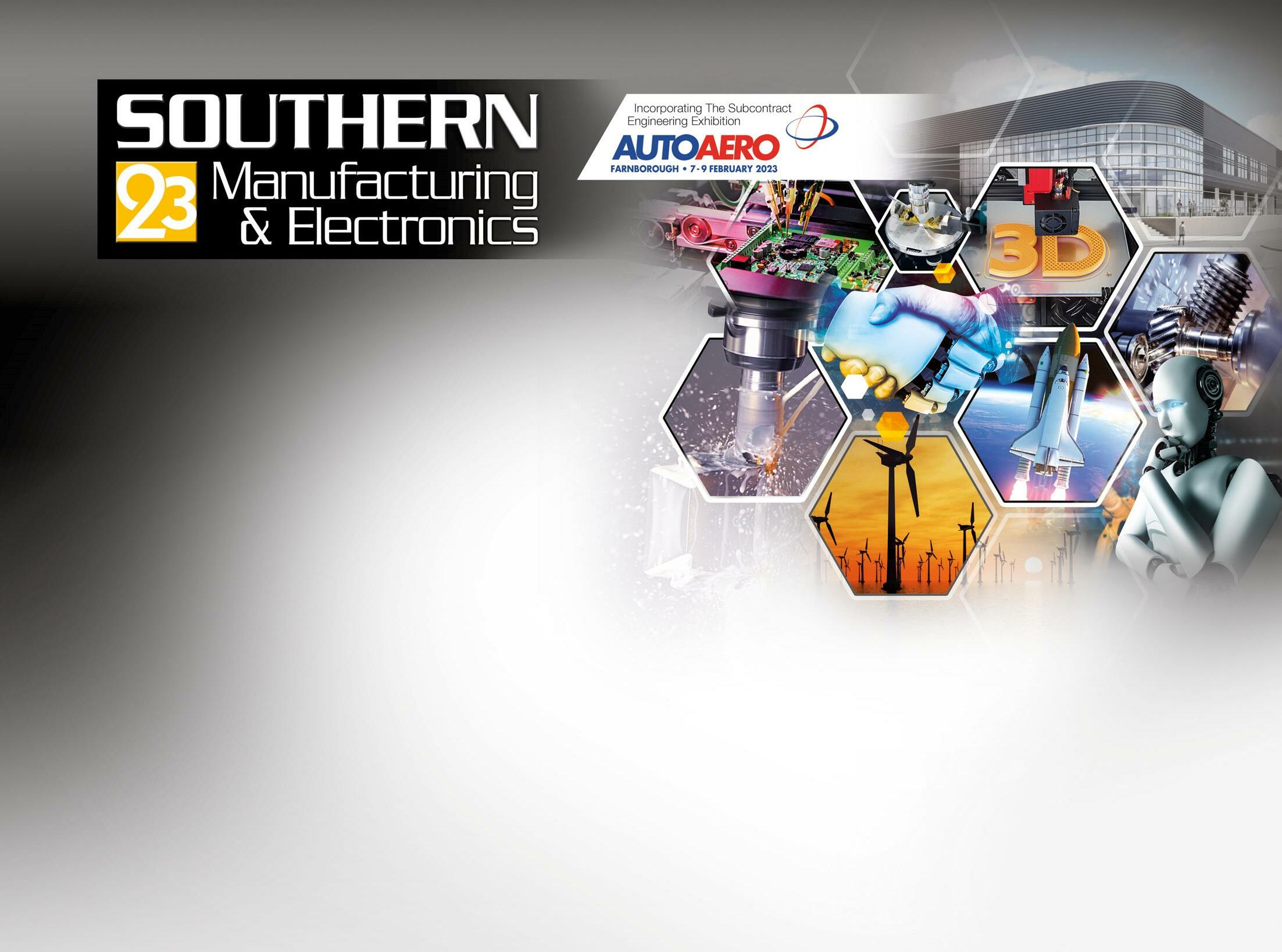
Featuring the very best of both mechanical and electronic engineering, Southern Manufacturing & Electronics 2023 will open from 7th to 9th February at the Farnborough International Exhibition and Conference Centre. Mixing two different disciplines at a trade show is unusual but has proved highly successful over the last 25 years. In that time the exhibition has grown from a small gathering of local firms to become a showcase for industry and engineering across the whole of the UK and Ireland, continental Europe and beyond.
Products and services include machine tools and tooling, workholding systems, metrology equipment, finishing machines, 3D printers, laser cutting and marking equipment, software, controls, displays, HMIs, data acquisition



systems, robot and cobot machine loading and other automation solutions. On the electronics side, surface mount technology, PCB manufacture and assembly, cables, connectors, and test and inspection systems will form a large part of what is on offer.

In addition to capital equipment, a host of firms will promote a vast array of mechanical, electrical, electronic, optoelectronic, electromechanical, hydraulic and pneumatic components


Where Industry and Innovation converge
Over 600 national and international suppliers come together to exhibit at Farnborough International Exhibition and Conference Centre this February for Southern Manufacturing and Electronics (inc AutoAero) 2023. Meet the power behind UK manufacturing industry and see live demonstrations and new product launches of machine tools & tooling, electronics, factory & process automation, packaging & handling, labelling & marking, 3D print technology, test & measurement, materials, composites & adhesives, rapid prototyping, ICT, drives & controls and laboratory equipment. Free industry seminar programme online @ www.industrysouth.co.uk The exhibition is free to attend, free to park and easy to get to. Doors open at 9.30am on Tuesday 7th February.
for your Fast Track Entry Badge, Preview Magazine and Event Catalogue at www.industrysouth.co.uk





and assemblies, as well as such items as drives, rotary encoders, linear scales, sensors and more. The event is also an important destination for sourcing subcontract services. Alongside the exhibition, a technical seminar programme will provide valuable learning opportunities. There is a regular, free bus service between Farnborough’s railway stations and the show. Parking is also free of charge, as is admission to the show.
More information regarding entry and a full list of exhibitors are available from www.industrysouth.co.uk
07 Manufacturing & Production Engineering Magazine
Southern Manufacturing & Electronics 7th | 8th | 9th FEBRUARY FARNBOROUGH | Hants | GU14 6TQ 9.30am - 4.30pm (3.30pm close Thurs)
TODAY
PRE-REGISTER
SOUTHERN MANUFACTURING & ELECTRONICS is an ETES event organised by European Trade & Exhibition Services Ltd Tel 01784 880890 · email philv@etes.co.uk AUTOMATION • DEFENCE • ELECTRONICS AUTOSPORT • MARINE • AEROSPACE TRANSPORTATION • PACKAGING • ADDITIVE MANUFACTURING R&D • ENERGY • LOGISTICS • FOOD & DRINK SMART MANUFACTURING • SPACE ENGINEERING ELECTRICAL & MECHANICAL ENGINEERING MEDICAL • COMPOSITES • CONSTRUCTION FREE SEMINARS FREE PARKING YEARS 1998 – 2023 SM&E22_AD_MPEM_2022-23_180Wx132H_ADVERT-Grey_with-25-Year-Anniversary.qxp_19122022 19/12/2022 13:47 Page 1
Engineering Promotions at AIDA-America
AIDA-America, metal stamping press manufacturer in Dayton, OH, USA, wishes to congratulate the following associates on their recent promotions.
Ben Shepherd has been promoted to Manager of Mechanical Engineering. He has been part of the AIDA-America Team for nearly 11 years. During his time at AIDAAmerica, he has worked as Mechanical Engineer, Senior Mechanical Engineer Mechanical Engineering Group Leader, and Assistant Manager of Mechanical Engineering. In his new role, Ben will manage engineering
resources, as well as department deliverables to meet the requirements of AIDA’s customers. He is directly involved in the development of new products while continuing to improve existing products and processes for both efficiency and to meet customer needs.
Wade Pearson has been promoted to Assistant Manager of Mechanical Engineering. He has worked at AIDAAmerica for over nine years. During that time, he has held the positions of Mechanical Engineer, Senior Mechanical Engineer, and Group Leader of Mechanical Engineering. In his new role, Wade will work as both a manager of and contributor to the Engineering Department while driving quality, process, structure, and efficiency improvements. He will also be involved in the development of new products for AIDA’s customers.
New Business Development Manager strengthens Thorite growth plans
Compressed air and fluid power specialist Thorite has appointed Jim Allen as Business Development Manager to support its £10 million growth plan, bringing the nationwide team to 13.

Lantek
appoints Adam Ball as its Solutions Sales Manager for the UK

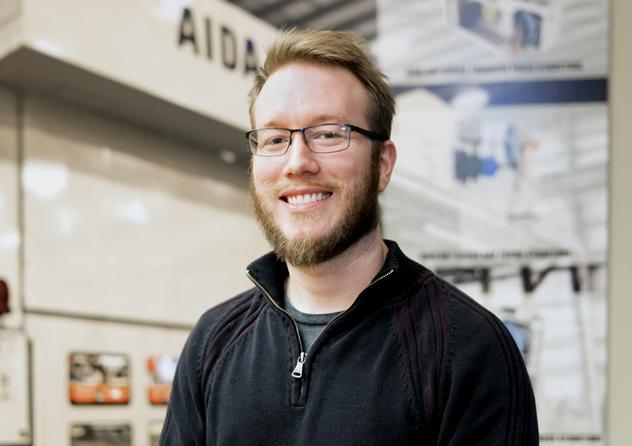
Lantek, a leading multinational in the digital transformation of the sheet metal and fabrication sector, announces the appointment of Adam Ball to develop the sales of its manufacturing solutions within the UK.
He has over 20 years of experience in sheet metal machinery, including laser cutting, waterjet and bending machines, gained in senior roles in service, applications and sales. This in depth and diverse knowledge of machinery and manufacturing processes will bring a thorough understanding of every aspect of business to Lantek’s clients, providing them with real world solutions that will reduce costs and increase productivity.
Adam Ball says, “It is an exciting time at Lantek, which made me want to return to the company. New software development is continuing at

an increasing pace through AI, cloud applications, the expansion of the development team and the investment from Trumpf. All these factors combine to make a forward-thinking company which will give me the opportunity to offer the industry both step-change and incremental improvements.”
Jim joins the Bradford-based company as Business Development Manager for the Huddersfield, Halifax and Wakefield areas of Yorkshire. He has a decade of sales and management expertise in the pneumatics and general industrial sector, most recently as regional manager for Leeds based specialist hazardous equipment manufacturer, Thermac.
His responsibilities will include setting and maintaining strategies for growth, strengthening customer relationships and developing new business.
Jim, who is based at Thorite’s Huddersfield branch, said: “I really enjoy working for companies such as Thorite, who want to not only supply products, but work in partnership with our customers to help them work in safer, efficient and more profitable ways. Anyone can sell products and move boxes but only experts in their field can work in this way.”
Jim will work alongside Thorite’s branch and operational teams to identify key growth potential and ensure that existing and new customers are able to optimise efficiency and productivity through the company’s bespoke solutions and comprehensive aftermarket services.
His appointment follows the announcement of Gregg Blyth as Business Development Manager for the North East region in July.
People On The Move 08 Manufacturing & Production Engineering Magazine
















t 01732 871 417 w tcardsonline.co.uk • Improving Task Management • Clear, Precise, Simple • Simple to customise to your requirements • Easy to set up • Free Mobile APP • Integrate with other Software Making work easier Making processes better The proven management tool to help keep track, allocate and improve efficiency NEW FEATURES See us at: Southern Manufacturing & Electronics 2023 Stand P150
Q5D opens state-of-the-art facility for wiring harness automation enabling further growth and innovation
Q5D, a leading innovator in wire harness manufacturing automation, is moving to a state-of-the-art production facility in Portishead, near Bristol (U.K.). This facility will enable further innovation in equipment to automate the manufacturing of wiring harnesses, a critical component of cars, planes, and consumer electronics that enables electrical functions including motors and lights. Q5D’s new headquarters will bring together core operations from design and engineering to manufacturing and testing under one roof. The union of commercial and manufacturing operations in the same building will also facilitate excellent customer service and support.
Q5D is a pioneering organisation making great strides to automate the addition of electrical connections and wiring using additive manufacturing, robotic tools, and laser sintering technology. The new facility offers twice as much production floor space and three times the office space of the previous building. This additional space

is critical to accommodate the growing number of engineers working on new product development and meeting the needs of an expanding customer base. In time, Q5D plans to open a Customer Experience Centre where customers can manufacture prototypes and parts within this facility.
Innovation is a core value of Q5D. Bringing their core design and manufacturing teams together in one building will enable these teams to be even more effective in the future. The Development Lab will create a hub for design, including advances to Q5D’s CY1000 production machine and smaller prototypes. The facility will also house
a Product Design and Engineering Centre and a space for the assembly and testing of machines before shipping to customers. In addition, Q5D plans to create a Field Service Team to supply spares and service machines.
“Our new facility at Portishead creates the space we need to accelerate our innovative wire harness technology solutions,” commented Stephen Bennington, CEO and Co-Founder of Q5D. “With all our core functions working together with our customers in this building, we can deliver solutions that revolutionise wire harness manufacturing and assembly.”
“The new facilities here in Portishead facility are an exciting development that will enable us to continue to develop innovative solutions for the wiring industry,” added Chris Elsworthy, CTO at Q5D. “This facility allows us to expand our team of engineers and create a work environment that accelerates learning and produces results.”
Find out more information about Q5D technology at www.q5dtechnology.com.
Turbine supervisory guide is free to download
If you are involved in the supervision of turbines and other rotating machinery the recent publication of a free-to-download Turbine Supervisory Guide from condition monitoring and protection specialists SENSONICS will prove invaluable. This latest guide follows the very successful release of two previous publications from Sensonics covering Vibration Monitoring and more recently focussing on Seismic Monitoring.
The supervision of turbines and other similar machinery is critical in power plants to ensure their smooth and trouble-free operation. Many serious faults, which can cause the immediate shutdown of equipment and significant loss of income, can occur as a result of excessive vibration.
When a mechanical problem, such as a cracked rotor first emerges, it can often be detected and rectified with a planned safe shutdown before severe or even catastrophic damage occurs.
This is where this comprehensive 21 page guide really helps as it outlines the importance of effective vibration, position and shaft speed monitoring as part of a turbine supervisory strategy in a clear and concise way.
The 6 part guide covers all the important aspects of Steam Turbine monitoring such as; Absolute Casing Vibration, Eccentricity and Relative Shaft Vibration, Rotor Differential
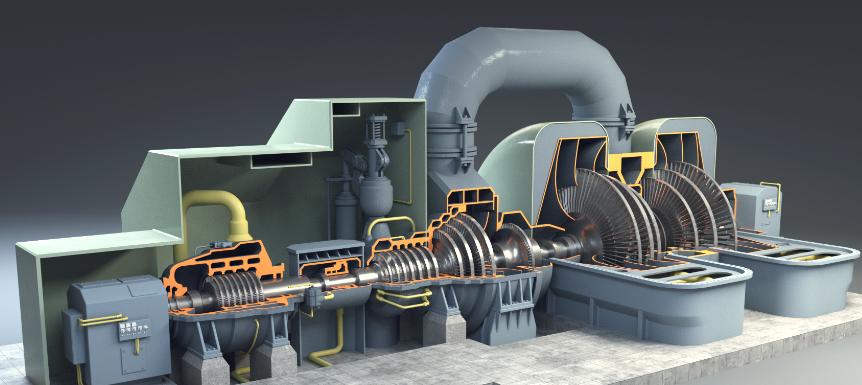
Expansion and Shaft Position, Rotor Speed, Overspeed and Zero Speed, Casing and Cylinder Expansion, Valve Position and finally, why it pays to work with a company like Sensonics who offer over 50 years of experience in Condition Monitoring.
For your FREE copy, simply log on to: https://www.sensonics. co.uk/download-your-turbinesupervisory-guide
Latest News 10 Manufacturing & Production Engineering Magazine
Colour sensor opens new opportunities in industrial monitoring

Omron has announced the introduction of its B5WC Colour Sensor, which enables monitoring of equipment, plant, and industrial processes through detection of small colour changes.
The new B5WC colour sensor uses a white LED to emit light and receive reflected light according to the colour of detected objects. The colour sensor separates received reflected light into red, green, and blue, then outputs RGB data as voltage values using the I2C interface.
Applications range from monitoring of lubricant deterioration in robot arms and elevators, through drinks dispensers, to object detection on production lines. Omron’s new B5WC promises an innovative solution to these issues. For example, the colour sensor monitors oil deterioration in hydraulic equipment used in industrial machinery - in real time using colours to monitor the condition of the oil. Providing maintenance at optimal timing is vital for manufacturing plants. Minimal production losses within manufacturing sites contribute to carbon neutrality. Development of sensing technology and optical design technology enables simpler integration into the equipment thanks to compact size, just W:40mm x D:8.4mm x H:15.9mm. Plus, integrating I2C communications into the sensor streamlines embedding in the equipment.
For further information please visit: https://components.omron.com/eu-en
Indicatura launches new partnership to support STEM professionals who’ve had a career break
Indicatura has launched a new scheme with STEM Returners specifically available to STEM professionals who have been on a career break and are looking to return to the industry.
Indicatura is a vibrant and fastgrowing consultancy that enables business leaders to make the best CapEx decisions for planned investments in new and existing physical assets. They work across industries from manufacturing and chemical to defence and nuclear sectors, working with industry leaders to enable the success of some of the nation’s most critical projects. STEM Returners will work with them to source
the candidates for the scheme and support with mentoring and careers coaching services.
The scheme will be open to people at all levels from graduate to senior consultant, with an engineering background, who have an interest in understanding how physical assets are configured, maintained and used.

STEM Returners was launched in 2017 by Natalie Desty after she saw how hard it was for people to return to STEM after a career break. They work with companies to facilitate returnships, which allow candidates to be re-integrated into an inclusive environment upon their return to the industry.
In STEM Returners’ annual survey
- The STEM Returners Index – 66%
of STEM professionals on a career break said they are finding the process of attempting to return to work either difficult or very difficult and that nearly half (46%) of participants said they felt bias because of a lack of recent experience.
STEM Returners’ programme aims to eliminate these barriers by giving candidates real work experience and mentoring during their placement, as well as supporting them to seamlessly adjust to life back in work.
Whilst the scheme helps solve the challenge of sourcing talent in sectors that need it, it also has the added benefit of increasing diversity in a host organisation. STEM Returners’ population of experienced professionals who are attempting to return to work are 46% female and 44% from ethnic minority groups, compared to 14% female and 9% from ethnic minority groups working in industry.
Since STEM Returners first launched in 2017, more than 310 STEM Returners candidates have joined programmes across the UK.
To view STEM Returners opportunities, visit https://www. stemreturners.com/placements/
11 Manufacturing & Production Engineering Magazine
Since STEM Returners first launched in 2017, more than 310 STEM Returners candidates have joined programmes across the UK.
Asset Finance – your next option for equipment funding
Asset finance is, for many firms in the Manufacturing sector, a form of funding they have used for many years. Yet still, for others, it’s not something they know much about. In this article we take a closer look at the different products and understand why it could be the perfect option when considering your next purchase.

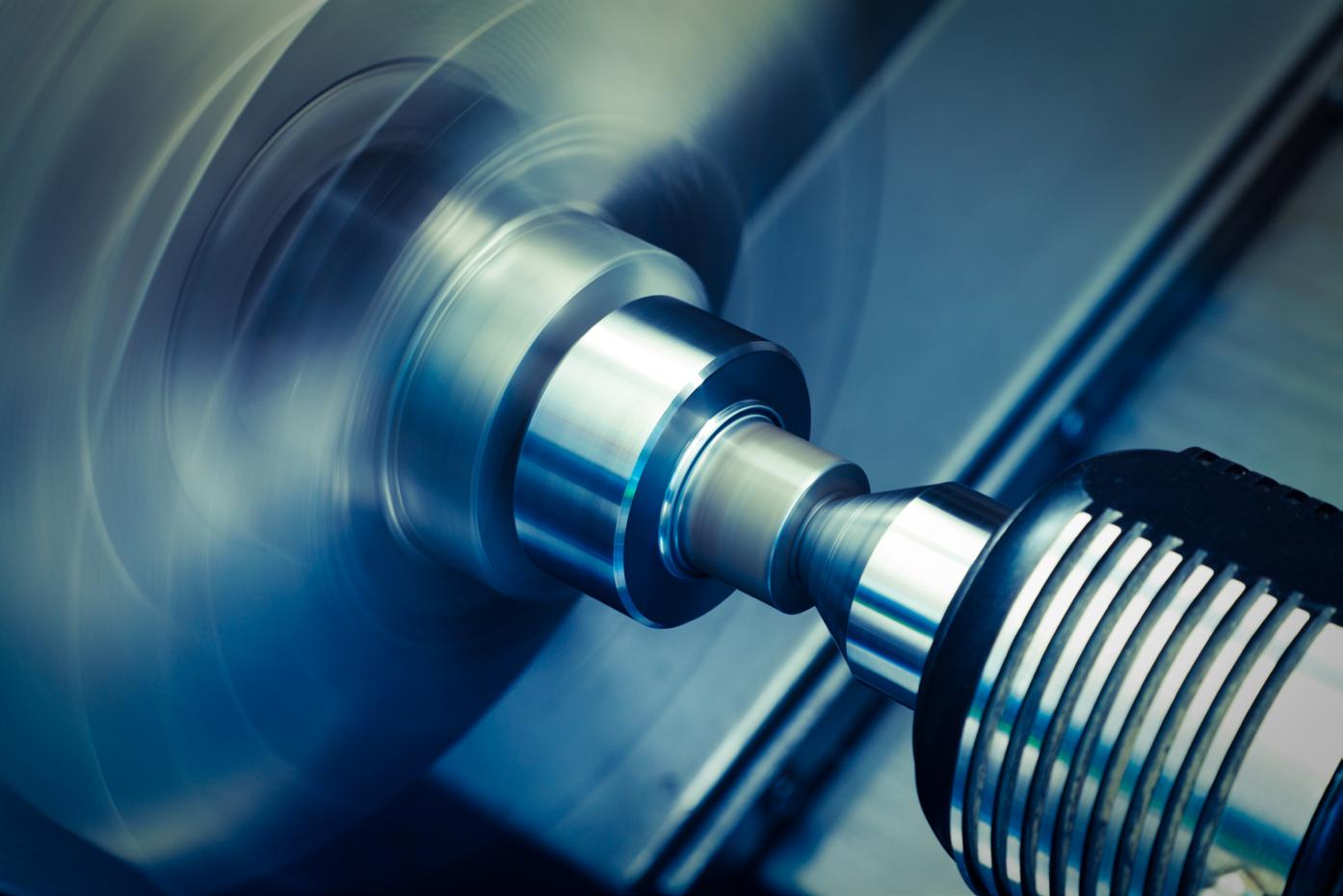
In short, asset finance is an alternative form of funding used by businesses to obtain the equipment they need to grow or access much-needed cash. It makes the otherwise unaffordable affordable because it gives businesses access to the equipment they need without incurring the cash flow disadvantage of an outright purchase.
Agreements can also be customised to the business’s needs, with flexibility on both the term and repayment schedule.
There are various products that come under the broad umbrella of asset finance with one of the key ones being Refinancing or capital release, as it’s also known; it’s a proven way to make your assets work for you and release cash back into the business.
It’s works by the finance company purchasing the asset and financing it back to you, with repayments calculated
in line with the income the asset is expected to generate; at the end of the refinance term, you own the asset.
This offers several benefits to a business that just needs a cash injection, whether it’s for investment in additional business critical assets or to use in other areas of the business, including unexpected bills and invoices, salaries, VAT payments, diversification - the uses are almost endless. Funders can also look to take over a finance agreement with another provider and extend the term, ultimately reducing monthly payments and easing the pressure on cash flow.
Other examples of asset finance products are:
• Hire Purchase (HP) allows you to buy equipment on credit. The finance company purchases the asset on your behalf and owns the asset until the final instalment is paid, at which point you are given the option to buy it
• Finance lease: The full value of the equipment is repaid to the finance company, plus interest, over the lease period. At the end of the term, you can choose to:
• continue to use the asset by entering a secondary rental period
• sell the asset and keep a portion of the income from the sale
• return it
• Operating lease: Similar to a Finance Lease, an Operating Lease allows you to rent the asset from the asset funder while you need it. The key difference between the two is that an Operating Lease is only for part of the asset’s useful life. This means you pay a reduced rental because the cost is based on the difference between the asset’s original purchase price and its residual value at the end of the agreement.
For more information, please visit: closeasset.co.uk/manufacturing
12 Manufacturing & Production Engineering Magazine
Asset Finance

Close Brothers Asset Finance is a trading style of Close Brothers Limited. Close Brothers Limited is registered in England and Wales (Company Number 00195626) and its registered office is 10 Crown Place, London, EC2A 4FT. With straightforward finance options, we can help you unleash the value in your business. • Acquire new equipment • Release value of existing assets • Respond to rising costs • Create positive cash flow • Invest in change and growth Our straightforward finance options and quick decisions on lending, enable our customers to react with confidence in their own marketplaces. closeasset.co.uk/mpe Does your business have hidden powers? Contact us today to find your superpower.
Floyd Gets a Grip on Small Parts
Now available from Floyd Automatic Tooling is the expanded range of MASA Microconic overgrip spindle collets. The precise and stable clamping of small workpieces in the sub-spindle of sliding head machines has long been an issue for turned part manufacturers - MASA has revolutionised this ‘pain-point’ for manufacturers to deliver precision workholding.
Until now, this industry-leading solution has been specified primarily on 20 and 32mm capacity sliding head machines. However, the remarkable popularity of the system has now seen MASA expand the series to cater for manufacturers working on 10 and 12mm diameter capacity machines.
To truly understand the Microconic revolution, manufacturers must first consider that only three things are in physical contact with the workpiece, the cutting tool, coolant/cutting fluid and the workholding. The Microconic over-grip collet system ultimately allows manufacturers to rethink what is possible. This remarkable workholding system consists of a cartridge and precision collet. The over-grip collet fits inside a cartridge and is accurately adjusted before it is fitted directly into the existing collet sleeve with no machine adaptations required.
The patented over-grip collets can open up to 4mm larger than the clamping diameter and also incorporate an ejection guide sleeve blank. This helps the end user to solve the difficulty of ejecting parts from the collets after machining. This allows manufacturers to reach behind flanges, parts with heads or any other enlarged feature.
Ideal for processing parts with stepped features such as connectors, screws or other common components, the over-clamp system can clamp over the protruding features and securely clamp on the main body of components. The collets are available with clamping diameters from 0.2mm to 10mm, meaning the most fragile of parts can be clamped safely and precisely. With concentricity between 3 to 5 microns, the MASA Microconic System is perfect for high-precision machining.
Previously, the system was available with F20, F25 and F37 style collets and this has been expanded over time. Now, the system is offered with F15 and F16 to deliver highprecision clamping for challenging components. The F15 M5 cartridge works in synergy with most 10 to 16mm capacity machine tools from manufacturers like Star Citizen, Tsugami and Maier whilst the F16 M5 variant is perfect for other machine tool brands such as Citizen, Hanwha, Tornos and Nexturn to name a few.

Commenting upon the expanded range, Floyd Automatic Tooling Managing Director, Richard Floyd says: “The expansion to the line has been sought after for a long time. This is a credit to the success of the MASA Microconic collets for 20mm and 32mm diameter capacity machines. Small-diameter sub-spindle clamping and over-gripping applications have historically been a bane for users of sliding head turning centres. This radical, but elegant solution brings repeatability and precision to small part turning, solving the challenge of clamping difficult parts.”
Witte: Rotary plate with scale and
vernier
setting grid
Witte is expanding its ALUFIX modular fixturing system with another practice-oriented detail: a turntable variant with scale and vernier setting grid. The innovation allows workpieces to be aligned more easily, quickly and precisely at the same time.
The new rotary plate with scale and vernier grid is based on the highprecision ALUFIX fixturing system from Witte and thus adopts its reference values in terms of accuracy and material quality.
The plates that are compatible with the ALUFIX 25 system size have a setting grid in one-degree increments and a rotation angle of 0 to 360 degrees.
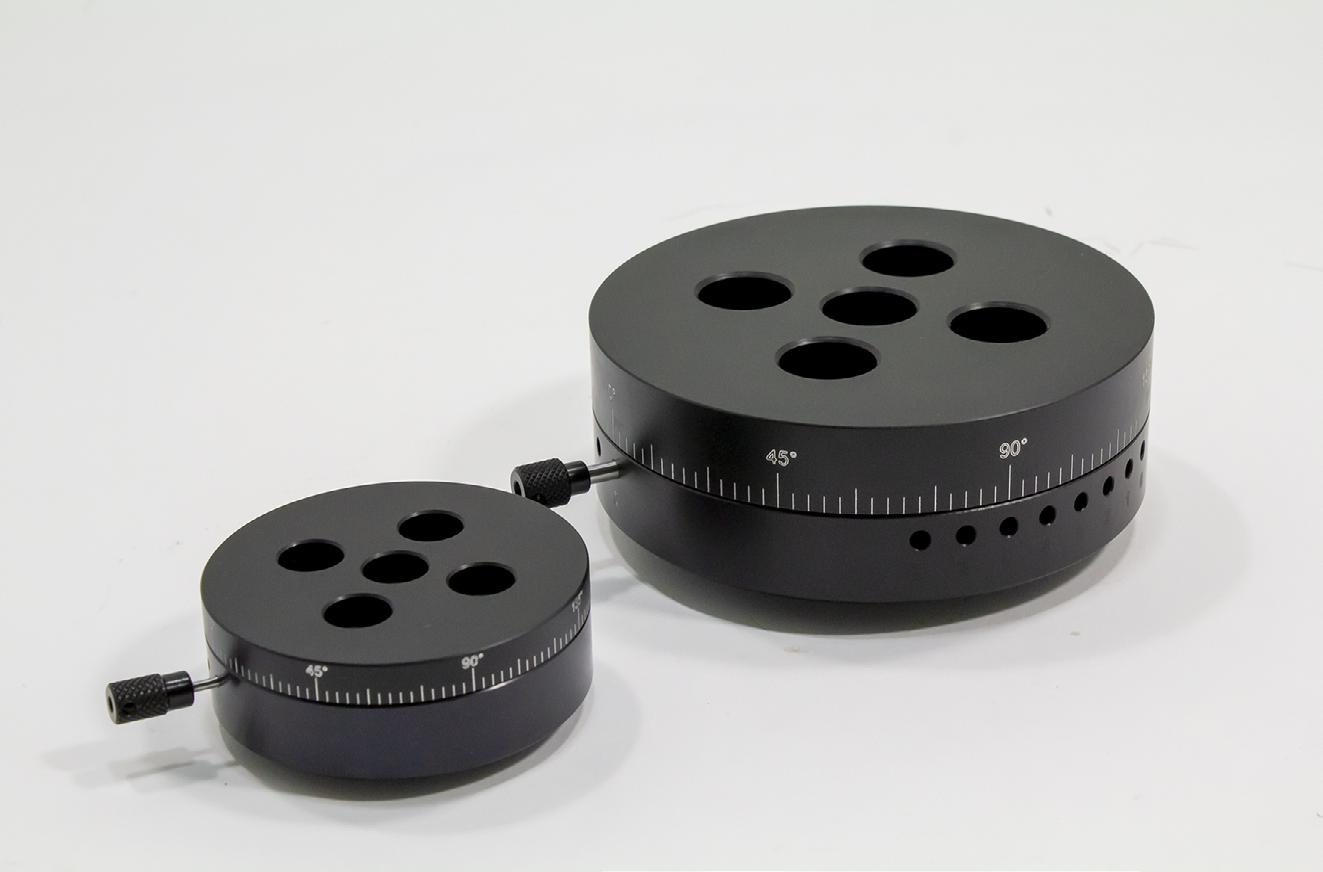
The 1-degree grid adapts the system of the TopPos positioning system from Witte. TopPos is based on standardized precision components that can be easily moved in the grid using a positioning element and thus reach the clamping point precisely - without the need for specially made adapters. In this way, TopPos makes a good 90 percent of the cost-intensive special components otherwise required in conventional workpiece systems superfluous.
A high-quality anodized coating ensures that the new rotary plates are extremely durable, even in heavy-duty use.
Latest Product Launches 14 Manufacturing & Production Engineering Magazine
The UK Patent Box - Tax relief on innovation
The Patent Box is part of the Government’s growth agenda (as detailed in the Plan for Growth document published in March 2011). The Patent Box scheme allows companies, who pay UK corporation tax, to elect to apply to benefit from a reduced rate of corporation tax. The full benefits of reduced rates of corporation tax becomes applicable from 1st April 2017. Reduced rates of corporation tax apply to profits attributable to qualifying patents, whether received as a royalty or embedded in the sales price of products. The regime also applies to other qualifying intellectual property rights such as regulatory data protection (also called ‘data exclusivity’), supplementary protection certificates and plant variety rights. Other non-qualifying profits in the companies will continue to be taxed at the main rate.
The aim of the Patent Box is to provide an additional incentive for companies to retain and commercialise existing patents and to develop new innovative patented products. This should encourage companies to locate
the high-value jobs associated with the development, manufacture and exploitation of patents in the UK and maintain the UK’s position as a world leader in patented technologies.

Eligibility
You can only benefit from the Patent Box if your company is liable to Corporation Tax and makes a profit from exploiting patented inventions. Your company must also own or exclusively license-in the patents and must have undertaken qualifying development on either the creation or development of the patented invention or a product incorporating the patented invention
If your company is a member of a group, it may qualify if another company in the group has undertaken the qualifying development. It must also actively own the patented invention by taking a significant role in managing its whole portfolio of eligible patents. Your company doesn’t have to make all the decisions regarding the portfolio, but it must undertake a significant amount of the management.
KEB Automation: New powerful permanent magnet brake is optimised for use in servo motors
KEB Automation has introduced an innovative permanent magnet brake that is optimised for use in servo motors. The new COMBIPERM P2 brake achieves significantly higher torque and has a more compact design to fit smaller installation spaces.

Brakes in servo motors must work precisely under specific ambient conditions. With this in mind, KEB developed the COMBIPERM P2 as the successor to its long-established COMBIPERM P1 brake.
“The P2 was built for the requirements of servo motors. It needs less power, which means that the motor does not heat up as much. Furthermore, the brake has the added advantage of an optimised magnetic flow,” explains Hendrik Wieneke, Head of Sales Brakes and Clutches at KEB.
More emergency stops and a larger wear reserve
The improved magnetic flow in the newly developed permanent magnet brake has positive effects on the torque. In addition, less permanent magnet material is required. Innovations in the P2 also include a felt ring, which is now integrated as standard. Due to the position of the brake on the engine mount, this serves, among other things, to catch the oil mist that is produced. More emergency stops and a larger wear reserve are further benefits that distinguish the P2 from its predecessor. Designed for voltages of 24V and with a torque range of 1 to 60Nm, the P2 presents itself as a particularly powerful brake.
“Thanks to its precision and its resistance to high temperatures in the
You can benefit from the Patent Box if your company owns or exclusively licenses-in patents granted by the:
• UK Intellectual Property Office
• European Patent Office
• Other countries in the European Economic Area: i.e. Austria, Bulgaria, Czech Republic, Denmark, Estonia, Finland, Germany, Hungary, Poland, Portugal, Romania, Slovakia, Sweden
If your company holds licenses to use others’ technology it may still be able to benefit from the Patent Box providing it meet certain conditions.
MCS Corporate Strategies Ltd


Website: www.mcs-corporate.com
Phone: (01926) 512475
Email: charlotte@mcs-corporate.com
FS 616273
motor compartment, the COMBIPERM P2 is suitable for numerous application areas. Servo motors, robotics, medical technology and logistics are just a few examples where our brake solution is in demand,” adds Wieneke.
The new COMBIPERM P2 brake is already in use at various customers and is undergoing further tests. Market launch is planned for the middle/end of 2023.
For more information on the COMBIVERT F6 and COMBIVERT S6 ‘APPLICATION’ device variants, please visit www.keb.co.uk

15 Manufacturing & Production Engineering Magazine Latest Product Launches
Inventor-e targets £1m opportunity after signing PP C&A manufacturing deal
Transforming inventory management is paying off for Inventor-e after it signed its latest deal to scale-up production.
The Solihull-based company has extended its working relationship with PP Control & Automation (PP C&A) to include the build of its latest model, the
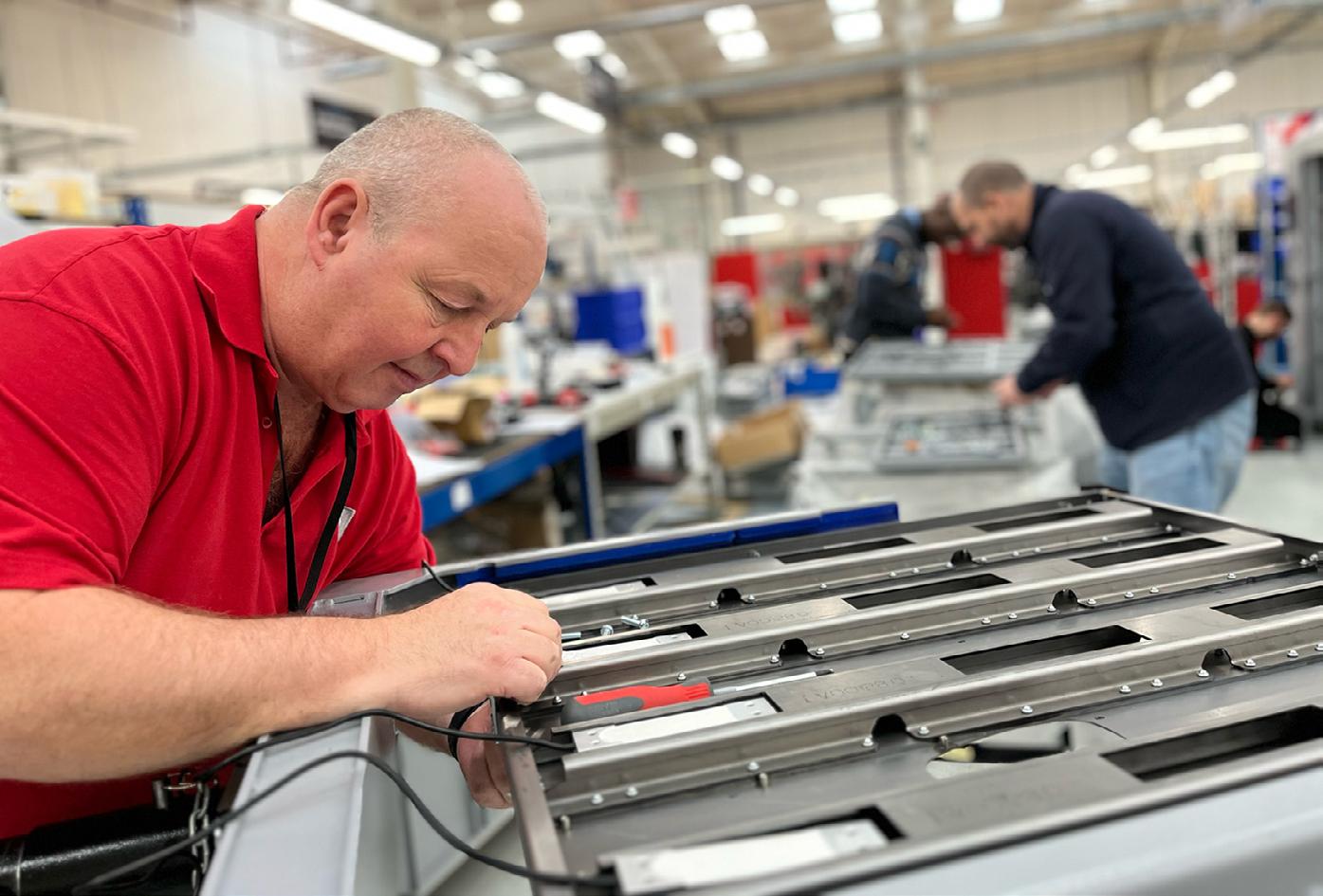
iVendScale+, and has already won orders to supply Mitsubishi’s vast factory in Scotland and Babcock’s Faslane and Coulport facilities.
Targeted at managing fast-moving consumables for manufacturers and Maintenance, Repair and Operations (MRO) facilities, this is the firm’s largest inventory management system to date with four separate cabinets housing up to 72 weight sensor-controlled bins per cabinet that can store MRO consumables, PPE, fasteners, critical space and other industrial essentials.
End users receive full accountability as the software monitors what is taken by each employee, which will typically drive a reduction in consumption by between 20 to 40%.
Inventor-e CEO Dean Henry is expecting sales for this system to hit £1m this year and, in order to cope with a rise in volumes, has used the strategic manufacturing outsourcing expertise of PP C&A to manage the final electrical design and build of iVendScale+.
A production cell for the new system has been added to the existing Inventor-e
Total Construction Supplies reinforces expansion plan with £4m investment in 220,000 sq ft factory
The UKs leading manufacturer of prefabricated reinforcement steel has invested £4m into a new 220,000 sq ft facility in Cannock, with 57 new jobs created so far.

Total Construction Supplies Ltd, which was founded in 1998 by Craig Gibbons and Matthew Hague, has seen turnover double after securing major new contracts with HS2 and a host of highways, housing and nuclear infrastructure projects.
This growth has driven the need for the new Walkmill Lane site that has already been fitted with stateof-the-art cutting and bending
Company News 16 Manufacturing & Production Engineering Magazine
manufacturing lines at PP Control & Automation’s world class facility in Cheslyn Hay.
Lead times of iVendScale+ have been drilled down to between ten and twelve weeks if all materials are in place, a situation that has improved greatly after the two companies chose to overcome global supply chain disruption by buying a considerable amount of stock and electrical components up front.
For further information, please visit www.ppcanda.com or follow @ppcanda on twitter. More details on Inventor-E can be found at www.inventor-e.co.uk
machinery, industry-leading welding equipment and overhead gantry cranes stretching the length of the production area.
The facility was officially opened on Friday December 9th as part of a major open day featuring guided tours, ‘day in the life of an employee talks’, and meet the managers.
It also kickstarted the next recruitment push to fill a further 60 positions in 2023, with the company hoping to overcome labour market issues by maximising a strategic partnership with HMP Oakwood.
Matthew Hague and Craig Gibbons initially set-up Total Construction Supplies in 1998 to provide PPE and construction accessories to customers in the West Midlands.
The business ticked along nicely, until a chance contract meeting ten years later saw the duo diversify into manufacturing prefabricated reinforcement steel for several national infrastructure projects.
More than a decade on and the company is now the supplier of choice for piling, reinforcement mesh, caging and cut and bent products.
For further information, please visit www.total-group.co.uk
Omron Electronic Components Europe announced that it has signed a pan-European distribution agreement with Conrad Electronic, the German based sourcing platform for technical supplies operating in 17 European countries.

Under the new agreement, Conrad will supply popular devices from Omron to business customers throughout Europe. Omron offers its customers component solutions that contribute to the take-up of new sustainable forms of energy and of high-speed communications.
These include not only the highperformance, high-quality relays and switches for which the division is famous, but also innovative
environmental sensors that enable electronic systems to respond appropriately to the context in which they are operating. Initially, the Conrad Sourcing Platform will present more than 4,900 of these Omron products. The two companies plan to widen the range of products accessible through the platform as Omron introduces new and relevant solutions.
Commenting, Gabor Matrai, European Distribution Account Manager at Omron explained that the new partnership is to enhance and improve its service to its customers in Europe. “Conrad Electronic is widely used throughout Europe and especially in Germany by engineers to source devices and components for their prototype and production projects. We are delighted to add them to the Omron distribution network, giving our customers an additional option for sourcing our high quality and innovative component solutions.”
Michael Schlagenhaufer, Senior Director of Product and Supplier Strategy at Conrad Electronic, added, “The Conrad Sourcing Platform already enables simple, fast and comprehensive procurement for technical supplies from a single source.
“We are looking forward to working with Omron and are certain that Omron’s product portfolio optimally complements our already broad and deep range of solutions for professionals in electronics, industry, automation and IT.”
17 Manufacturing & Production Engineering Magazine Company News
Omron expands European distribution network with Conrad Electronic partnership
A production cell for the new system has been added to the existing Inventor-e manufacturing lines at PP Control & Automation’s world class facility in Cheslyn Hay.
North West Manufacturer Celebrates Golden Jubilee
North West manufacturer Dean Group celebrates 50 years of highquality manufacturing services.

Eighty guests attended the Black Swan in Warrington to celebrate the company’s past achievements and bright future. As well as employees and their families, the event included many influential members, such as key suppliers and executives who witnessed the founding of Dean Group. In addition, current managing Director

Graham Stubbs gave an impassioned speech about the company’s journey that was emotionally well-received by everyone, including Chairman Christopher Dean.
In 1982, Christopher Dean joined the company, followed shortly after by his sister Carol Hutchison as in 1985. This family-run business grew significantly over the last 50 years from Dean Groups’ initial UK facility in Stretford in 1972. Before moving the company to a purpose-built facility in Irlam, Manchester, with no loss of production.
With this full-fledged foundry established next to a major UK city, Dean Group has spent decades creating made-in-UK castings with superior precision and short lead times.
Christopher became managing director of Dean Group in 1995 and led his team to several accreditations and award nominations over the years. With Dean Group recently being shortlisted
Farnell sponsors Team HyperShock in new season of BattleBots
Multicomp Pro, exclusively sold by Farnell, has announced its sponsorship of Team HyperShock in the seventh season of the hit robot combat television series, BattleBots.
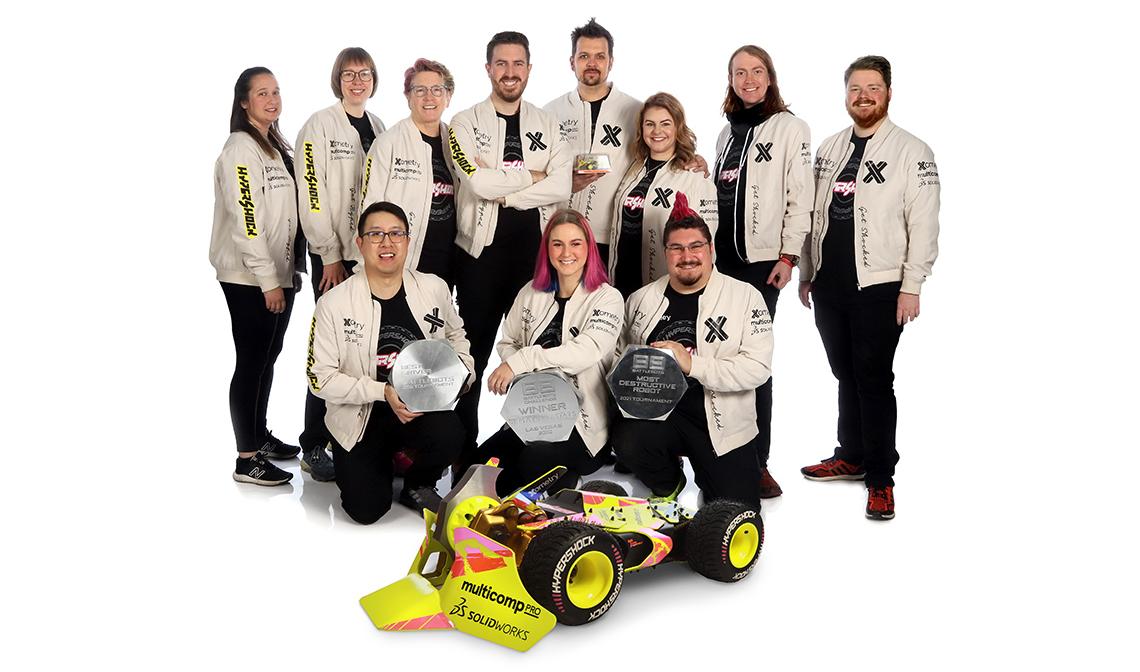
Team HyperShock, captained by Will Bales, had an exciting Season 6 where they earned themselves the award for Most Destructive Robot, making
them one of the most awarded teams in the reboot with 3 Giant Bolt awards. HyperShock also holds the record for the fastest KO in the reboot, throwing Skorpios out of the arena in just 24 seconds in BattleBots: Champions.
“I can’t think of a better way to celebrate the three-year anniversary of launching the Multicomp Pro brand than
for ‘Made in the North West 2022’, the company has also won several prestigious awards, such as:
• Prestigious Salford business award for Technology (2010)
• Gold Environmental award (2019)
Dean Group is now a threegeneration company with Sam Dean supporting this family business as an Estimating Engineer and Jack Hutchison recently promoted to deputy production manager
All attendants enjoyed the vibrant celebration as the close-knit teams shared stories, anecdotes, and memories of Dean Group’s long journey to reach this golden jubilee moment. With any landmark event about past achievements, thoughts inevitably turn toward the future.
to sponsor the most exciting BattleBot,” said John Casiello, Global Marketing Manager – Multicomp Pro at Farnell. “To be successful in BattleBots, a team must have a well-engineered bot, be willing to take risks, and overall, have fun while doing it. It’s the engineering way and Multicomp Pro is happy to support Team HyperShock.”
“Special thanks to Multicomp Pro for sponsoring us and providing some great equipment to build HyperShock. From supplying the Multicomp Pro tools and equipment to supporting us through all the craziness of getting here this year. It’s been a wonderful season and I can’t wait to showcase everything we’ve done together,” said Will Bales, HyperShock Team Captain.
Multicomp Pro is developed by engineers for engineers and features products and components that meet the quality standards engineers require and the value they need to build and maintain quality projects, even destructive robots, at a lower cost without sacrificing quality. The Multicomp Pro range includes more than 70,000 products and is suitable for engineers at any level, with average savings of 20% percent compared to branded products.
element14 Community, a part of Farnell, will also be presenting exclusive interviews, photos, videos and contests with Team HyperShock.
Events & Awards News 18 Manufacturing & Production Engineering Magazine
Anritsu Field Master Pro™ MS2090A Wins Fierce Innovation Award – Telecom
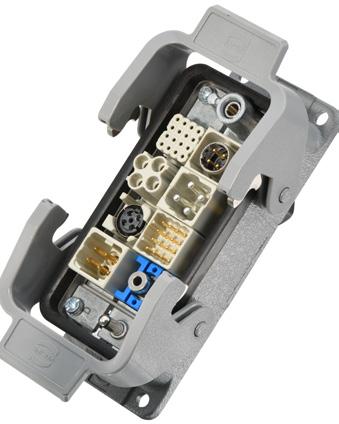

Edition in T&M Category
Judging Panel of Industry Leaders Recognizes MS2090A Real-Time Spectrum Analyzer as Top Test Instrument of 2022.
Anritsu Company announces that its Field Master Pro™ MS2090A realtime spectrum analyzer has been named the winner in the Network Test & Measurement category Fierce Innovation Award – Telecom Edition 2022. The Field Master Pro MS2090A was recognized by a panel of judges based on criteria that included the instrument’s ability to make a positive, innovative, real-world impact on the telecom industry.
The Fierce Innovation Awards seek to recognize the creators, makers, and doers of outstanding services and equipment unveiled in the past 12 months. It is intended to promote the
competitive spirit and initiative to spark new design, development and distribution of inventive solutions; find revolutionary tech or services; and to acknowledge and honor the most visionary operators, service providers, and vendors for their commitment to next-gen business and consumer offerings.
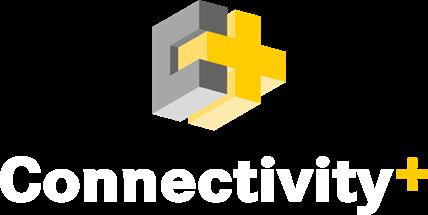

Portable and lab-based hardware and software or centralized solutions for testing, management and maintenance of telecommunications networks were eligible for the Network Test and Measurement award. Judges evaluated
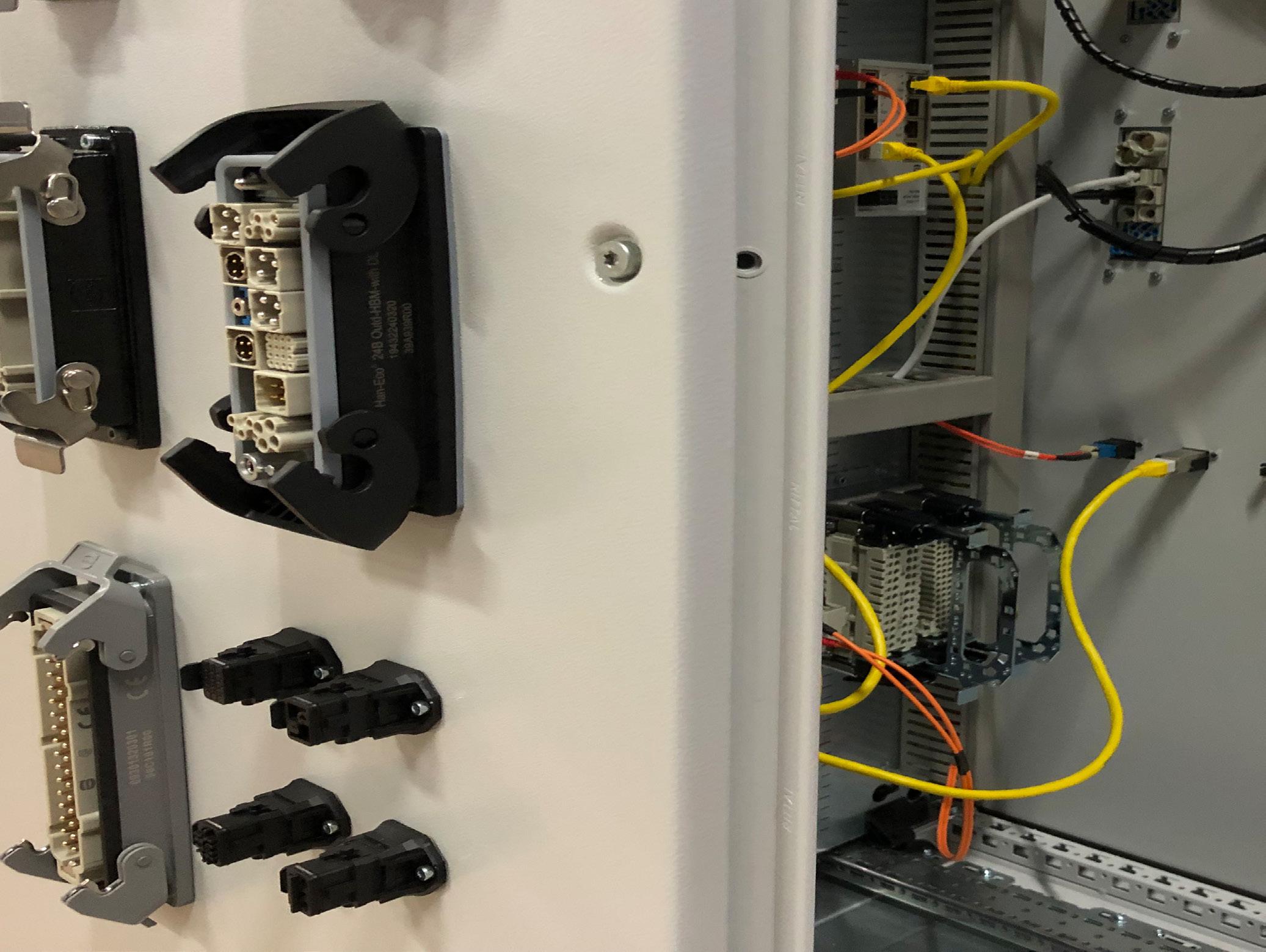
all applications based on ease of use/ ROI, effectiveness, technical innovation, competitive advantage, financial impact, and true innovation.
“Earning a Fierce Innovation Award acknowledges the exceptional efforts of our engineering and support teams who developed the MS2090A. Field Master Pro brings best-in-class performance into the field and addresses current and future testing needs in a wide range of commercial, private, and government use cases,” said Wayne Wong, Anritsu Product Marketing Manager.

19 Manufacturing & Production Engineering Magazine
Han-Modular® Domino ModulesTechnology for industrial transformation. The next level of modular industrial connectors. One Range. No Limits: www.HARTING.com/domino The first modular connector with a hybrid module configuration ■ Smaller and lighter connectors allow space savings of up to 50% ■ Compatible with the Han-Modular ® series, the market standard for modular industrial connectors ■ Maximum flexibility; scalable to the respective need ■ Sustainability through consistent modularisation ■ Reduction of installation times by combining several connections Events
News
& Awards
Excellent Quality Mazak & Brother
3, 4, & 5 Axis Machining
Centres, Lathes, Drilling and Tapping Machines
Bidding Ends: Wednesday 22nd February 2023 at 3pm (UK Time)
·Mazak HCN-5000 Horizontal Twin Pallet CNC Twin Pallet Machining Centre (2018)
·Mazak Nexus 5000-III Horizontal Twin Pallet CNC Machining Centre (2016)
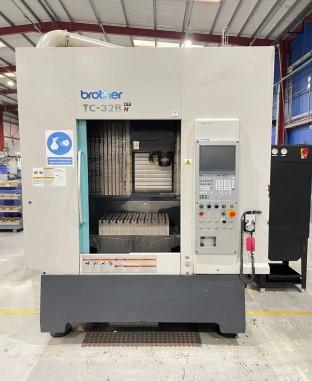
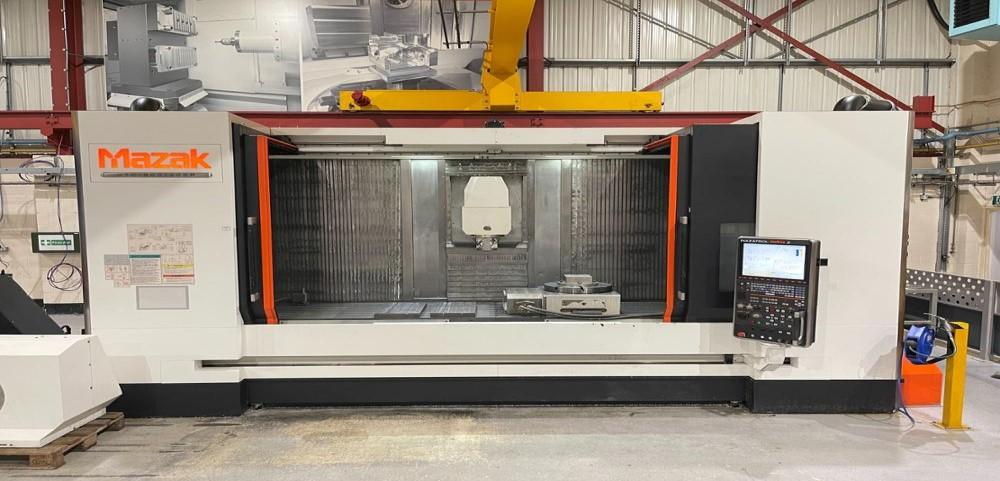
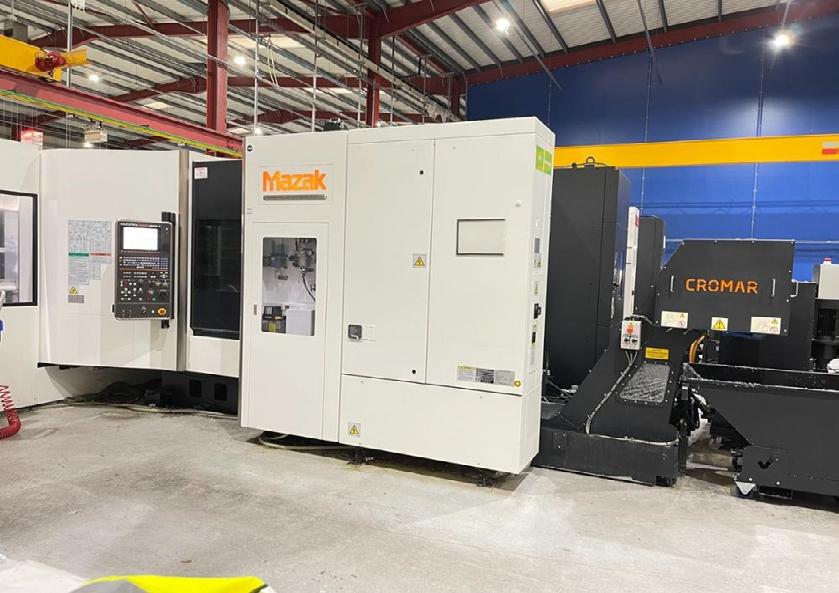
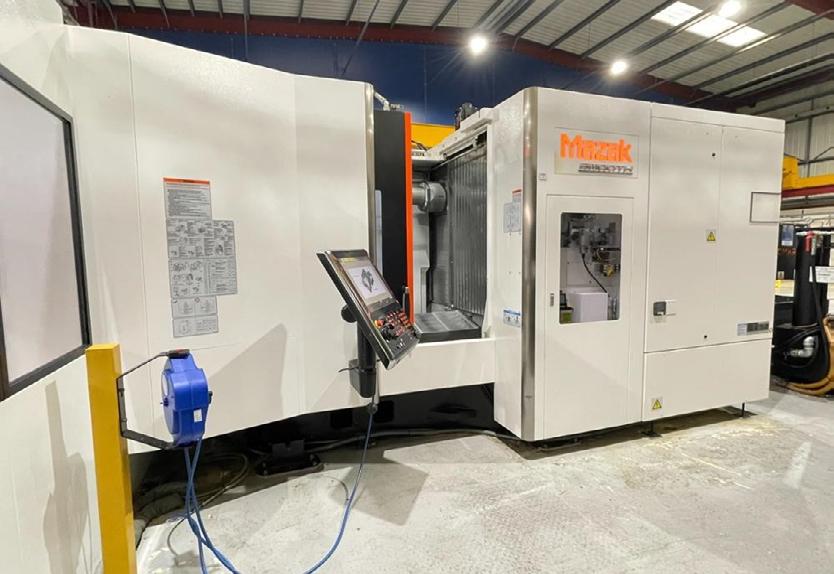
·Mazak Palletech Manufacturing Cell (2016)
·Mazak VTC-800/30SR CNC Vertical Machining Centre (2016)
·Mazak Quick Turn Nexus 250 -II MSY CNC Turning Centre (2014)
·Brother Speedio R650X1 Twin Pallet Machining Centre (2018)

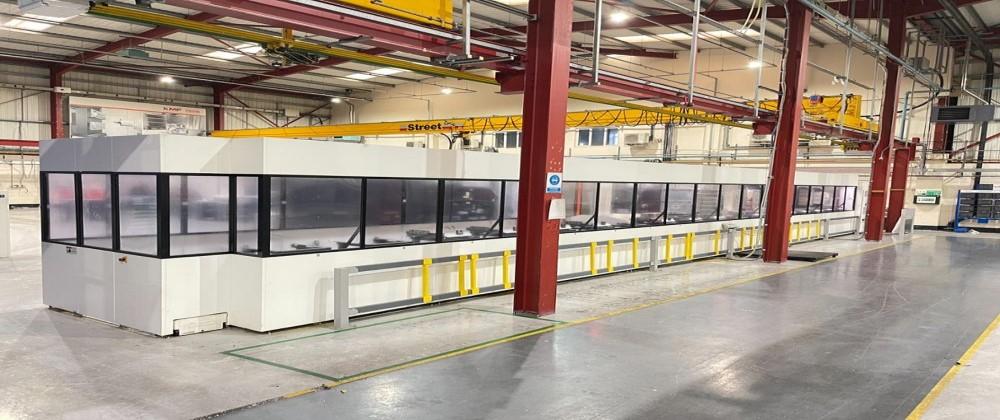
·Brother TC-S2DN-0 CNC Tapping Centre (2014)

·Brother TC-32BN-QT CNC Twin Pallet CNC Machining Centre (2008)
·Brother TC-S2D-0 CNC Tapping Centre (2010)
·Brother TC-S2D-0 CNC Tapping Centre with Brother CNC Control (2011)
·ACS OMF-1000 Air Cleaning System (2011)
·Brother TC-32BN-FT CNC Machining Centre (2008)
·Colchester Triumph 2000 Gap Bed Centre Lathe
·Ajax NM4VS Turret Head Milling Machine
·Mecwash Mini 300 Special Parts Wash Machine (1999)
·Axminster SB-16 Pillar Drill
·Brierley TG-S Double Ended Toolpost Grinder
·Brierley 2B 32/2 Drill Point Grinder
Online Auction Sale For Full Information please visit our Website: www.cottandco.com For Further Information please contact our Office: Cottrill & Co, 401 407 Tyburn Road, Erdington, Birmingham, B24 8HJ ▪ Tel: + 44 (0) 121 328 2424 ▪ Fax: + 44 (0) 121 327 9550 ▪ ▪ Email: info@cottandco.com ▪ Website: www.cottandco.com ▪ Cottrill & Co is a Trade Name of Cottrill & Associates Ltd
CNC Lathes, Machining Centres, Bridge Type & Plano Milling Machines, Thread Rolling, Fabrication & Toolroom Machinery formerly used by Ham Baker Group

Bidding Ends: Thursday 23rd February 2023 at 3pm (UK Time)
·DMG Mori NLX 2500Y/700 CNC Turning Centre with DMG Mori Ergoline Touchscreen Control (2016)
·Driven Tooling suitable for DMG Mori CNC Turning Centre
·MT 3258-1 ER32 Driven Tool suitable for DMG Mori
·MT3257-1 ER32 Driven Tool suitable for DMG Mori
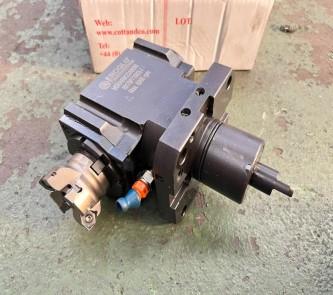
·Doosan Lynx 300M CNC Turning Centre

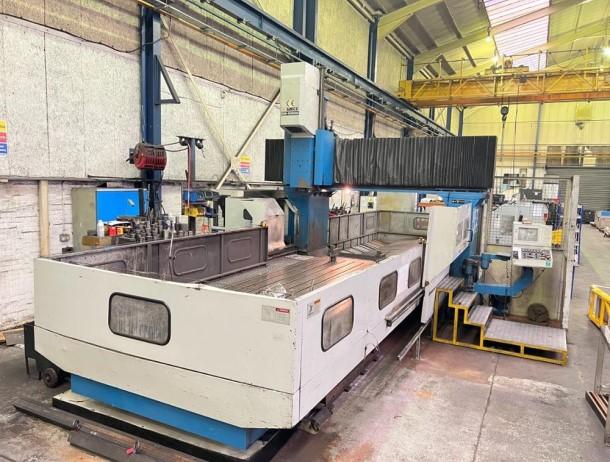

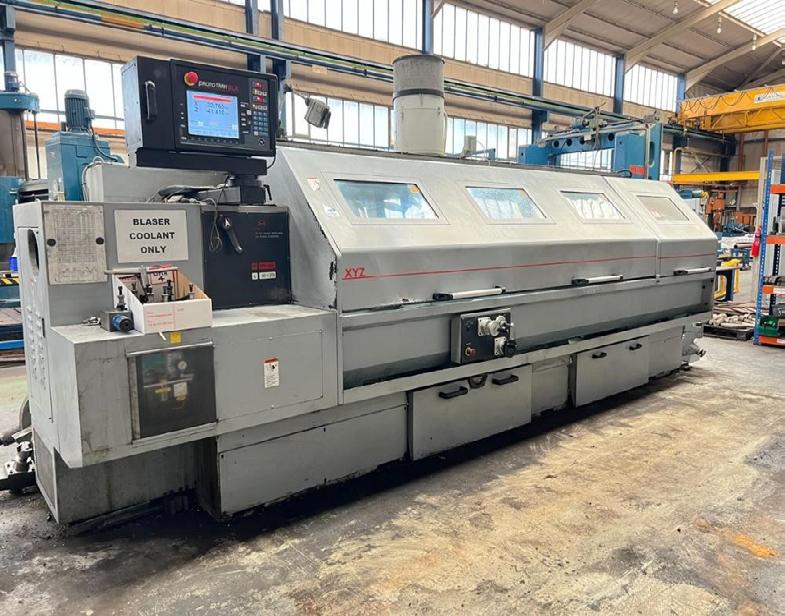
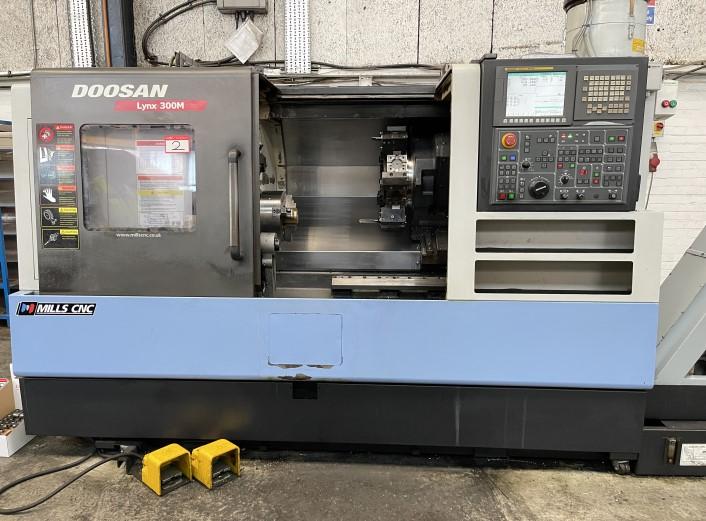

·Fixed Tooling suitable for Doosan Lynx 300M
·Eppinger Preci- Flex Adaptor for Fixed Tool Holder on Doosan Lynx 300M
·Harrison Alpha 1550 XM Gap Bed CNC Lathe
·Filtermist FX7002 Oil Mist Extractor on Floor Stand
·XYZ SLX 555 3M NC Gap Bed Centre Lathe
·XYZ VMC Vertical Machining Centre
·Kryle VMC 535F Vertical Machining Centre
·XYZ 250 TC LT CNC Lathe (2008)
·Noble and Lund Plano Bed Milling Machine
·Sanco SM-4000G CNC Bed Milling Machine
·ORT RP 75 Thread Rolling Machine
·Colchester Mascot 1600
Gap Bed Centre Lathe
·Bridgeport Turret Head Milling Machine
·Butler 8" Precision Slotting Machine
·Asquith Radial Arm Drilling Machine
·Plus Many Others...
Full Information
Website: www.cottandco.com
For
please visit our
Online Auction Sale
Encirc and Diageo announce hydrogen powered furnace to change the face of UK glass manufacturing industry

Encirc, a leading glass manufacturer and co-packer, and Diageo, global leader in premium alcoholic drinks, have today announced their partnership to create the world’s first net zero glass bottles at scale by 2030.
Encirc, a Vidrala company, plans to build a new furnace at its Elton plant,
Cheshire, which will change the face of glass.
The furnace will:
• Reduce carbon emissions by 90%, with an energy mix of green electricity and low carbon hydrogen.
It is expected that carbon capture technology will capture the remaining carbon emissions by 2030
• Be powered by zero carbon electricity and hydrogen, from the Vertex (HyNet)plant in Cheshire
• Be fully operational by 2027
• Produce up to 200 million Smirnoff, Captain Morgan, Gordon’s and Tanqueray bottles annually by 2030
Encirc is already a leader in sustainable glass production and future-proofing the future of glass. In 2021, Encirc, in collaboration with glass industry partners Glass Futures, trialled one of

RFiD Discovery energises its industrial RTLS tracking solutions with acquisition of UWINLOC
RFiD Discovery is pleased to announce that its parent company Paragon ID has acquired UWINLOC, an award-wining French provider of indoor and outdoor tracking solutions which use their pioneering energy harvesting technology to deliver systems with batteryless Ultra-Wideband (UWB) tags and minimal infrastructure.
The acquisition will enable RFiD Discovery to enhance its asset and inventory tracking solutions for industrial markets with a Real Time Location System (RTLS) which eliminates the need for tag batteries. This will allow the company to offer more environmentally friendly real-time tracking solutions at a lower cost without compromising on location accuracy.
Bringing down the cost of realtime tracking technology
Based in Toulouse, France, UWINLOC was founded in 2015 with the goal to provide integrated IoT technology for smart and efficient management of assets and inventory in warehouses and outdoor storage areas. With over 30 customers and a presence in five countries, the company provides accurate real-time location solutions using forklift mounted readers and eliminating the need for fixed

infrastructure.UWINLOC holds over 20 patents including those centred around energy harvesting technology to enable UWB tags to function without battery. This means that UWB tags can be provided at a substantially lower cost, making accurate tracking technologies feasible for a wider range of items including lower value inventory and assets.
Integrating functionality
UWINLOC’s MahVis system for the location visualisation of materials handling processes perfectly complements RFiD Discovery’s existing product offering for the industrial sector.
The plan is to integrate the MahVis solution with RFiD Discovery’s existing TrackSphereTM software, a complete Iocation-tracking platform, able to support all available technologies and provide solutions suited to a wide spectrum of industrial applications.
Company News 22 Manufacturing & Production Engineering Magazine
its furnaces in its Northern Ireland plant on sustainable biofuels on many brands including Diageo’s Black & White bottles, using 100% recycled glass to create the most sustainable bottles ever produced. The bottles had a carbon footprint of up to 90% lower than a standard glass bottle.
Decarbonising glass packaging will be a key part of the UK government’s commitment to reach net zero by 2050 and this is an example of UK leading companies partnering to be innovative in using green energy to manufacture at scale. The hydrogen used to power the new furnace will come from Vertex Hydrogen, a partner of the governmentbacked HyNet North West cluster – the UK’s leading industrial decarbonisation project.
Glass Futures, based in St Helens, is also playing a key role in supporting the glass industry’s decarbonisation and is a key partner for Encirc. It will be instrumental in trialling sustainable fuels on furnaces and developing the future furnace technology required to support Encirc and the wider glass industry in its goals.
Low-carbon alternative energy sources are an essential part of the solution for net zero. Hydrogen has the potential to be a crucial clean energy source for businesses and industries across the UK and global economies.
The use of the zero-carbon furnace will contribute towards Diageo’s commitments in its ESG action plan Society 2030 to reduce carbon emissions across its supply chain by 2030.
The resulting system will simplify the implementation of forklift tracking solutions.
TrackSphereTM was originally developed by Tracktio, a Spanishbased technology company, which through acquisition became part of RFiD Discovery in July 2022. The software, which is also available as Software as a Service (SaaS), is designed to be white labelled, no-code configurable and APIexpandable. It is ideally suited to applications within the manufacturing, construction, logistics and other industrial sectors and can use data from a wide range of tracking technologies such as active and passive RFID, Wi-Fi, GPS, BLE, LoRa, UWB, Quuppa and optical identification.
Over the past 15 years RFiD Discovery solutions have been adopted in many healthcare and industrial environments including by over 100 hospitals as well as a wide range of industrial businesses, in the UK, France and beyond.
Fisco UK partners with Apogee to expand its facilities management offering
Apogee’s Affinity+ Partnership programme unlocks new revenue streams for Fisco UK, providing its extensive client base with industry-leading uptime and IT service excellence.
Facilities management company, Fisco UK, has partnered with managed workplace services (MWS) provider, Apogee Corporation, to expand its IT offering and provide a more integrated and automated solutions portfolio to its client base. Through the partnership, the firm has successfully boosted machinery uptime for its clients by 28% compared to its previous MWS supplier.
The partnership, which is part of Apogee’s Affinity Partnership Programme, sees Fisco UK incorporate managed print services (MPS), managed IT services (MITS), and outsourced document services (ODS) into its expansive client offering.

A strategic cost-reduction business with clients in industries spanning manufacturing, professional services, warehousing, logistics, and more, Fisco UK turned to Apogee to strengthen and streamline its services. Previous supplier arrangements had resulted in poor IT management and a lack of cost transparency.
Apogee was selected as a MWS partner for its long-standing reputation of service excellence, along with its strategic alignment with the company’s ethos of competitive pricing, customer-centric support, and automated efficiencies.
The Affinity+ Partnership has been mutually beneficial, with Fisco UK gaining additional buying power, resources, and access to Apogee’s industry-leading 200+ strong engineering team. The company is also supported by Apogee-led training for its internal salespeople, as well as gaining a percentage of revenue from any successful referrals. In return, Apogee now benefits from access to Fisco UK’s diverse and growing client base.
Seamlessly integrating into Fisco UK’s established facilities management offerings, Apogee’s managed workplace services have transformed the client experience. With access to unparalleled service excellence, complemented with fully supported HP technology, customers have seen a dramatic increase in uptime without any physical footfall throughout the estate. One client with 45 multifunctional devices even reported just four remote calls to Apogee – with each one resolved remotely within four hours, giving the fleet a remarkable uptime of 98%.
23 Manufacturing & Production Engineering Magazine Company News



A PREMIUM CHAIN SOLUTION FOR HIGH DEMAND DRIVES A new Chain for the UK market offering a premium solution with three times the performance for wear resistance, fatigue resistance and high speed performance of comparable Roller Chain. Designed with unique pin coating, optimised plate geometry and high precision stamping, the X³ Roller Chain delivers significantly reduced maintenance downtime and longer service life. Available from Approved Product Partners and Stockists. donghua.co.uk/X3-chain 1 6 2 5 3 4 Optimised plate shape 1 High press fit to guarantee maximum fatigue strength 3 Special heat treatment and surface-coated pins give exceptional wear life 4 Seamless bushings & rollers throughout 5 High performance pre-lubrication 6 Calibrated pin and bushing holes 2 DOWNLOAD THE NEW X³ CATALOGUE Tube Tel: 01902 866200 Donghua Limited Sidings Close Wednesfield Way Wolverhampton West Midlands WV11 3DR
Leading engineering company, Applied Automation UK Ltd, have signed a sole UK distribution agreement with Danish collaborative robotics specialists, Spin Robotics.
Founded in 2019 by two dedicated robotic entrepreneurs with over 15 years of experience in the robotics industry, Spin Robotics have developed affordable and easy to use plug-n-produce, endof-arm, screwdriving tools for assembly applications using collaborative robots.
Headquartered in Odense, the robotics capital of Denmark. The company has already sold their screwdriving solution to over 33 new
distributors throughout Europe in just five months, and are now looking to expand their sales in both the North American and Asian markets following a major investment and backing by REInvest Robotics.
Esben Hallundboek Ostergaard, Chief Executive Officer (CEO) at REInvest and former co-founder of the leading Danish robot manufacturer Universal Robots, stated: “Over the years, I have visited many manufacturing companies throughout the world and have often seen the need to automate one-sided repetitive assembly work, including screwdriving tasks. Spin Robotics have
Company
developed the right solutions for this, by achieving increased quality and less wear and tear on the assembly worker in a way that is both safe and flexible.”
David Rowe Managing Director of Plymouth based Applied Automation is delighted to add Spin Robotics solutions to its growing range of high-quality industrial automation products which are supported and sold through its Technical Distribution Division based in Cardiff.
For more information contact: Applied Automation (UK) Ltd, Technical Distribution Division on 02920 494551 or mail: sales@x-stk.com
Rushlift wins massive £45m extension to Saint-Gobain UK & Ireland contract
Rushlift, the national full-service provider of materials handling equipment (MHE), has secured a major three-year extension to its successful, long-running MHE contract with the UK & Ireland business of international building solutions and materials manufacturer and supplier, SaintGobain. At the end of the threeyear arrangement Saint-Gobain (UK&I) has the option to further extend the contract by two more years.
The new £45m deal continues an existing 10-year agreement with Rushlift to supply, manage and maintain Saint-Gobain (UK&I)’s materials handling fleet across its sites including distant locations such as the Shetland Islands, Isle of Man and Jersey. In total over two thousand mixed-fleet assets will continue to be managed by Rushlift across some 850+ manufacturing and merchant sites operated by Saint-Gobain (UK&I) brands such as Jewson, JP Corry, British Gypsum, Rencol, and many more.
As under the existing contract, Rushlift will supply, maintain and support a wide variety of forklift trucks of different manufacture, along with related industrial equipment – from counterbalance trucks, telehandlers, and reach trucks to loading shovels, powered access platforms and floor cleaning equipment. All vehicles will be regularly serviced under a
set maintenance regime, with fast breakdown response and support.
Ian Berrill, transport & supply chain solutions director for Saint-Gobain (UK&I) says: “Our customer service performance is absolutely vital to the success of our business and, for us, that means having a forklift truck fleet that we know we can depend upon.

“We need consistently high standards of maintenance and support across every site we run.
“Over the last ten years, Rushlift has proved to be a reliable partner, maintaining and upgrading our fleet to match our service SLAs and working closely with us to help achieve our environmental targets. With this contract renewal, we have every confidence that Rushlift will continue to deliver the dedicated service and total support that we need to run our business.”
Tom Welland, account director at Rushlift, commented:
“We are delighted that Saint-Gobain (UK&I) has again recognised Rushlift as the best-value solution provider for their MHE needs.
“This is a significant endorsement of our continued commitment to driving service improvements, fleet performance and uptime across Saint-Gobain (UK&I)’s materials handling operations. Securing a major extension to one of the largest MHE contracts in the market makes us extremely proud.”
As an experienced supplier of counterbalanced and warehouse forklift trucks, Rushlift is able to source the best-suited industrial equipment for the task by accessing back-to-back supply chain agreements procured by Saint-Gobain (UK&I)’s central transport team.
Founded in Bishop Auckland in 1978, Rushlift has grown to become a nationwide materials handling service operation with five sites located across the UK – from Cornwall to Aberdeen, and throughout Ireland – employing over 200 people. The business now offers forklift contract hire, shortterm rental, new truck sales, and reconditioned equipment, along with full nationwide service engineering, maintenance and parts support. A separate division, Rushlift GSE, provides ground support equipment, financing and servicing for some of the UK’s largest airlines.
For further information on Rushlift go to www.rushlift.co.uk
25 Manufacturing & Production Engineering Magazine
Applied Automation UK signs sole UK distribution deal with Spin Robotics News
Electricity: Spot that leak, monitor it to avoid costly shutdowns
Unfamiliar with the term leakage (residual*) current ? This is the current that leaks to earth from live conductors and electrical equipment. Leakage current is an indicator of the health of an electrical system (heartbeat / pulse). Increases in leakage current indicate developing problems with the electrical system and or electrical equipment - an early warning!
In the production environment, leakage current problems are normally associated with a fuse, circuit breaker or residual current device tripping and disconnecting the electrical supply. Why wait until the production line has stopped? You do not for example wait for pressure to exceed a critical level and shut down the production, you monitor it constantly. So why not monitor electrical leakage?
Production Line Management
Efficient and effective production is synonymous with the health of the production line. We monitor changes in temperature, vibration, pressure, sound etc to identify developing issues. Enabling early assessment and maintenance scheduling i.e. predictive maintenance. The cost benefits of monitoring leakage current (Residual Current Monitoring), compared to the cost of lost production due to sudden power loss, damage to electrical equipment and personal safety are easy to quantify for individual sites.
Main reasons for not monitoring leakage currents:
1. Unaware - acceptance of lost production due to electrical issues.
2. Aware - but did not know how to monitor, solve the issue.
3. Issues of an electrical nature passed to the electrician to deal with.
4. Limited knowledge of complex leakage currents associated with modern production
Managing leakage currents
All electrical systems will leak electricity to earth, this is unavoidable.
This is due to the nature of electricity and electrical insulation. Leakage currents associated with electronic equipment such as speed control invertors, EMC filters, motion control for positioning and robots, are significantly higher in value than conventional electrical equipment and more complex. This requires specific types of monitoring and residual current protection device. Increases in operational leakage current above the norm (design level), indicate a change in electrical insulation quality e.g. a developing fault in electrical equipment, motors, EMC filters, cabling, junction box.
Periodic electrical inspections, including simple insulation tests give a basic snapshot of the electrical health of the production line at the time of the tests. The electrician completes these tests with the power switched off.
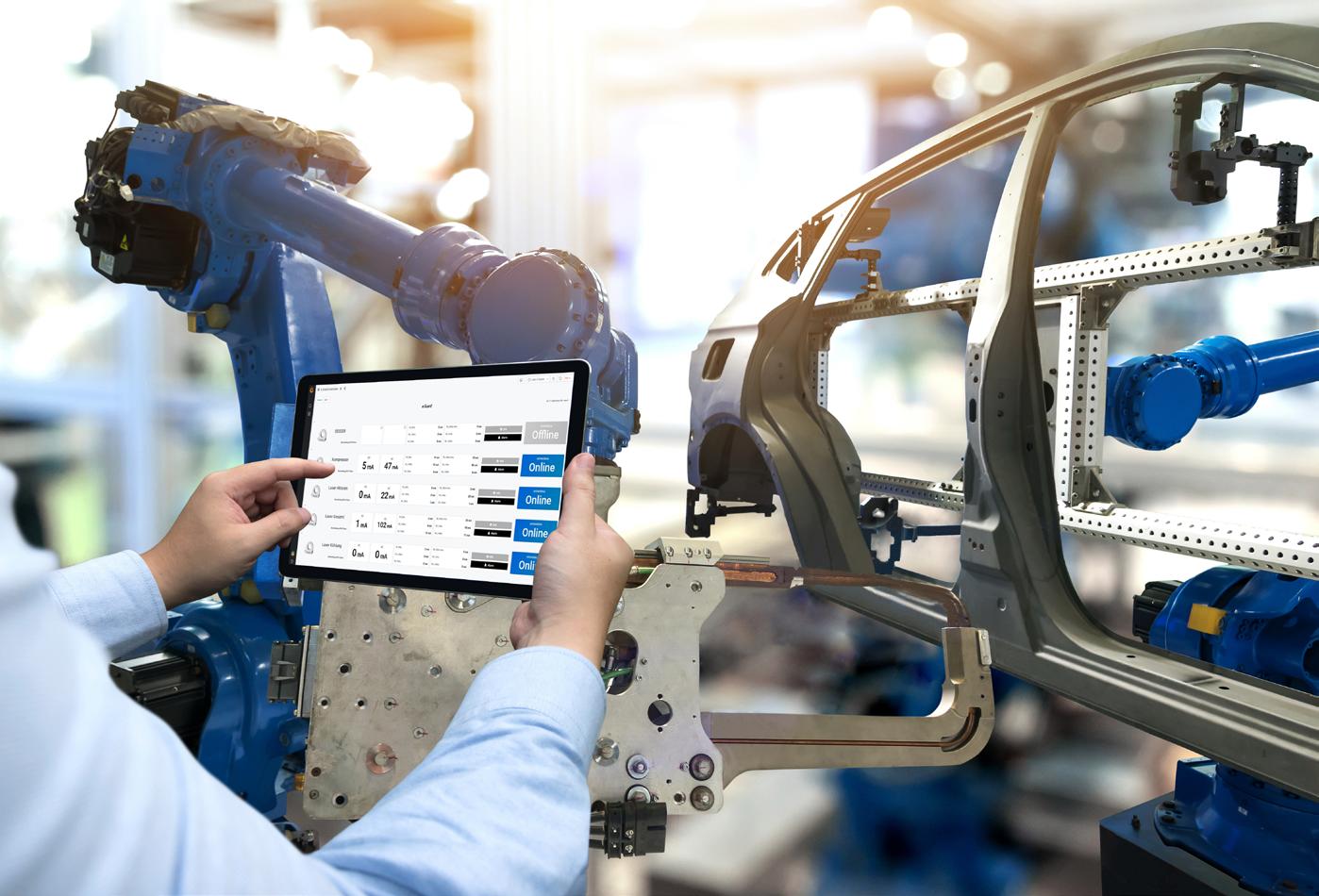
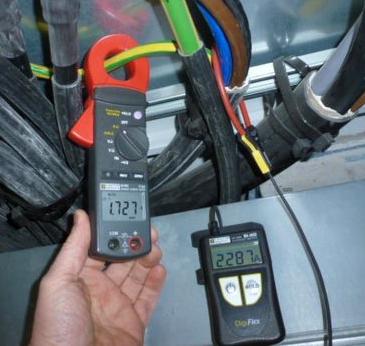
Consequently they do not reflect what is happening when the production line is running or between tests.
In this example picture, total production line supply leakage current measured with a clamp meter is 20A i.e. the sum of all the individual leakage currents associated with the production line running. Questions to ask: Is this normal? Is it higher or lower than last week, yesterday or has it just increased by 25% in the last few minutes? What is the distribution of the leakage current associated with individual manufacturing cells, robots ? Is there a developing problem which will result in a protection device tripping, leading to a partial or complete production stoppage?
26 Manufacturing & Production Engineering Magazine
Measurement, Sensors & Monitoring
You might kick the electrician when the production line stops, but that is tantamount to beating the horse because the cart broke.
Intelligent production line management and monitoring

Developments in predictive maintenance, associated with shared data, IIoT, ML, AI (Industry 4) at the top end, are enablers for high level management and control through condition monitoring and installation forecasting regarding future installation behaviour. Existing production line automation may not fully embrace the Industry 4 benefits, without major upgrades to hardware and software.
Product developments such the e. Guard residual current monitoring system from Doepke, enable the adoption of a fully scalable bundle, with 5 levels of performance:
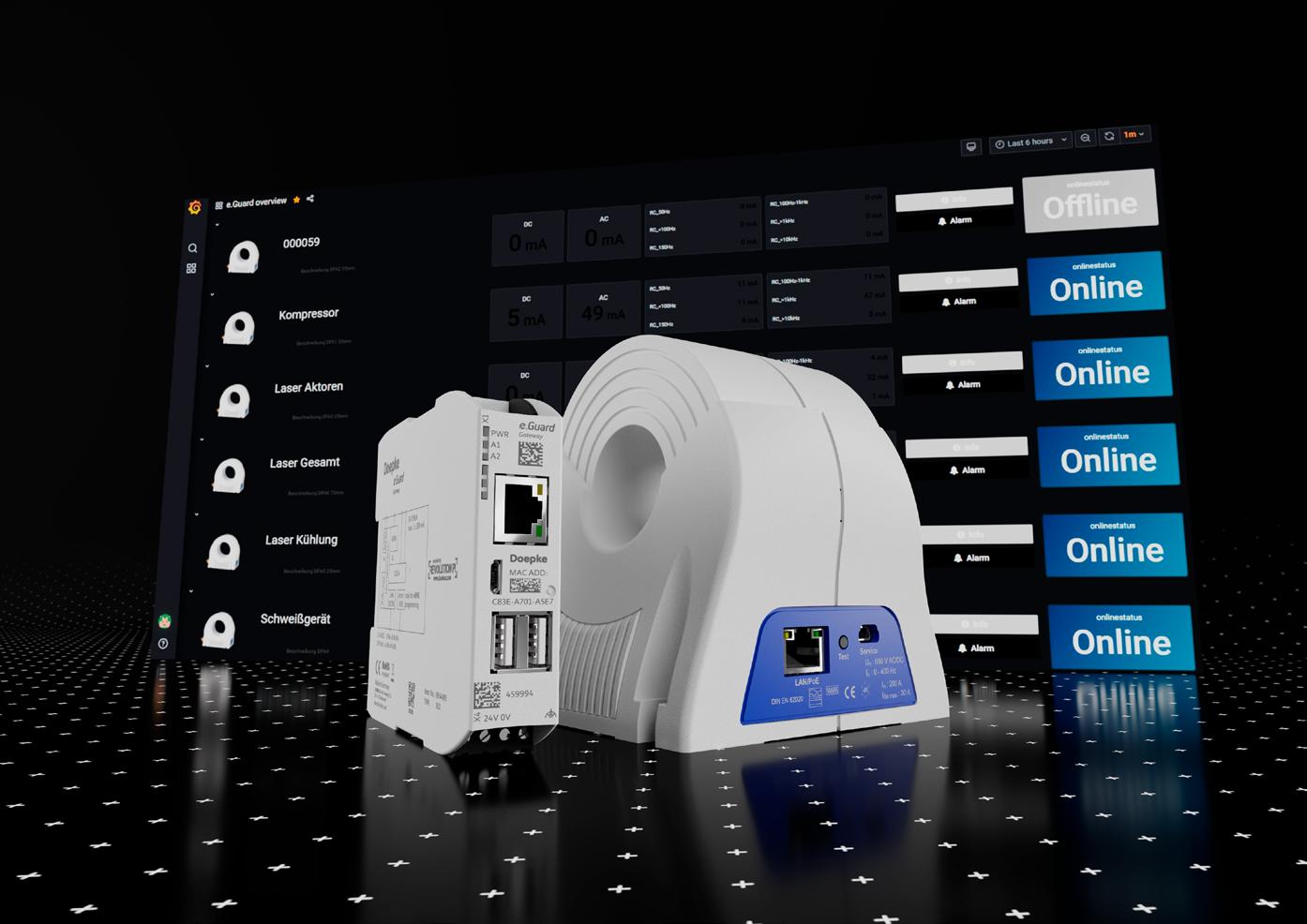
Basic Level 1, using free Doepke software enabling clear visualisation of the complex leakage currents within a system, offering evaluation and monitoring of < 20 RCMs on a PC, plus alarm email messaging.
Moving through the levels adds additional features e.g. Level 5 –bespoke software incorporating machine learning, customer meta data, hyperparameters, developed
in conjunction with the Customer’s Engineering and IT project team.
e. Guard (from Doepke The residual current protection expert)
e. Guard permanently monitors the residual currents in electrical installations and therefore offers comprehensive surveillance of their status. Smart residual current sensors positioned at critical points in the system, manufacturing cells and or items of equipment, enable the early identification of issues within specific locations.
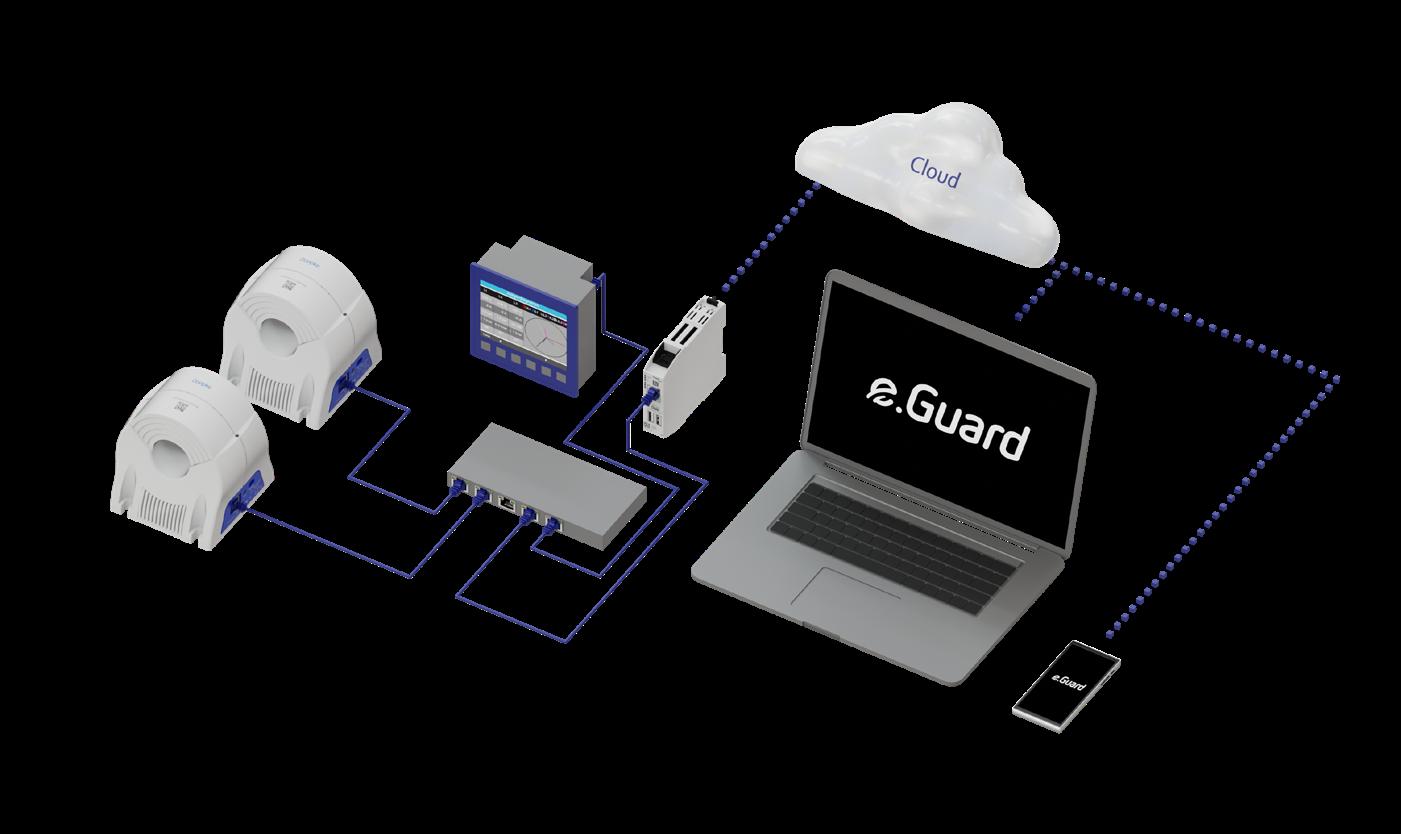
This results in timely and planned intervention by electrical staff to conduct essential checks and repairs. The aim, reduce downtown, catastrophic equipment failures and associated production line losses.
For further information please contact Doepke on sales@doepke.co.uk.
27 Manufacturing & Production Engineering Magazine
Measurement, Sensors &
Monitoring
*Residual current is the difference between the current flowing into and out of a circuit.
i.e. the difference is the amount of current leaking to earth.
QSigma chooses high speed, compact 3D laser profile scanner from Micro-Epsilon to measure wire diameter of coil springs
QSigma GmbH, a supplier of optical measurement solutions for industrial applications, has chosen 3D laser profile scanners from Micro-Epsilon for use on its Spring Measurement Solution (SMS), a measurement system for precise 3D measurement of coil springs and other manufactured components.
The SMS is used, for example, in the development of spring
prototypes and for 100% inspection of series produced parts. The SMS automatically identifies the spring, evaluates the wire contour and determines the wire diameter, even if the spring geometry is subject to strong fluctuations. For comparative evaluations, an automatic centreline determination is performed. The resulting data can then be analysed and compared with a stored target geometry. Non-contact sensors from Micro-Epsilon are used in these high precision measurement tasks.
Converts data into 3D point clouds
The SMS is a compact measuring cell in which the spring to be tested rotates on a longitudinal axis. During rotation, two linear axes move a scanCONTROL 2950 laser profile scanner from Micro-Epsilon over the part in the horizontal and vertical directions. To achieve maximum accuracy, the sensors are optimally positioned using algorithms developed by QSigma. The laser profile scanner transmits the generated individual profiles to a computer via a Gigabit Ethernet interface, which converts the data into a 3D point cloud and displays it on a monitor.
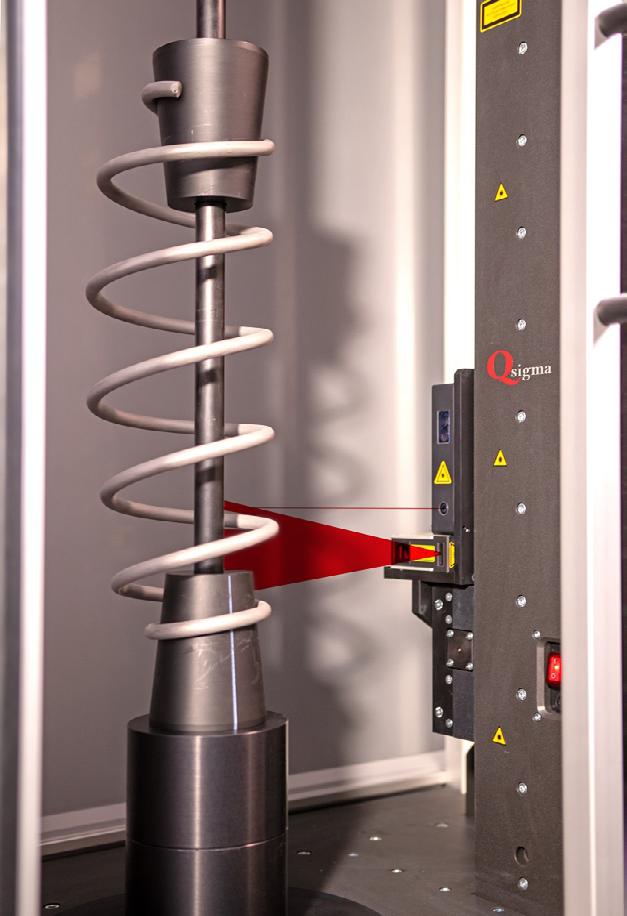
The scanCONTROL 2950 laser profile scanner has a large measuring field in both the Z- and X-axis. This enables extremely high speed scanning of springs up to a height of 70 cm and radially up to 30 cm.
Sensors on track to meet the demands of rail expansion
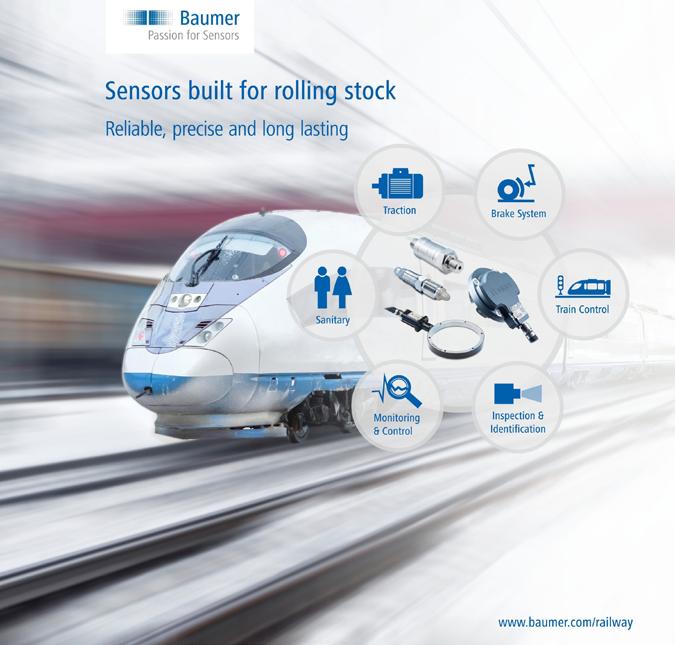
The growth of rail transportation and rail travel is becoming increasingly important to the UK’s infrastructure network with current passenger and freight volumes predicted to double by 2050. Experts believe this mode of transportation can be a sustainable
alternative to short-distance air travel while increasing freight via rail would complement other transport modes. Recently completed projects and those currently being constructed in the UK such as; The Elizabeth Line, HS2, East West Rail and The Great Northern Rail project, are all examples of the major investment in the rail network.
These projects, both current and future, coupled with the demand for increased automation present significant challenges to engineers to provide the most sustainable, reliable transportation systems. Sensors and encoders are among the essential components for these systems and sensing and instrumentation specialists BAUMER are well positioned to deliver the most effective solutions.
From innovative axle encoders, precise pressure and level sensors, to high speed cameras, Baumer has over 50
This wide field combined with the scanner’s high point density and profile capture rate (up to 1,000 profiles per second) enables precise evaluation of the spring geometry and wire diameter. Due to the large Z-axis range of the scanner, both the spring path and the spring end can be detected automatically. As the scanCONTROL 2950 works almost independently of the surface type, even painted or powder-coated springs can be measured reliably.
For more information visit www.micro-epsilon.co.uk
years’ experience of designing sensors for the railway industry. This is underlined by delivering products which conform to EN 50155 standards, TSI certification along with providing the highest levels of customer service and engaging in the close partnerships required to deliver the best sensor solutions.
Specific products and applications include; LBFS point level switches for sand box level monitoring which provide suppression of contamination to ensure reliable level detection and avoidance of false detection, PP20R pressure sensors for coolant control in converters and transformers which ensure low temperature drift and accurate level measurement from start-up to full load operation. 4 circumferential pressure balancing openings ensure that these sensors provide safe and reliable performance even in dusty and humid environments. Furthermore, they can operate across a temperature range of 125ºC to ambient ensuring effective sensing of almost any liquid cooling cycle on rolling stock.
More at: https://www.baumer.com/ gb/en/solutions/railway-industry/a/ rolling-stock
Measurement, Sensors & Monitoring News 28 Manufacturing & Production Engineering Magazine
Smart sensor company Pressac helps major car manufacturer make significant energy savings
Leading UK smart sensor manufacturer Pressac has helped car company Toyota more than double its energy cost savings.
Energy monitoring sensors, which measure how much power is flowing through a cable, have helped the company discover exactly which parts of its production processes are using excess energy. The information will play a huge role in Toyota’s goal of becoming carbon neutral by 2050.

Around 300 of Pressac’s wireless current transformer (CT) clamps have been installed at Toyota’s manufacturing plant in Burnaston, Derbyshire. By clipping them around individual cables, the company were able to see, for the first time, how energy was being used at machine level.
Pete Burbidge from Pressac explained: “The clamps gave Toyota the ability to view the energy consumption of each piece of equipment, and its condition, in real time. By monitoring the currents passing through them they could identify whether they were operating at their optimum level, as well as spotting areas where machines had been left on unnecessarily. The size and scale of the site meant they needed an easy-to-install, cost-effective solution
with a strong signal that could cover the expanse of the site.”
Previously, the company had been able to view energy consumption at transformer level but did not have the granular detail about each piece of machinery – information which is already making a big difference.
In the case of one injection moulder, which was identified as ticking over at a high power level, changes were able to be made which have resulted in its energy consumption in non-production periods being reduced by 82%.
Pressac worked with ESCO, the Energy-reduction Support and Collaboration function of Toyota to set up initial data visualisation.
Graham Lane, ESCO Group Leader, said: “We’ve been extremely impressed
with the ease of installation and the lack of ongoing maintenance needed. There was no production downtime when they were installed and the beauty of the sensors themselves is that we don’t have to worry about their maintenance, we can just install them and let them do their job.”
The sensors, manufactured at Pressac’s Nottingham headquarters, transmit their data wirelessly to Toyota’s existing building management systems via MQTT, a common Internet of Things protocol.
Graham added: “If we look back five years, small improvements may not have been as impactful as they are today. All energy consumption savings are taking us a step further towards our carbonreducing ambitions.
“Current energy costs also means that little interventions can have hugely beneficial results. Going forward we’d like to have every single piece of kit covered, to give us a complete model of the whole production process and identify where we can make even more energy savings.”
Pressac also supplied the company with air quality sensors to help ensure the production zones provided the optimum conditions for team members to work in.
Don’t forget to maintain and calibrate… your machine monitoring systems
Monitoring the performance of large rotating plant is an essential part of proactive maintenance helping to avert problems whilst prolonging the life and efficiency of plant and equipment. However, what about the servicing and calibration of the actual condition monitoring systems?
To provide the function, efficiency and true value, the monitoring systems themselves require regular calibration and servicing. For example, an incorrectly calibrated sensor may not provide the accurate alerts you need to replace wearing or faulty components in time to prevent downtime and may even invalidate your insurance.
Condition Monitoring specialist
SENSONICS offer not only a wide range of industry leading vibration, temperature, position and rotational speed systems for large rotary plant, they also provide calibration, servicing
and spares which will help you get the best value from your investment. Our UKAS traceable calibration and maintenance services can be applied to all sensors and monitoring equipment, either on-site or on a return-to-base service.
Our servicing options include on-site maintenance anywhere in the World, along with fully traceable, return-to-base repair carried out by experienced maintenance engineers with the required qualifications and approvals. This includes working on both military and nuclear sites.
Early addressing of minor issues can prevent these developing into major faults which can lead to disruptive unscheduled downtime, the associated unbudgeted expense, whilst reducing your equipment’s lifetime repair costs. Furthermore, planned servicing can help to increase productivity and ROI in addition to
keeping your monitoring system in-tune with the latest technological advances in hardware and software.
Thanks to over 50 years’ experience in supplying, commissioning and maintaining monitoring systems across a wide range of industries means Sensonics can provide an outstanding package of servicing, calibration and maintenance packages for all types of systems. More at: https://www.sensonics. co.uk/maintenance-support

29 Manufacturing & Production Engineering Magazine Measurement, Sensors & Monitoring News
Six ways smart sensors can drive manufacturing efficiency savings

Manufacturers can maximise energy and operational efficiency by using advanced Internet of Things ( IoT) energy insights sensors, advises Mike Cumby of Centrica Business Solutions.
Low cost IoT sensors are unlocking higher productivity and big energy savings across industry – providing a smart solution to hyper inflation, decarbonisation and operational efficiency.
By combining wireless sensor technology with advanced analytics software you’ll gain real-time insights. This enables you to optimise energy and operational performance across your entire site – right down to device and equipment level.
It works by simply clipping the wireless IoT sensors to your energy intensive assets at a circuit level and then analysing and visualising the captured data with an advanced energy management platform, such as our PowerRadar™ system.
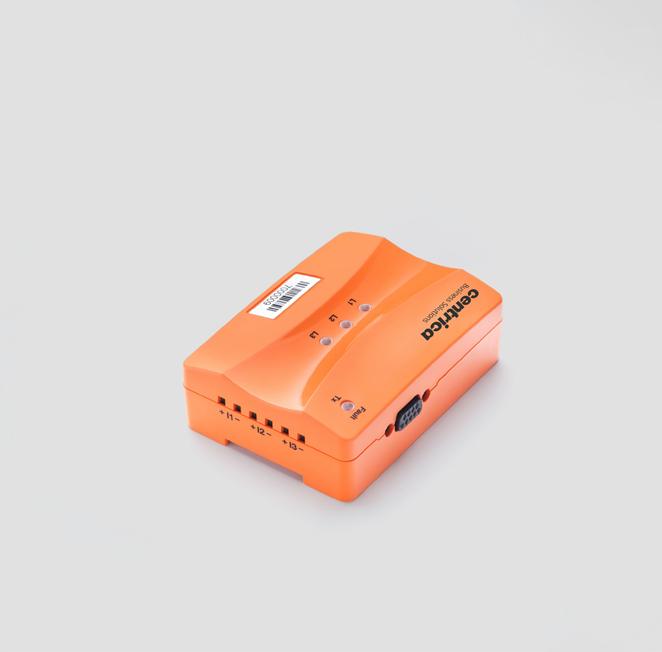
In this way, you have 360O vision of your site-wide power usage at the level of detail you require. It’s also possible to monitor gas, heat, air flow and water consumption, plus on-site generators, such Combined Heat and Power (CHP) and solar systems.
There are six ways manufacturers can benefit by applying sensor-driven energy insights across their site or multiple sites.
1. Detect energy waste to drive efficiency and cost savings
By understanding what’s happening beyond your metered data at a device and process level you’ll identify hidden energy waste and drive efficiency improvements that can relieve rocketing bills. For example, you may identify unnecessary out-of-hours consumption, idling equipment, incorrect operation timetables, or opportunities to improve compressor cycling or production/ process line sequencing. You can also benchmark against other comparable sites or areas to detect anomalies and drive best practice.
IoT energy insights can also inform and influence employee behaviour change to further improve energy performance.
Altex Group is using our IoT sensors and analytics platform to achieve annual CO2 emissions savings of 53,553 tons, while also cutting energy costs by 8%.
Savings in action
Textile manufacturer Pincroft is using our smart energy insight technology to reduce weekend energy spend by 94% and weekday spend by 29% – putting the company on track to achieve annual CO2 savings of 648 tonnes. The project, which uses sensors to capture realtime energy data from over 100 critical energy-consuming assets, provided a payback on investment in just 3 months.
Plastcoat, a division of Magna International, is using our technology to save nearly $2 million on its annual energy bill, while also improving predictive maintenance, operational efficiency and productivity.
2. Improve operational efficiency
With on-demand access to real-time equipment and process performance data you can gain new insights into operational improvement opportunities. In many cases, the resulting operational cost savings are higher than the energy savings.
For example, our customers are using energy insights to detect air leaks from compressors and to diagnose performance issues with cooling equipment or production lines. The technology can support verification of manufacturer default settings and equipment controls, while also tracking operational trends from adjusting equipment controls in real time.
30 Manufacturing & Production Engineering Magazine
Measurement, Sensors & Monitoring
Dramatic results
Global cement and asphalt producer CEMEX used our IoT analytics to make a £211,383 saving at just one location. By examining real-time energy usage of critical energy intensive machinery the company identified that a conveyor motor was not working properly, which was creating a process bottleneck. Further cost savings have been made by identifying and eliminating unnecessary out-of-hours energy use.
3. Predict equipment failure and trigger maintenance protocols
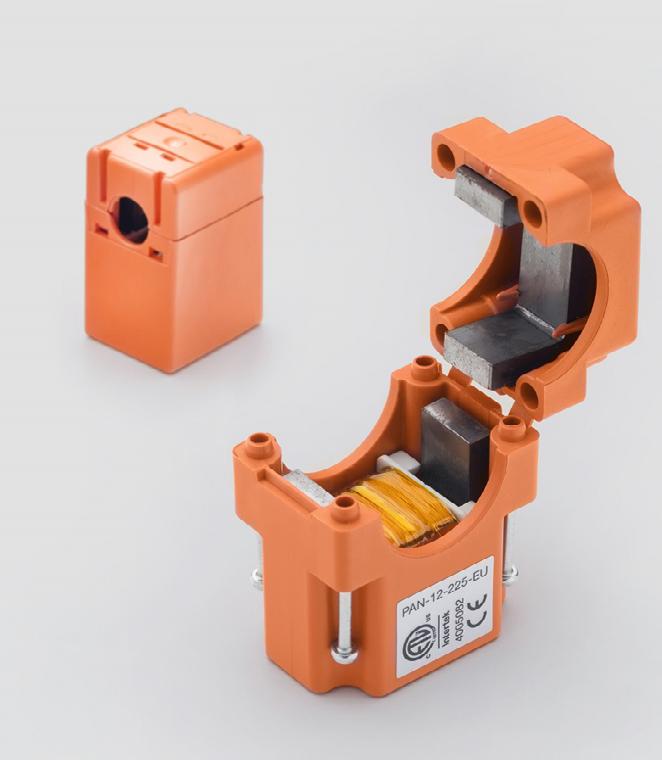
Energy analytics software can detect anomalies and faulty equipment or process vulnerabilities that could affect output or product quality. Smart technology also makes it easier to transition from scheduled maintenance to predictive maintenance – using 24/7 alerts about potential issues so they can be prevented before they become points of failure. In this way, the smart
technology can reduce downtime, increase productivity and extend asset life.
4. Decarbonise your business
An additional benefit of improving energy and operational efficiency is the carbon savings this delivers – helping you to achieve your net zero ambitions cost effectively. In this way, manufacturers can also get ahead of increasing environmental regulation and carbon taxation, while meeting the sustainability expectations of customers, employees, investors and other stakeholders.
Altex shrinks carbon footprint
Altex Group is using our IoT sensors and analytics platform to achieve annual CO2 emissions savings of 53,553 tons, while also cutting energy costs by 8%. Wireless sensors were used in each production facility to capture energy consumption data of critical assets, such as air compressors, refrigeration equipment, cooling towers and evaporators.
It was revealed that a 4% reduction in energy consumption could be achieved by using timers to switch equipment off during non-operational hours. A further 12% reduction in energy use was achieved by analysing and optimising the sequencing of compressor operation.
5. Make compliance & reporting easy
By shifting to a data-driven energy monitoring strategy, businesses gain a clear view of energy and carbon performance . Accurate data is available at the required level of detail to support increasing regulatory and legislative oversight of Scope1, 2 and 3 emissions.
Detailed data can also be collated across multiple sites and reports downloaded for environmental and fiscal reporting, for example to assist compliance with the Energy Savings Opportunity Scheme (ESOS) or Streamlined Energy and Carbon Reporting (SECR) and the new Taskforce on Climate-Related Financial Disclosures (TCFD).
6. Optimise and monetise energy flexibility
Use the data gathered from your wireless sensors to inform opportunities to use energy flexibly for cost reduction and revenue generation. Using this information, it’s possible to shift loads to avoid peak time power costs, such as Triad periods. Where there’s spare power capacity, you can generate an income from Demand Side Response (DSR) activities and other trading opportunities.

Manufacturer unlocks revenue
Our IoT energy insights technology underpins the flexibility and market optimisation strategy of a UK paper manufacturer. By capturing data from meter points, energy management systems and their CHP plant, the company has full visibility of site-wide energy usage and can identify efficiency and flexibility opportunities. We’ve also integrated this technology with our AI enabled utility optimisation platform to manage market opportunities and unlock significant revenue streams for the company.
Don’t miss out on savings
Despite the huge benefits of advanced energy insights, only 25% of businesses regularly assess their energy profile. This is a missed opportunity to use energy data to drive commercial, operational and environmental success.

31 Manufacturing & Production Engineering Magazine
com/energy-solutions/energymanagement/energy-insightssolutions Measurement,
Further information: www.centricabusinesssolutions.
Sensors & Monitoring
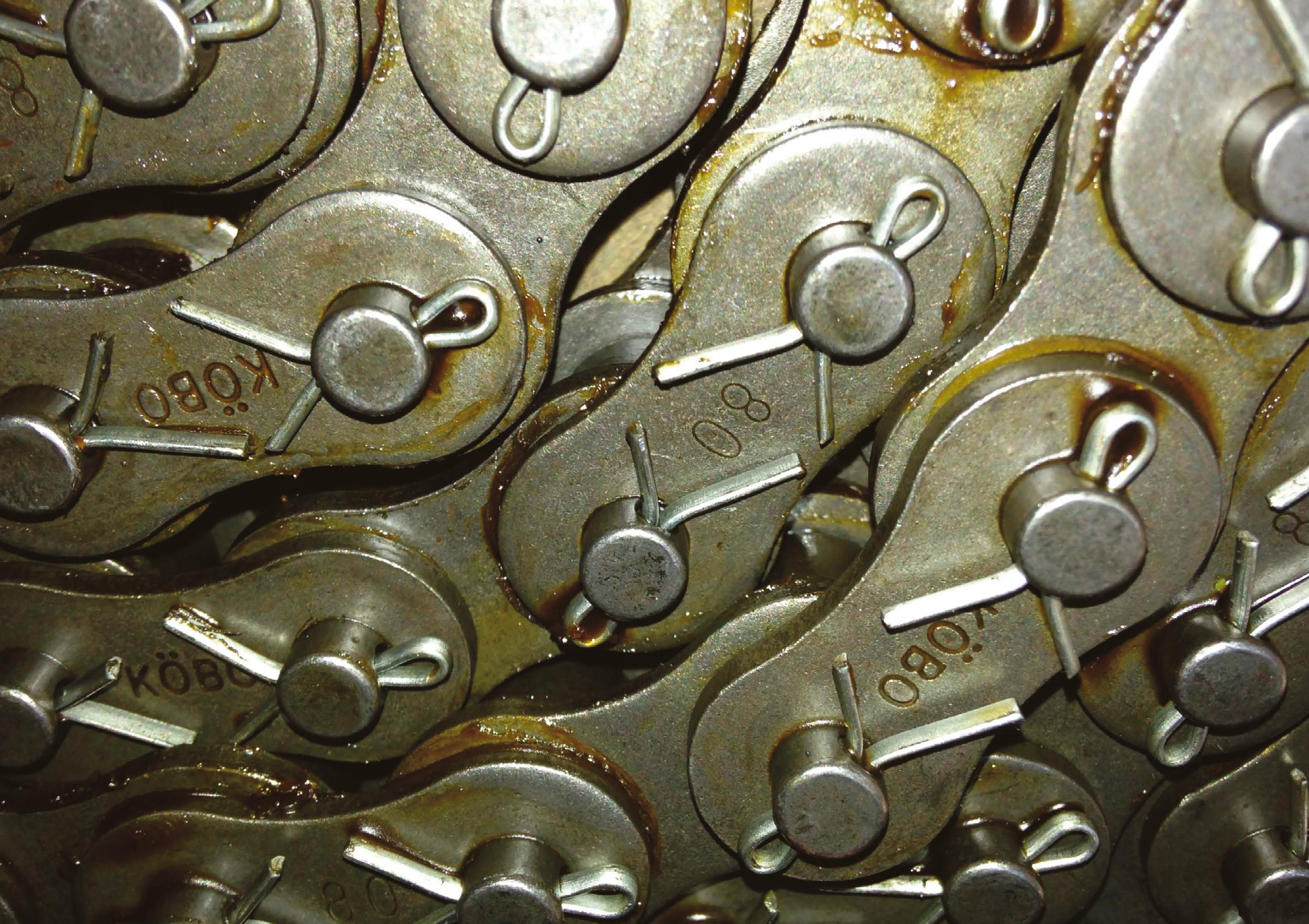


...THERE MUST BE SOMETHING SPECIAL ABOUT OUR CHAIN +44 (0)161 491 9840 info@kobo.co.uk www.kobo.co.uk 125 YEARS OF MAKING CHAIN
Machines & Machinery
Repeatability of Nakamura Puts Aerospace Subcontractor on Runway to Success
With more than 38 machine tools on the shop floor, Shannon Precision Engineering Ltd (SPE) is a major subcontract machining outfit on the Emerald Isle. With a worldclass manufacturing program that utilises systems like Kaizen, the SPE staff includes Six Sigma Black Belts and Lean Manufacturing Green Belts. To ensure production meets the stringent quality levels the company sets, it has recently invested in two Nakamura-Tome mill/turn centres, the WT150II and the SC100X2 from the Engineering Technology Group (ETG).
Located in Shannon, the 80 employee manufacturer is AS: 9100 and ISO: 9001 certified, and it frequently works on high-profile projects for Airbus, Lear, Bombardier, Collins Aerospace, Liebherr, Safran, Spirit and many other leading names in the aerospace, automotive, offshore, rail and power generation sectors. Machining everything from inconel, titanium, hastelloy, duplex and nitronic 40 and 60 as well as hardened steels, the stability and performance of its machine tools are of paramount importance. With the company winning a significant automotive order as well as major opportunities in the aerospace sector, SPE needed a new strategy in its mill/turn department.
Recalling the situation, Dominic Murphy, the Managing Director at SPE says: “On some projects, we have been struggling with repeatability
when machining particularly difficult materials. We won a contract to machine electro-mechanical connections for the aerospace industry from nitronic 40 and titanium, and we needed to be very responsive with our changeovers and lead times. With regular batches from 200 to 500 and up to 20 different part families in the series, the project has some very ambitious cycle time targets. With tolerances of +/-5 and +/-10µm on many features, we didn’t want to be chasing repeatability – we needed a more robust process than we had.”
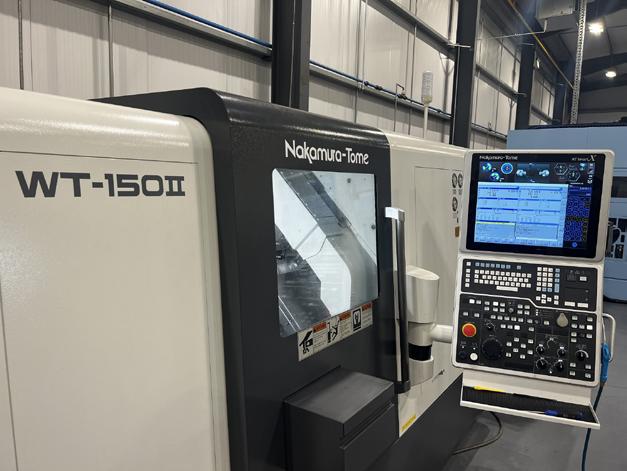

The County Clare company investigated the mill/turn market extensively and it was the Nakamura WT150II that won the day with cycle times more than 20% faster than its rivals. “We gave ETG and other vendors a series of components as a prove-out. ETG built a machine set up around the family of components and they delivered a turnkey solution to our facility that was best suited to our requirements. We already have a lot of mill/turn centres on-site, so the Nakamura-Tome WT150II wasn’t just about cycle times. We needed a turnkey solution that could meet our ambitious cycle times and tight tolerances with relentless repeatability for long batch production – the Nakamura-Tome WT150II certainly delivered on that. Unlike many machine tool brands, Nakamura is a specialist in mill/turn centres, their pedigree stands out. We really liked the compact work envelope as well as the ability to bar feed up to 71mm diameter, which gives us options on some of our larger components.”
The twin spindle twin turret turning centre provides 15/11kW and 11/7.5kW of power to the main and sub-spindle respectively. Complementing the spindle power are 5.5/3.7kW motors on the left and right tooling turrets
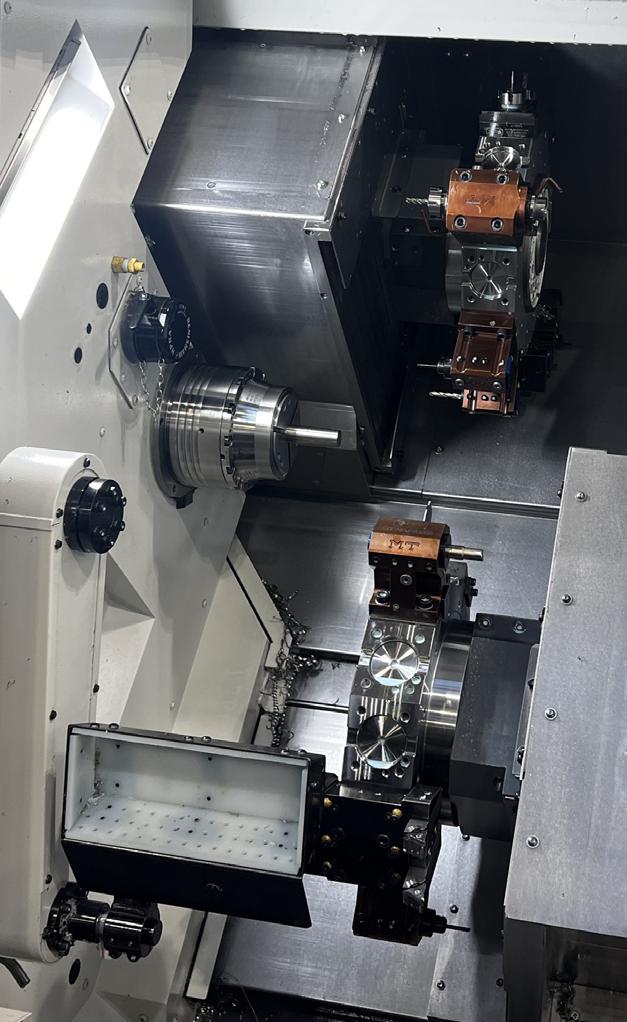
to provide high-performance milling capabilities. With simultaneous cutting on both the upper and lower tool turrets on opposing spindles, the WT150II provides balanced turning to drastically reduce cycle times.
What no one else has to offer
Whilst ETG Ireland Managing Director Jamie Fletchmore was visiting SPE, Dominic mentioned an extremely complex automotive part that required machining on three machine tools, a 4-axis HMC, and two single-spindle turning centres. With an annual output of 40,000 units, the forged automotive tensioning assembly component is permanently absorbing the capacity of all three machines. The solution was the Nakamura-Tome SC100X2.
Alluding to this, Dominic adds: “We’ve run this family of parts for more than 2 years and we have investigated the market for a solution on numerous occasions – without success. There just hasn’t been a machine on the market that can do the parts in ‘one hit’ - until now. The challenges have included the turning of two spindles on either side of the part that is 40-50mm off-centre. Added to this, we have to mill features that require longreach tools to overcome interfering features. ETG has overcome this issue with the SC100X2. It has cut the cycle time by almost 50% from 14 minutes to 7.26, but more importantly, it has freed the capacity of two single spindle turning centres and a 4-axis HMC whose capacity we desperately needed. We’ve reclaimed three machines and two employees and massively improved our throughput. We are delighted with both the new Nakamura-Tome machines.”
34 Manufacturing & Production Engineering Magazine
Considerations for effective cleaning-in-place (CIP) systems
By Matt Hale, International Sales & Marketing Director, HRS Heat Exchangers

The production of safe food and drink products is of paramount importance to producers and maintaining hygienic – in some cases sterile – production environments and equipment is a key requirement for modern food processing machinery. Apart from the simplest systems, most equipment today, particularly that which contains pipework, enclosed spaces and small apertures, is cleaned in situ without the need for dismantling or opening, and with minimal operator intervention – a technique which is known as Cleaning-in-Place (CIP).
Cleaning (or Clean) in Place has been around since the 1950s and can be defined as a method of automated cleaning of the interior surfaces of equipment, without major disassembly. One of the most widely quoted definitions is taken from the 1990 edition of the Society of Dairy Technology (SDT) Manual Cleaning In Place, which defines CIP as: “The cleaning of complete items of plant or pipeline circuits without dismantling or opening of the equipment and with little or no manual involvement on the part of the operator. The process involves the jetting or spraying of surfaces or circulation of cleaning solutions through the plant under conditions of increased turbulence and flow velocity.”
Design considerations for CIP
The main purpose of CIP is to remove physical dirt and residues, as well as bacteria. It is commonly used for equipment such as piping, tanks, and fillers, and CIP employs turbulent flow or spraying and can also be accomplished with filling, soaking and agitation.
As well as ensuring that production equipment is hygienically clean and suitable for use, CIP also plays a number of other important roles. CIP systems should ensure that no cleaning fluids or contaminants remain in the equipment – ensuring food safety, and by reducing the effort and downtime required for cleaning, they also ensure production cycles are efficient and cost-effective. Because of the automated or semiautomated nature of CIP systems, they provide improved control of the cleaning parameters to ensure consistent results,
as well as automatic record keeping for traceability and due diligence purposes. Furthermore, being automatic reduces the need for human contact with potentially harmful cleaning agents or other chemicals.
However, if CIP is to be effective, not only does the CIP system itself need to be well designed, but the production equipment itself needs to be designed from the beginning with effective CIP in mind. Equipment and machinery must be hygienically designed and easy to manage, maintain and audit. Because of the specialised and custom nature of much food and drink processing machinery, some CIP systems will be designed specifically for a particular system or piece of equipment, although with careful design it is not uncommon to install a dedicated CIP system, such as those available from HRS.
The design process must not only ensure effective cleaning but should also be as efficient as possible in terms of water, chemical and energy use. Considerations for the equipment itself include areas such as surface roughness, clean welding and the prevention of inaccessible areas or corners where dirt and/or cleaning chemicals may build up. Reliability is also an important consideration and CIP systems must be designed to work for as long as the working lifetime of the equipment involved. It is also important to consider how user-friendly the control systems for the CIP are. For example, are they part of the overall control interface or a separate system? Another key element of an effective system is monitoring and validation of the cleaning results for traceability and due diligence purposes, and from the beginning the design of the equipment should allow this to be done in an effective manner.
Typical CIP processes
• Most CIP employs a similar set of operations, including:
• Pre-rinsing – to remove large debris and residues
• Detergent cleaning – to remove attached dirt and soiling using a caustic detergent
• Rinsing – to remove detergent and dirt
• Optional acid cleaning – if required to remove scaling or alkaline residues
• Rinsing – to remove the acidic cleaning agent
• Disinfection – heat or chemical treatment to disinfect the equipment
• Final rinse – to remove all traces of chemicals and prevent contamination
These steps may be combined or used in different ways. For example, using detergent at high temperatures may clean and disinfect equipment at the same time, or using steam may reduce the need for chemical detergents. Depending on the design of the system, and the risk of contamination, cleaning solutions may be reused multiple times or discarded immediately. There may also be differences between CIP and SIP (sterilise-in-place) systems.
While the actual cleaning regime used will depend on a number of factors, including the risk category of the food or drink product, the physical and chemical properties of the product, and the design of the machinery in question, in many situations it is preferable to rely on water alone (together with temperature, pressure and agitation) rather than additional cleaning chemicals which could present a contamination risk. In general, the higher temperatures and greater kinetic energy provide more efficient cleaning, but the duration of the CIP cycle will be optimised according to the properties mentioned above.
Where detergents are required, one of the most common is caustic soda (NaOH), although many other alkali- and acid-based chemicals are available depending on the nature of the product and residues which need to be cleaned. Alkali materials are generally more effective against proteins and fats, while acids perform better where salts need to be removed. For sugars, water remains one of the most effective cleaning mediums.
35 Manufacturing & Production Engineering Magazine CIP Systems
Interview: Dr Michael Berger Interview
Manufacturing & Production Engineering (MPE) Magazine, speaks with DocuWare’s former CTO and now President Dr Michael Berger on best practices for digitalising in the manufacturing industry

Firstly, thank you for speaking with us, could you give us a brief overview DocuWare and the company’s main aims?
From manufacturing and retail to healthcare and government, DocuWare provides businesses with industry-leading digital document management and automated workflow software. We help over 15,000 companies worldwide to capture, route and securely archive their most important business information.
Our aim is simple: to simplify work by empowering organisations of any size to digitise and automate their own business processes.
How important is it in your opinion for digitisation to be considered more in the manufacturing industry?
I would say that the futuristic view and the willingness to invest in developing and applying new digital automation technologies have ensured many companies remain successful today.
Large global manufacturers were among the earliest adopters of digital process management solutions. But today, due to increasing competitive pressure, supply chain woes and a rapidly changing regulatory landscape, manufacturers need to up their technology game. Through technology, they can get to market faster, compete in global markets, and manage costs.
To achieve this, manufacturers of all types, from biotechnology and pharmaceuticals to metal fabrication and machine parts, need to automate production and administrative processes so they can be sustainable, work smarter, manage costs, and deliver better, faster results for their customers – and this can all be done through digitalisation.
36 Manufacturing & Production Engineering Magazine
I would say that the futuristic view and the willingness to invest in developing and applying new digital automation technologies have ensured many companies remain successful today.
- Dr Michael Berger
To stay one step ahead of the competition, time to market for a manufacturer of any size must be significantly reduced, all while continuing to follow strict reporting, compliance, and security standards.
- Dr Michael Berger
Talk us through how production can be streamlined to deliver faster results
In the early years of my career, I worked for one of the largest manufacturing automation companies in Europe where I saw first-hand the importance of digitising processes and also developed them. It is about digitising all manufacturing aspects, these being:
a) the digitisation of the automation design,
b) the automation and flexibilisation on the production side but also…
c) the digitisation and automation on the back office / administrative side including material purchasing, finance, quality control processes and human resource management.
To stay one step ahead of the competition, time to market for a manufacturer of any size must be significantly reduced, all while continuing to follow strict reporting, compliance, and security standards. This requires a more transparent document production software and work processes.
With technology such as document management and workflow automation, all documents pertaining to production are digitised and stored in a central archive. So, whether that is working with design drawings, material orders, production documents, sales orders or invoices, employees can access all documents 24/7 in the office or at home. These documents can trigger automated workflows. This streamlining of documents with workflows enables any manufacturing business to expedite production, reduce risk, and contain costs.
What are the main benefits of digitisation?
The greatest benefits and ROI are evident in many ways – but I’ll give two examples:
There is increased productivity and improved collaboration. Through digitising paper records, crossdepartmental exchange of information can happen easily. Once documents are reviewed or approved, workflows can be kicked off automatically and no bottlenecks are holding up the process. Document search and retrieval are straightforward, allowing
employees to work faster and more efficiently. When this happens, the work environment is better, and employees are happier.
Secure, compliant record-keeping is another key advantage. We have customers who manufacture precise components for no-failure industries such as the medical, airspace, and photonics industries. Government regulations mandate that these manufacturers retain documentation about the parts they supply for the lifetime of the product or instrument. A paperless, digitised document storage system means there is an enormous reduction in time, cost, and stress.
Do you think more companies are embracing and implementing these solutions?
We’ve seen a real shift in small and mid-sized manufacturers embracing these solutions. Without digitisation, employees waste time capturing, storing, and routing documents using slow manual processes. Those cost valuable time and money.
But now technology solutions, such as our cloud-based document management, are flexible, adaptable, and most importantly they are scalable and therefore affordable. Manufacturers of all sizes can now reap the benefits of digitalisation through automation, levelling out the playing field in ways we couldn’t have imagined back in 2019.
Do you feel that the pandemic increased/ changed views on digital solutions?
The pandemic forced businesses around the globe to transform faster than they could have ever anticipated. It required all types of businesses from small family-run shops to huge multinational conglomerates to invest in new tools to enable their employees to work remotely.
At DocuWare we saw first-hand a
surge in demand for cloud-based document management solutions and automation technologies, along with a specific interest in automating invoice processing tasks and better cybersecurity to enable employees to import, share, approve, collaborate, and store business documents.
Even as we almost reach three years since the first lockdown across many countries, the demand for these technologies continues to grow worldwide demonstrating that hybrid working, process automation, document management and digital transformation are here to stay.
How do you think digitisation in the manufacturing industry will progress in 2023?
It will progress because it is getting easier and easier, with very little downtime for the business during the implementation time frame. ECM solution providers like us, assume responsibility for implementation, system upgrades and security patches which makes it easier to scale and saves businesses from investing in more in-house IT resources. We expect the demand for technologies that digitise and automate processes to continue in 2023 and we look forward to helping more businesses realise their full potential.
Michael is President of DocuWare Group, where he leads research, product development, engineering, HR and finance. A technology leader and innovator, he is responsible for several additions to the DocuWare product portfolio such as DocuWare Cloud and Intelligent Indexing. Michael joined DocuWare in 2008 and his vision led the technology in the direction of cloud-based solutions. He became President in 2019. He holds a Ph.D in Computer Science, specializing in distributed and intelligent systems from the University of Dresden (TU).
37 Manufacturing & Production Engineering Magazine
Interview
We expect the demand for technologies that digitise and automate processes to continue in 2023 and we look forward to helping more businesses realise their full potential.
- Dr Michael Berger
Managing contamination risks in pharma settings
The importance of correct lubrication in pharmaceutical manufacturing
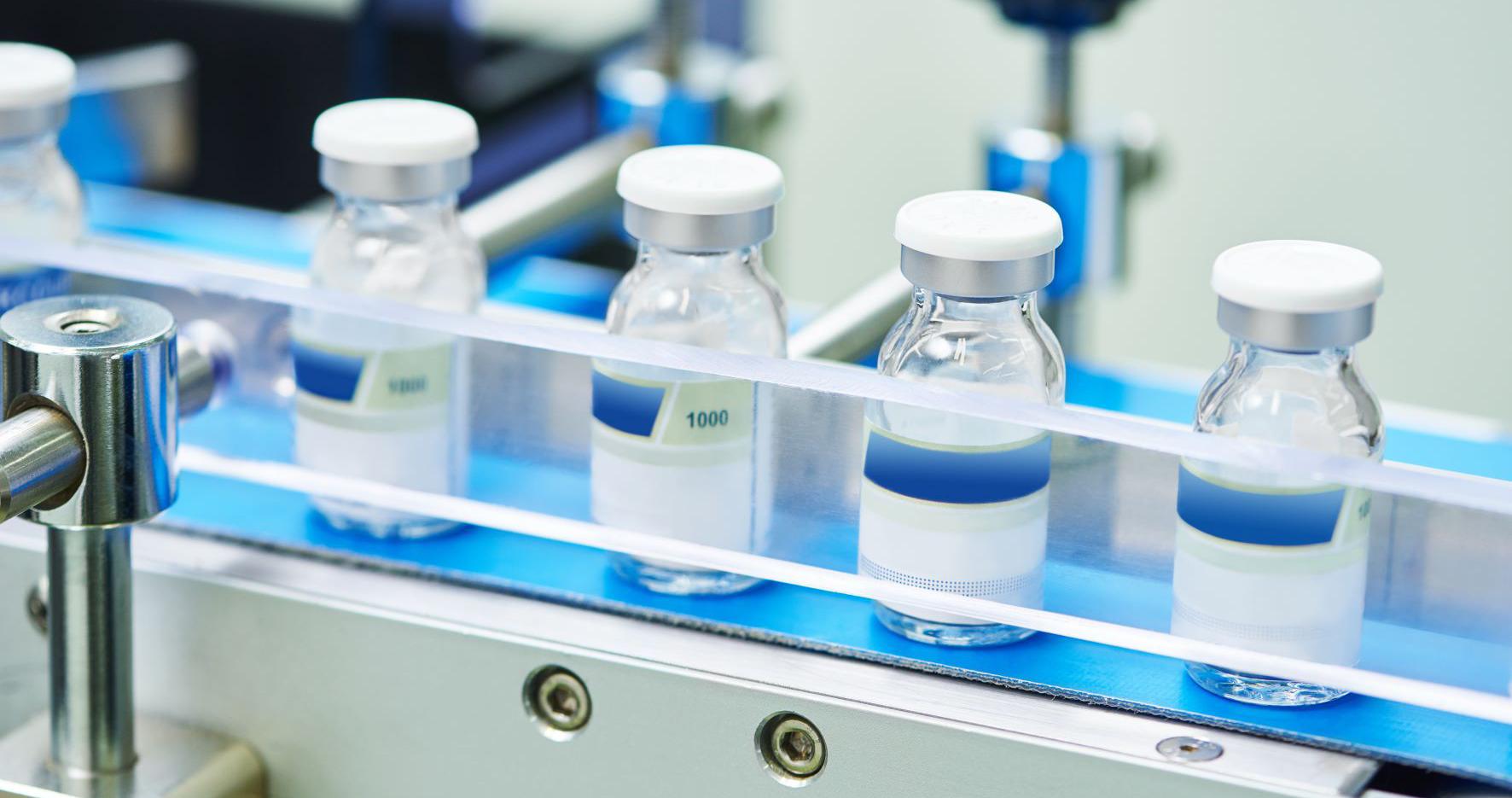
There’s more pressure than ever on pharmaceutical companies to meet production demand. Consequently, the global pharmaceutical market size is expected to reach USD 2,067.36 million by 2028, growing at a compound annual growth rate (CAGR) of 5.7 per cent during the period from 2022 to 2028. Here Chris Johnson, managing director at bearing lubrication specialist SMB Bearings, explains the importance of careful lubricant selection to manage contamination risks and boost drug output.
Drug shortages pose a significant threat to public health. As the global population ages and access to drugs increases, pharmaceutical companies face growing pressure to meet the production demands needed to provide critical care to patients. While it may seem like the obvious solution is to simply ramp up production, the manufacturing realities are more complex.
According to an FDA report, product or facility concerns are the leading cause of pharmaceutical manufacturing disruption, being responsible for 66 per
cent of all production disruptions. Due to these disruptions, producing more drugs would be challenging for facilities and could be an inefficient and wasteful approach to increasing output. The alternative lies with increasing the quality of each batch.
To address this growing challenge, manufacturers are turning toward more flexible factory operations to support the manufacture of a wide variety of specialised drugs. To achieve this, drug manufacturers should accelerate the adoption of digitalization and
38 Manufacturing & Production Engineering Magazine
Health & Safety
address infrastructure upgrades to bring transformation to the entire manufacturing process. This will increase the overall quality in any given batch, thus minimising shortages. Here are three key considerations for pharmaceutical plant managers to minimise contamination risks and increase output while maintaining compliance.
Pharmaceutical quality assurance
Pharmaceutical quality assurance is one of the most fundamental aspects of the whole drug manufacturing process. This regulation is designed to ensure medicines conform to industry standards and there are no contaminants present at any stage of development.

If environmental conditions are poorly managed, this can lead to poor quality standards, regulatory violations and delayed drug approvals. This can also result in deteriorating equipment, which creates more variable product quality. In such instances, it’s not simply a compliance issue, but can lead to
additional financial and environmental costs, ultimately impairing productivity.
Managing contamination
Despite evolving manufacturing techniques, safety and the control of contaminants remains of the utmost importance. One such area that introduces potential contamination risk if not managed effectively, is the use of bearing lubrication in equipment.
Effective bearing lubricant selection in pharmaceutical settings starts by considering the application of the machine. Equipment used in the production of pharmaceuticals, such as tablet packaging machines or peeler centrifuges, generally use very little lubrication or no lubrication at all. This is because contact between active pharmaceutical ingredients and products such as lubricants cannot take place.
Food grade lubricants are used for the lubrication of machinery in the pharmaceutical industry and are purpose-designed to help minimise risks. Lubricants are classified by NSF into several food-grade categories H1 and H2. H1 lubricants are food-grade lubricants used in food-processing environments where there is the possibility of incidental food contact. However, for equipment that is not situated in the production zone and does not have any direct contact with production machinery, the product or packaging — H2 lubricants will suffice.
Cleanroom applications may demand the sterilisation of tools and machine components. If lubrication is needed in these environments, extreme low volatility (low outgassing) cleanroom lubricants must be used to avoid contamination of the environment. Typically, these lubricants will not contain lithium, molybdenum, calcium, aluminium, barium, zinc or sodium.
Another consideration is whether a bearing can be used without lubricant at all. Ceramic is non-porous and as a result, it is practically frictionless. Unlike stainless steel bearings, full ceramic bearings do not suffer heat build-up within the bearing and therefore do not need lubrication to help dissipate the heat. Therefore, unlubricated full ceramic bearings do not run the risk of contaminating the product due to lubricant leakage.
Other contamination risks such as using the correct personal protective equipment, storage conditions and handling procedures should also be considered. A dedicated system to control and monitor environmental conditions, real-time energy monitoring
and production correlation can be installed.
Real-time data
Human error is one of the biggest risk factors in quality control. By effectively digitalising their operations, plant managers can better adhere to regulatory requirements, promote data integrity and ensure traceability throughout the product lifecycle.
Introducing a digital dashboard showing real-time data from across the manufacturing plant makes data easily accessible to operators. Through simulation, data modelling and analytics software, plant managers can make data-backed decisions relating to individual machinery or entire production lines.
For example, by installing sensors on bearings used in pharmaceutical manufacturing, operators would be able to clearly see if a bearing needed to be regreased and could prevent equipment failure in the long run.
Data is also used to fact check and make informed decisions. Missing or inaccurate data can lead to nonconformance, which will ultimately result in delays and could even cease production. As plants consider revamping their physical infrastructures, simulation can allow businesses to conduct real time testing to gain insight without production disruption.
It’s clear that the pharmaceutical facilities of the future will need to be agile and flexible to face the risks that can impact production capabilities. By choosing the correct bearing lubricant for the desired pharmaceutical operating environment, plant managers can dramatically reduce contamination risks in this area.
For more information: https://www.smbbearings.com/ products/bearing-relubrication.html
39 Manufacturing & Production Engineering Magazine
Health & Safety
As plants consider revamping their physical infrastructures, simulation can allow businesses to conduct real time testing to gain insight without production disruption.
Helping industries return to a new normal
GreCon can help you!
GreCon makes people and places safer and enables the ‘smart factory’ as the leading provider of innovative industrial fire prevention and process measurement solutions.
GreCon Limited is located just outside of Newcastle upon Tyne and is a member of the Fagus-GreCon Group. With a wealth of experience as a global market leader, GreCon demonstrates a strong understanding of customer needs and provides turnkey solutions for a wide variety of industries, including wood manufacturing, recycling, biomass, pharmaceutical, food, hygiene and more.
Fire Prevention to enable uninterrupted production
GreCon’s fire prevention technology protects industrial premises, processes and people, detecting and extinguishing ignition sources in mechanical and pneumatic conveying systems, filters, dryers, silos and other production areas, making workplaces safer and enabling uninterrupted production.
Fire Prevention or Fire Protection?
The adage, ‘prevention is better than cure’ rings true. GreCon believes that early detection of ignition sources is critically important. Once a fire starts, the results can be catastrophic. When companies are unaware of GreCon’s technologies, they rely on more conventional fire protection systems, which do not always provide the best defence.
 Jonathan Hamill
Jonathan Hamill
Customers are particularly interested in the DLD 1/9, a highly sensitive spark, ember and hot particle detector for protection against fire and explosion in industrial processes. Intelligent Detection Technology IDT® provides optimal detection performance for all ignition sources in any environment and enables the detector to distinguish between dangerous sparks and harmless ambient light.

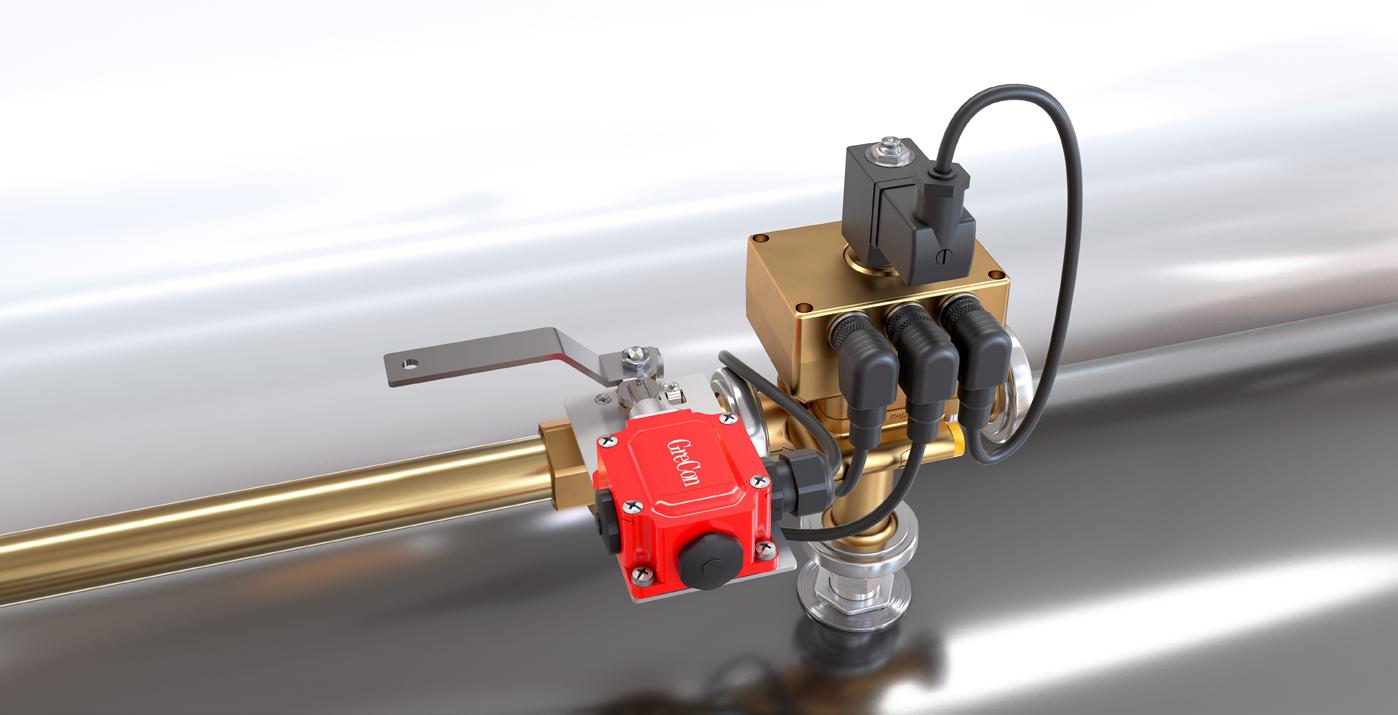
Enabling the Smart Factory
A comprehensive range of industrial process measurement solutions equips the ‘smart factory’, helping customers improve product quality in their production processes, using proven German engineering to reduce raw material and energy costs, ultimately maximising operational efficiency. As businesses see a high demand for products, we are pleased to participate in many process improvement and optimisation discussions.
We’re excited that sales visits are back on the agenda!
We were delighted to welcome Joshua McAree and Oscar Little to sales roles during 2021 under the sales leadership of Tom Burniston.
40 Manufacturing & Production Engineering Magazine
Health & Safety
We’re available for exploratory discussions and happy to conduct noobligation surveys.
Left: Spark Detector GreCon DLD 1/9 - For the best detection performance in any environment
Below: Intelligent Extinguishing Module GreCon IEM - Reliable extinguishing with integrated early wear recognition
Joshua has a BSc in Aeronautical Engineering, and Oscar holds a firstclass honours degree in Mechanical Engineering. They are excited by the prospect of helping our customers improve their processes and increase the safety of their operations.
30th anniversary for GreCon Limited
GreCon Limited is celebrating a significant milestone, with 30 years of business and commitment to the UK & Ireland market. During these 30 years, the company has focused on developing sustainable relationships with its customers and
adopting the role of a strategic partner. Founding GreCon Limited in 1992 enabled a more local connection and enhanced response times. As a result, customers across the UK & Ireland depend on GreCon for consultative and problem-solving sales engagement and first-class customer service.
Managing Director Jonathan Hamill commented, “We’re available for exploratory discussions and happy to conduct no-obligation surveys. Utilising our know-how, we believe we can play a vital role in helping industry tackle the current challenge, to emerge from the pandemic stronger and more resilient.”
Call GreCon today
Today customers all over the world rely on GreCon. Please get in touch with us and discuss how we can help:
sales@grecon.co.uk

0191 414 7200

www.grecon.co.uk

41 Manufacturing & Production Engineering Magazine
Health & Safety
Danfoss
expands Waltech tube fitting portfolio with WalringPlus® soft seal cutting ring system
Danfoss Power Solutions, a leading global supplier of mobile and industrial hydraulics as well as electric powertrain systems, has launched its WalringPlus soft seal cutting ring system. Optimized for thin-wall tube, the WalringPlus system enables easy, safe, and repeatable assembly of hydraulic tubing as well as reliable, leak-free operation.
The WalringPlus system is engineered to address the common causes of leaks that can result in costly damage and downtime. Soft sealing prevents leakage due to scratches in the tube or studs, fluid temperature fluctuation, and reduced retention force. Compared to other soft seal cutting ring systems, the WalringPlus system offers improved leak prevention through a unique two-edge design that provides two additional O-rings and integrates the O-ring within the cutting ring to avoid separate assembly of the seal. The system also eliminates the need to insert additional sleeves that increase costs and reduce flow rates.
The WalringPlus system prevents excessive or insufficient tightening. A clear block-stop function provides a tangible torque increase when an operator reaches the end of an assembly, so no torque or distance measurement is required. In addition, a significantly lower force is needed to pull the cutting ring over the tube, making assembly easier, faster, and safer, while reducing the risk of damage to the soft seal. Problems due to low assembly torque can also
be identified before the cutting ring is pulled from the tube, reducing the risk of failure in operation. The O-ring groove position enables frequent reassembly with no impact on performance.
“Thin-walled tubing with higher mechanical strength is growing in popularity for hydraulic applications, particularly in compact, lightweight equipment,” said Christian Kuenstel, global product management leader, Connectors, Danfoss Power Solutions. “Used in combination with thin-wall tube, WalringPlus can help reduce the weight, and therefore the fuel consumption, of machinery. With the system’s innovative features supporting safe assembly and reliable performance, WalringPlus is a winwin.”
The Waltech M-R7 machine can further reduce assembly time and effort as well as the risk of leaks. By automating the process of cutting ring assembly and tube forming, the M-R7 machine helps ensure optimum system performance while reducing the required torque and rotation.
WalringPlus is designed for hydraulic tube fitting applications in industries such as agriculture, construction, commercial vehicles, discrete manufacturing, rail transport, and more. The system is ISO 8434-1 compliant and can be used for tube sizes ranging from 6 to 42 millimeters. It offers a working pressure of up to 800 bar.
To learn more, visit the Danfoss Waltech tube connectors webpage.
Walter Expands Range of Face Milling Cutters

In addition to the M5009 (к 45°) and the M5012 (к 88°), Walter is now launching another Xtra·tec® XT face milling cutter in the form of the M5011 (к 75°). All three milling cutters can be equipped with the tough, double-sided SN.X1205 system insert with 8 cutting edges. An additional system insert, the SN.X0904 is available for use with the M5009 and the M5012 for smaller depths of cut. The insert range includes Walter’s own Tiger·tec® Gold grades, making them incredibly wearresistant. Depending on the material or machining objective, the user can choose between five geometries. This provides the choice for machining large batch sizes, high stability and process reliability achieving long tool life and high productivity with almost all ISO materials.
By adding the M5011 to its range of milling cutters, the Tübingen-based manufacturer is providing a range equipped with either roughing or wiper inserts for finishing. To this end, the Xtra·tec® XT M5011 face milling cutter can be used for reducing the process costs and tool requirements. Walter offers the milling cutter with a diameter of 50 to 160mm in two different tooth pitches for diameters 63 to 125mm and with a depth of cut up to 8mm. In the version with fewer teeth, the indexable inserts are mounted on a carbide shim. This protects the milling body and the remaining unused cutting edges against damage. It also maintains the cutters usability, even with long machining times. Inclined clamping screws make the indexable inserts easy to access and it shortens the indexing time.
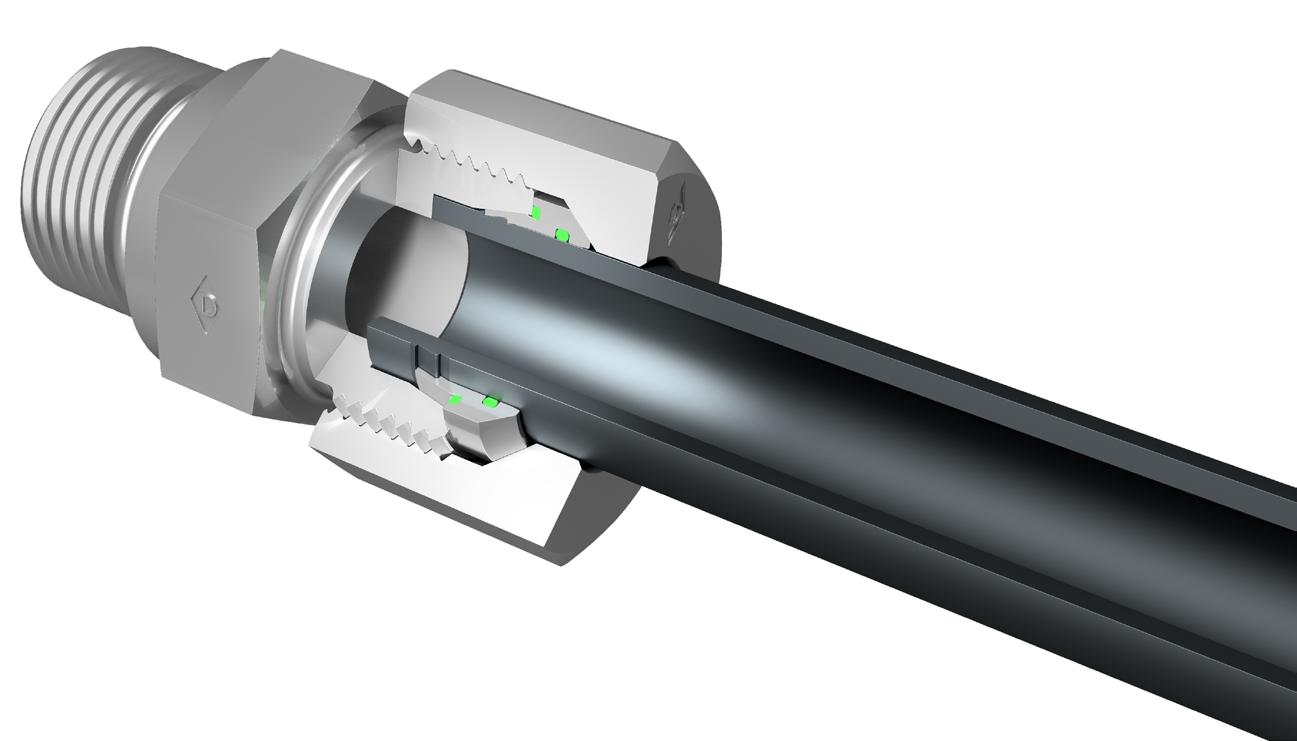
Product News 42 Manufacturing & Production Engineering Magazine
Hyfore Workholding Expands Portfolio With heimatec
The UK’s most diverse range of workholding and tooling solutions has now been expanded further with Hyfore now becoming the exclusive UK and Ireland distribution partners for the heimatec brand of precision tools and systems.
As well as providing the UK’s most comprehensive range of workholding and tooling systems, Hyfore is the leading designer, manufacturer and developer of bespoke solutions and
services. It is this in-house expertise and in-depth engineering knowledge that will be the driving force for presenting the exciting Heimatec portfolio to UK manufacturers.
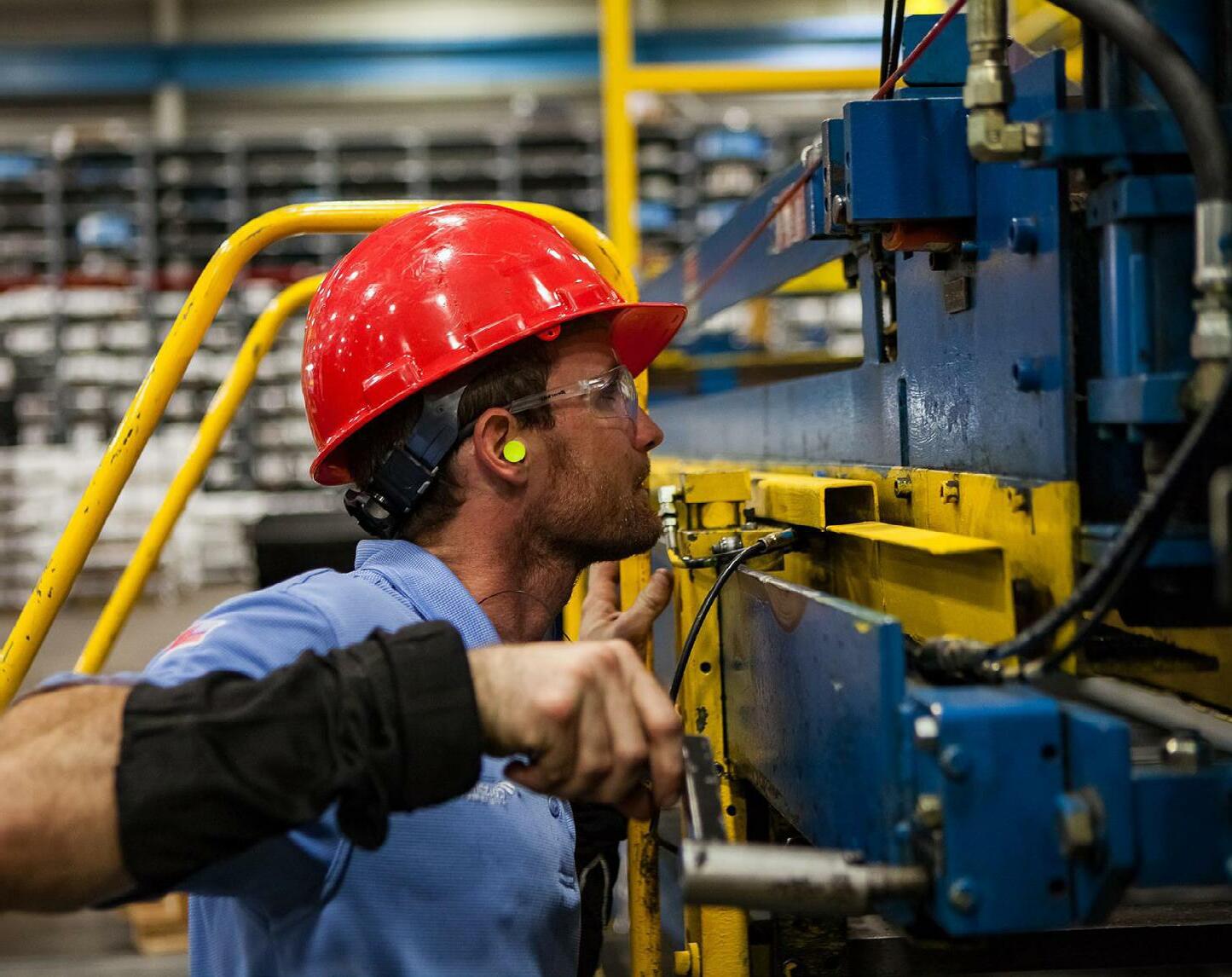
Founded in 1987 in Germany, the first activities of heimatec GmbH

included the production of carrier tools for indexable inserts and this rapidly expanded into the production of specialist radial drilling heads, quick change tooling systems for driven tools and then complete tool changing systems. Now, the heimatec portfolio includes a complete programme for static and driven tools for turning centres. This incorporates everything from axial, offset, angled and swivelling driven tool stations as well as static VDI and BMT toolholders for boring, turning, bar pulling and cut-off holders. Also in the turning range are multi-spindle heads and high-speed tools with gearing ratios of 1:4 for machining up to 48,000rpm and a complete range of accessories such as bar pullers, reducing sleeves, collets and collet chucks, shrink and tapping collets, sealing disks clamping nuts and arbors.
The German toolholding experts also manufacture a complete tooling programme for Swiss Type turning centres with live, static and customised tools supported by a diverse range of standard and special accessories that can accommodate users of Citizen sliding head machine tools.
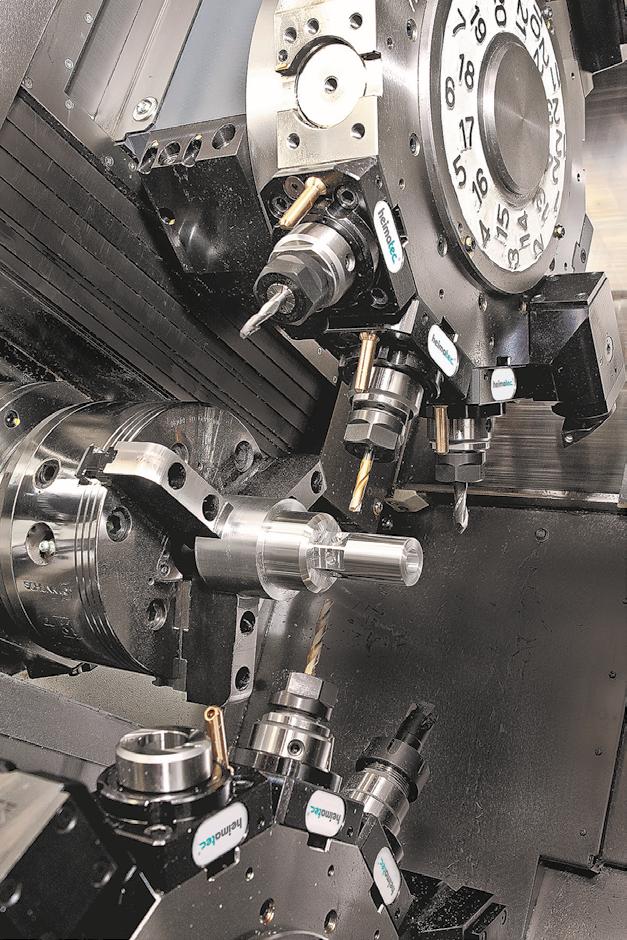
43 Manufacturing & Production Engineering Magazine Product News Affordable cooling with no chemical refrigerants Low running costs giving high Indoor Air Quality (IAQ) www.seeleyinternational.com uksales@seeleyinternational.com +44 (0)115 9635630 Healthy building, productive people!
Subcontractor Gets in Gear With Quaser Machine from ETG
With over 80 years of expertise in manufacturing specialist gears, Sovereign Gears Ltd has built a reputation for the quality of its products and services in a niche market segment.
As a supplier to the automotive, motorsport, industrial, agricultural and vintage market sectors, precision and quality is a must – this is why the Leicestershire manufacturer has recently invested in Quaser 5-axis machining that follows on from three Nakamura turning centres also purchased from the Engineering Technology Group (ETG).
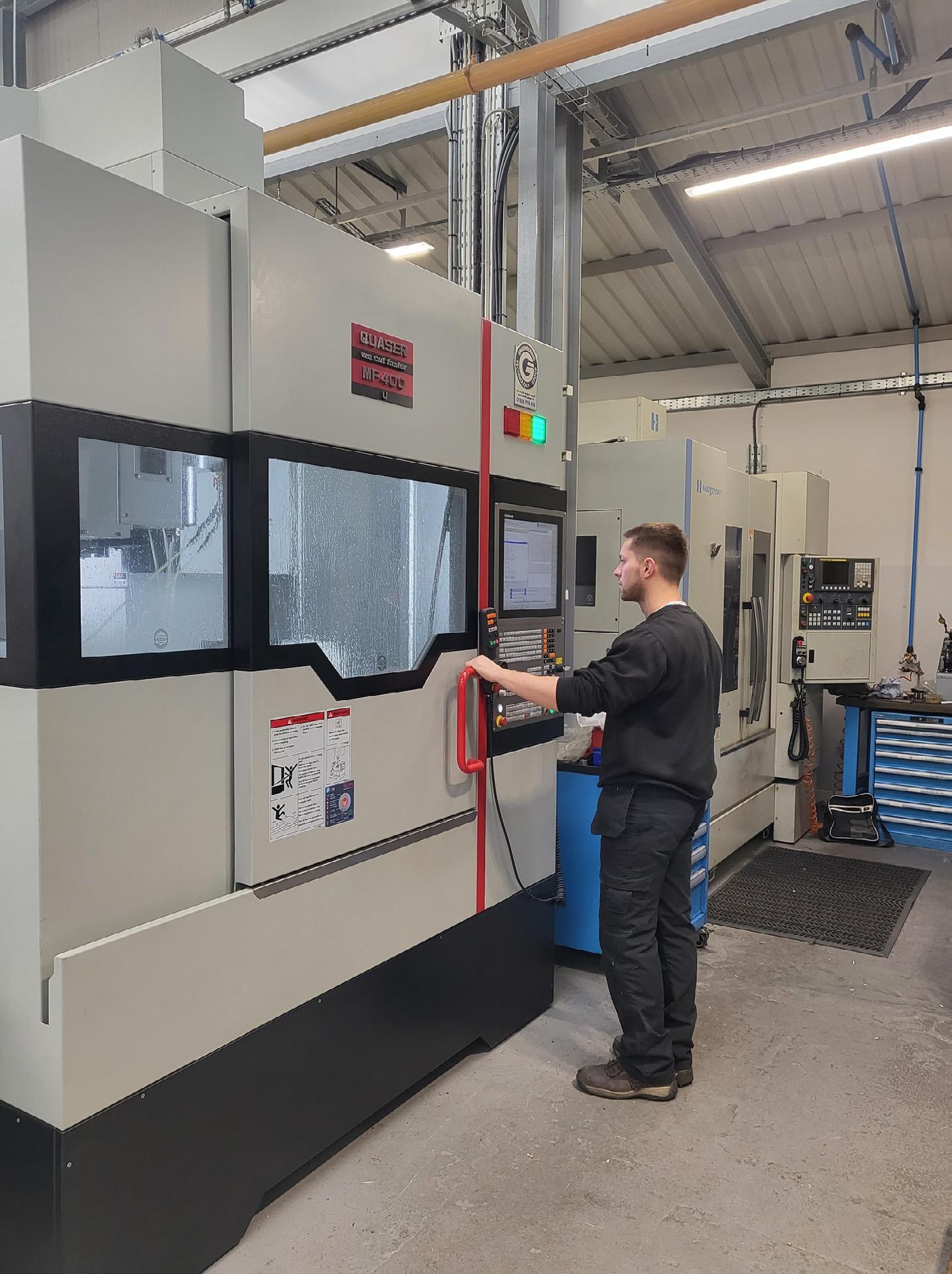
Located in Croft, just the opposite side of the M1 from Leicester, Sovereign Gears services customers nationally and internationally with the complete spectrum of gear products. This ranges from helical and spur gears, sprockets, straight bevels, worm and wheel gears spiral bevel gears, splines and much more. To manufacture this extremely diverse range of products, the manufacturing capabilities at Sovereign Gears include everything from turning, milling, wire EDM, grinding, lapping, gear cutting and reverse engineering through to gearbox design and ratio changes.
To further improve its productivity, the company has been on an investment drive recently, initially purchasing three Nakamura-Tome AS200 turning centres that were subsequently followed by a Quaser MF400UH 5-axis machining centre. As a small family business, Sovereign Gears is always aiming to optimise its processes to reduce set-ups and improve throughput. This philosophy led to the purchase of two Nakamura AS200 and one AS200L turning centre in a single order – all aimed at utilising the powerful milling capacity on the tool turret with Y-axis capability to
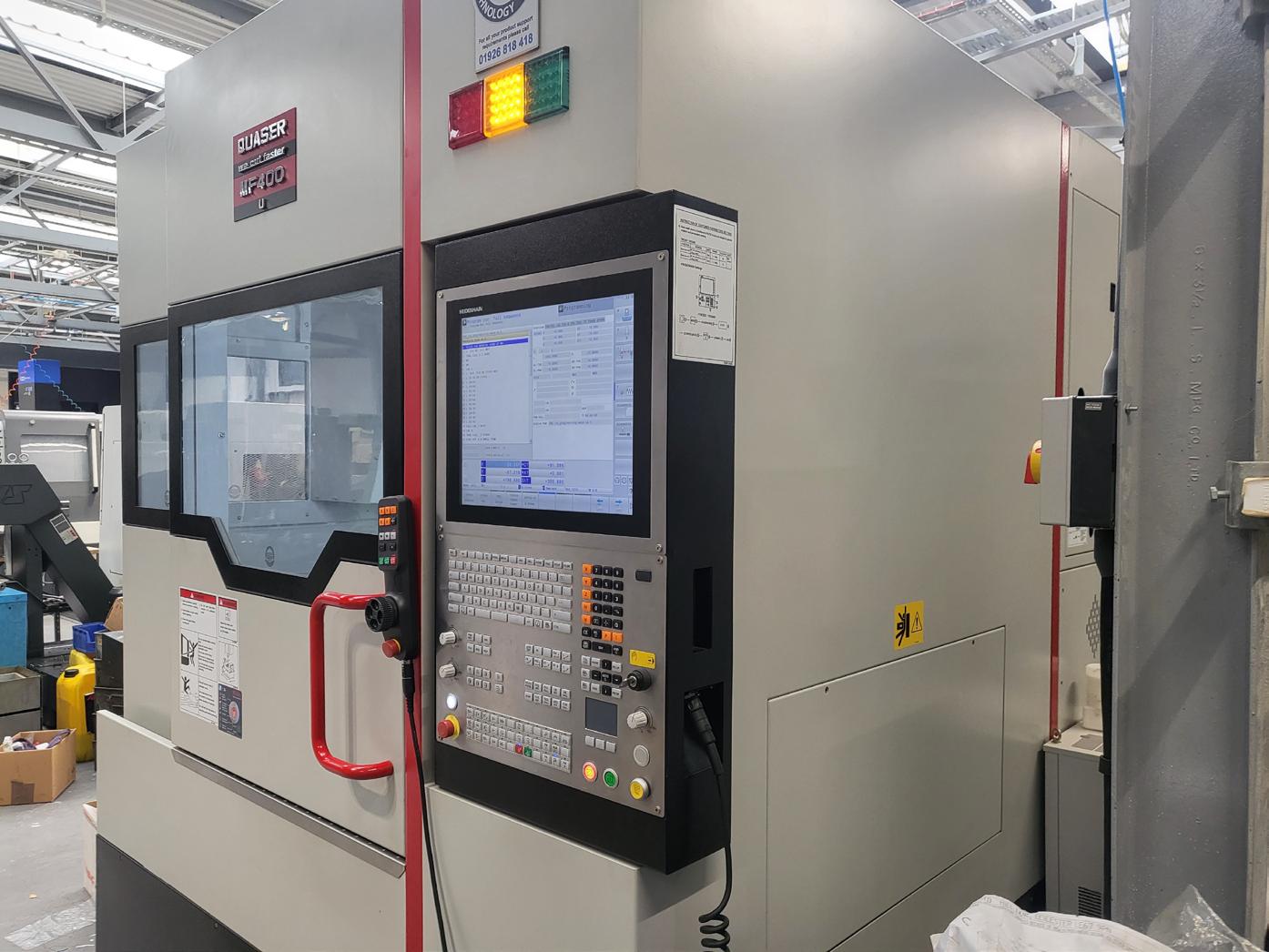
44 Manufacturing & Production Engineering Magazine
5-Axis
reduce set-ups and free capacity in the milling department. With the Nakamura machines achieving their intended aims, the company replicated this philosophy in the milling department – acquiring a Quaser MF400UH 5-axis machining centre to reduce set-ups and expedite throughput.

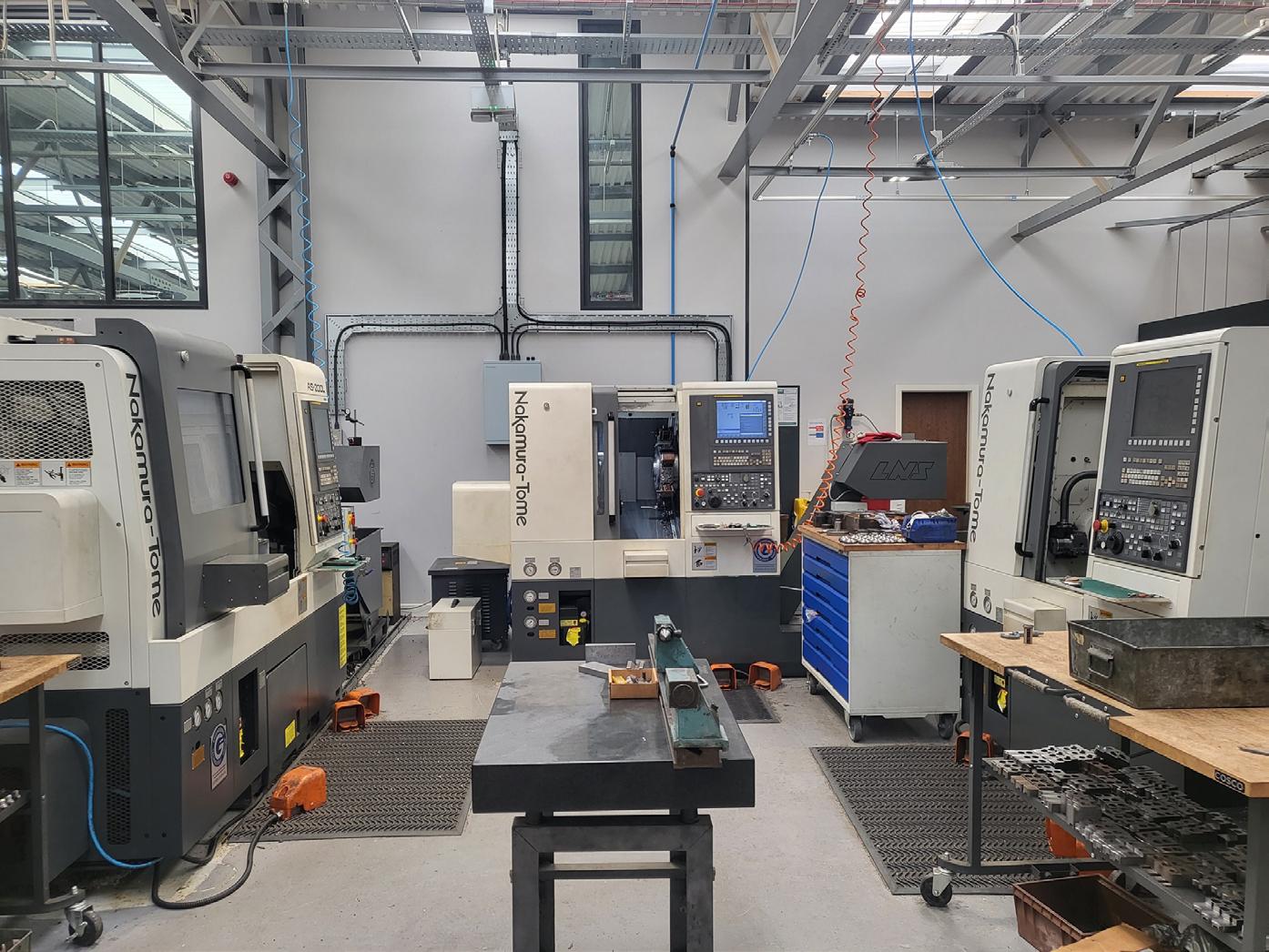
Commenting upon the compact 5-axis powerhouse that arrived in the summer, Sovereign Gears Director, Mr Ryan Spring says: “The majority of our work is 1 and 2-off bespoke gears as well as jigs and kits for holding, assembling and working with the gears. Unfortunately, with so many complex forms, most of our milling work requires 2, 3 or 4 set-ups and this can take a lot of time and slow down our throughput. We bought the Quaser MF400UH with OPEN MIND’s high-end hyperMILL CAM software, also supplied via ETG to reduce our set-ups. The Quaser is our first 5-axis machine and it’s a technological leap we are still getting used to. Despite this, we are already seeing huge benefits with the Quaser.”
The multitude of gears and associated jigs and kits have upward of 3 to 4 setups per part and due to the complex nature of the components and the precision required, each set-up can average an hour. This means that each part often spends up to 4-5 hours being set up for machining. The Quaser has instantly eliminated 75% of this time, and with only a single set-up required for 5-sided machining, the precision of each component is significantly improved.
“As a small business, it is imperative that we maximise the productivity of both our machine tools and our staff. By having the Quaser machine and reducing our set-ups, we are freeing up the capacity of two employees. Instead of spending excessive hours repeatedly setting up 3-axis machines, staff can be allocated to other tasks,” adds Ryan.
When looking for a 5-axis solution, Sovereign Gears reviewed the market extensively and narrowed the selection process down to two machines, the Quaser MF400UH machining centre and a high-end 5-axis machine from another world-leading brand. Commenting upon why the company opted for the Quaser,
Ryan says: “The machine from one of the world’s leading brands wasn’t on a par with the Quaser. The Quaser was a better option with dynamic kinematics and a high specification. Furthermore, the 320mm diameter worktable is perfect for our business, as we have very few parts that extend beyond 200mm diameter. Within this compact work area, the Quaser is a very fast, powerful and dynamic machine.”
“Since having the Quaser, we have improved our ability to machine complex forms and this has ultimately won us new business that previously, we would have turned away. The ability to increase the type of work that we can machine, such as round gear teeth, challenging chamfers, forms and keyways has enabled us to increase our customer base and our offering to those customers.”
The Quaser MF400UH provides an X, Y and Z axis of 680 by 610 by 510mm with an A-axis tilt of +30 to -120 degrees with a 360-degree continuous C-axis, providing an impressive work envelope in a small footprint machine. The BBT40 spindle taper is supplied by a 30-position ATC with 48, 60 and 120 positions available. Concerning further options, the end-user has a multitude of choices that range from all of the leading CNC control systems, a variety of spindles with speeds from 10,000 to 20,000rpm as well as several torque outputs. Similarly, coolant, swarf evacuation, automation and a host of other features have a plethora of options to suit the specific demands of the customer.
As well as the multitude of options to configure the machine, the compact footprint with a considerable work area
was another reason why Sovereign Gears opted for the Quaser from ETG. As Ryan concludes: “We have bought machine tools from ETG for many years. The service and support have been outstanding. Whenever we have required technical support or if there has ever been an issue with a project or a specific problem with a machine, ETG has been on hand to help us 100%.”
45 Manufacturing & Production Engineering Magazine
The Quaser is our first 5-axis machine and it’s a technological leap we are still getting used to.
5-Axis
Ryan Spring
We have bought machine tools from ETG for many years. The service and support have been outstanding.
Ryan Spring
IFE Manufacturing returns for the food processing and packaging sector
Visitor registration has opened for IFE Manufacturing, which will return to ExCeL London on 20-22 March 2023 as a comprehensive event for end-to-end food & drink production.

Taking place alongside IFE, International Food & Drink Event, IFE Manufacturing welcomes a wide range of product developers, F&B brands, packaging and manufacturing processionals and anyone with an interest in creating quality food & drink products and the latest innovations in NPD.
Visitors to the show can meet with businesses such as compostable packaging supplier BioPak, leading branding agencies like Threesixty Design, printed packaging specialists like Brandpax and quality ingredients suppliers and providers of superior manufacturing solutions.
The Trends & Innovation Platform will play host to industry leaders, food & drink brand owners and consultants discussing the major trends and challenges in the food production sector, such as rising costs, stretched supply chains, sustainable packaging innovations and opportunities to increase efficiency and output in
manufacturing. The show will also offer food & drink brands the chance to visit the Certification Clinic, where they can learn what it takes to achieve various industry accreditations, and Ask the Expert, where they can receive objective, tailored advice to take their product or business to the next level.
James Hague, Relationship Director, Food and Drink Manufacturing at Barclays, said of the 2022 event: “IFE Manufacturing is continued evidence of how important the food sector is, and the breadth of ongoing innovation designed to meet future supply chain and environmental needs.
“The event really pressed home the development happening at pace within the industry and allowed me to speak directly to many companies directly on their key challenges and opportunities.”
IFE Manufacturing is pleased to be continuing partnerships with a number of major industry associations covering all areas of food production into 2023.
Emma Verkaik, Marketing & Membership Director at the British Contract Manufacturers and Packers Association (BCMPA), comments: “The BCMPA are delighted to be exhibiting
at IFE Manufacturing in March 2023 and representing our food and drink members.
“It is the perfect event for companies looking to outsource the manufacturing and packing of their projects to visit and engage with companies providing these services and to learn more about how they can find an outsourcing partner via the BCMPA.”
David Newman, MD of the BioBased Industries Association, adds: “The BBIA is delighted to be partnering with IFE Manufacturing once again in 2023. Developing a sustainable bioeconomy is a hugely important topic in food & drink production and we’re glad to see that this is topping the agenda at this year’s event. We’re excited to meet with the food & drink brands and manufacturers attending the event and hear about the latest trends and innovations in the sector.”
IFE Manufacturing takes place alongside IFE, Hotel, Restaurant & Catering (HRC) and The Pub Show @ HRC at ExCeL London on 20-22 March. Register for your complimentary trade ticket and keep up to date with the latest show news, at ifemanufacturing.co.uk
Exhibition 46 Manufacturing & Production Engineering Magazine
EXPERTS IN PUMP TECHNOLOGY
Our progressive cavity pumps, macerators and control systems are used across all industry sectors wherever thin to highly viscous, shear-sensitive, aggressive or abrasive media must be conveyed at low pulsation rates.

SEEPEX’s portfolio also includes digital solutions, consulting, spare parts and after sales services.
“SEEPEX stands for technological leadership, excellent management and outstanding product and application expertise. Focusing on our core competencies and know-how enables us to take the best, most forward-looking course of action for each part of our business. We identify innovative approaches that bring about positive changes for the entire industry.”
PETER MCGARIAN MANAGING DIRECTOR, SEEPEX UK LTD.
SEEPEX UK Ltd. | sales.uk@seepex.com | www.seepex.com
Are drones in the pipeline? Technology
The buzz around drones in the oil industry

A bee can travel over five miles and then remember its way home, despite possessing a brain the size of a pinhead. Scientists have been putting them in virtual reality simulators to help improve unmanned aerial vehicle (UAV) or drone technology. While the honey bee currently has the edge, drone technology is catching up. Here, Chris Johnson, managing director at miniature bearings specialist SMB Bearings, explains the challenges and opportunities when using drones to monitor and inspect oil and gas pipelines.
Drones are being employed in a wider range of sectors and for myriad purposes. The further growth and adoption of this technology will be encouraged by consumer market growth, spill overs from the military sector and the possibilities opened up by 5G. The potential for drones to
revolutionise the world of maintenance is clear. They certainly pass the ‘D test’: tasks that are dirty, dangerous and dull could all be left to drones.
BP, Shell and Exxon have already begun using drones for asset inspection and other tasks. Following an incident in 2008, where Exxon’s use of sonar technology was implicated in the deaths of 100 whales near Madagascar, the company recently used drones to help monitor the locations of whales off the coast of Santa Barbara. But what about the benefits for pipelines?
Opportunity in the pipelines
From Alaska to the Niger Delta, oil pipelines are often located in inhospitable or even dangerous environments. In addition to their vast size, this fact makes maintenance through visual inspection a dangerous task. By handing the task of visual
inspection over to drones, human workers are no longer in harm’s way.
Making the task of maintenance safer is not the only incentive. Early investors in the technology are seeing significant cost savings. Although it is difficult to quantify the precise saving, research by Roland Berger, has estimated that drone-based inspection of oil and gas rigs leads to cost savings of around 90 percent. The same research estimated that the use of drones has cut maintenance times from eight weeks to five days. The bottom line is that drones will provide a more cost-effective alternative to traditional asset inspection methods such as helicopters and ground vehicles.
However, drones are not simply replacing existing methods. Their agility allows them to offer visualisation and data analysis that existing methods cannot compete with.
49 Manufacturing & Production Engineering Magazine
For example, satellites are limited by their orbit and weather can disrupt the accuracy of the images they provide. An engineer would have to assemble scaffolding to physically access a potential problem.
Scientists now claim that sophisticated sensors are developed enough and small enough to be mounted on UAV systems. As well as capturing high resolution visual data, drones can be equipped with other sensors to monitor pipelines, such as thermal imaging or ultrasound inspection.
Challenges for take off
Companies wanting to adopt this technology must also make sure they understand the evolving regulatory environment. Those that already use aviation, for example with helicopters, are probably in a better position to confront this hurdle due to their existing knowledge of aviation regulation.
Beyond visual line of sight (BVLOS) is among the most discussed things in the drone industry. This refers to where a drone is operating beyond the pilot’s line of sight. BVLOS activity will be necessary to enjoy the full benefits this technology could offer for asset inspection of pipelines, but in some countries it is not permitted.
In the United States, for smaller drones flying below 400 above ground level (AGL), BVLOS is currently not permitted without the necessary authorisation from the Federal Aviation Administration (FAA). To navigate around this restriction an FAA waiver is required. According to
Geospatial World, 99 percent of waiver applications fail.
The restrictions are different when you enter different airspace classifications (those above 400 AGL). For pipelines that traverse national boundaries, these regulatory issues become even more complex.
Another consideration many businesses must make is what business model to adopt. In its guidance for the industry, the American Petroleum Industry outlines three alternative models.

Although the technology is constantly improving, there are limitations that are relevant to their potential for surveying pipelines. The limitations of the batteries that power the vehicles gives rise to range anxiety, a problem that is more significant for pipelines that cover significant distances. It is likely the industry will focus on using drones for inspection of oil rigs and other infrastructure before taking on the challenge of vast pipelines.
Something to bear in mind
If maintenance engineers are to exploit the benefits of UAV technology, keeping the drones in tip-top condition will be essential. Understanding the maintenance needs of these vehicles will be important for those companies who adopt the internal model referred to above. Engineers will need to be quick to acquire fresh expertise in this area.
Maintaining and replacing the bearings in drones will be an essential part of this. Many oil installations face significant
risks from corrosion. Bearings too, need protection from corrosion. If your drone is operating in an environment where this risk exists, speak to a reputable supplier like SMB Bearings for the best information on bearing choice for your application.
The buzz surrounding drones is only set to grow and their use in monitoring and maintaining oil installations will allow the oil industry to improve worker safety, reduce the time taken to complete key maintenance tasks and realise substantial cost savings. If you are thinking of adopting an unmanned aerial vehicle program to monitor your assets, consider the benefits of partnering with a reliable supplier of high-quality precision bearings to help keep your drones in the air.
To find out more visit smbbearings.com
49 Manufacturing & Production Engineering Magazine
SMB Bearings is a specialist supplier of miniature bearings.
Scientists now claim that sophisticated sensors are developed enough and small enough to be mounted on
UAV
systems.
Technology
- Chris Johnson
CMMS Software: Rockwell Automation digitally transforms maintenance activities at the UK’s leading steel stockholder
Rockwell Automation, Inc. (NYSE: ROK), the world’s largest company dedicated to industrial automation and digital transformation, has announced that Barrett Steel has chosen the Fiix computerised maintenance management system (CMMS) to manage its ongoing maintenance programmes and reduce downtime.
The deployment of the CMMS from Fiix is part of a digital transformation of Barrett Steel’s maintenance activities, with the aim of streamlining, simplifying and mobilising the entire programme.
The UK’s largest independent steel stockholder had already deployed an OEE system developed and installed by CHG, a trusted supplier of Barrett Steel and a Rockwell Automation recognised system integrator.
CHG recognised that the Fiix CMMS would be ideal to develop and scale the system further and partnered with Rockwell Automation to create a tailored solution, based around a five-year ROI project.
Fiix’s cloud-native CMMS creates workflows for the scheduling, organising, and tracking of equipment maintenance, connecting seamlessly to business systems to drive data-driven decisions.
As one of the world’s most widely used CMMS solutions, Fiix has more than 2 million assets under management and creates more than 6 million work orders per year.
Another essential element of the maintenance-operations transformation is the ThingWorx® SaaS-based SCP (smart connected products) package from PTC, which connects all the business systems together, displaying the correct information to the correct people.
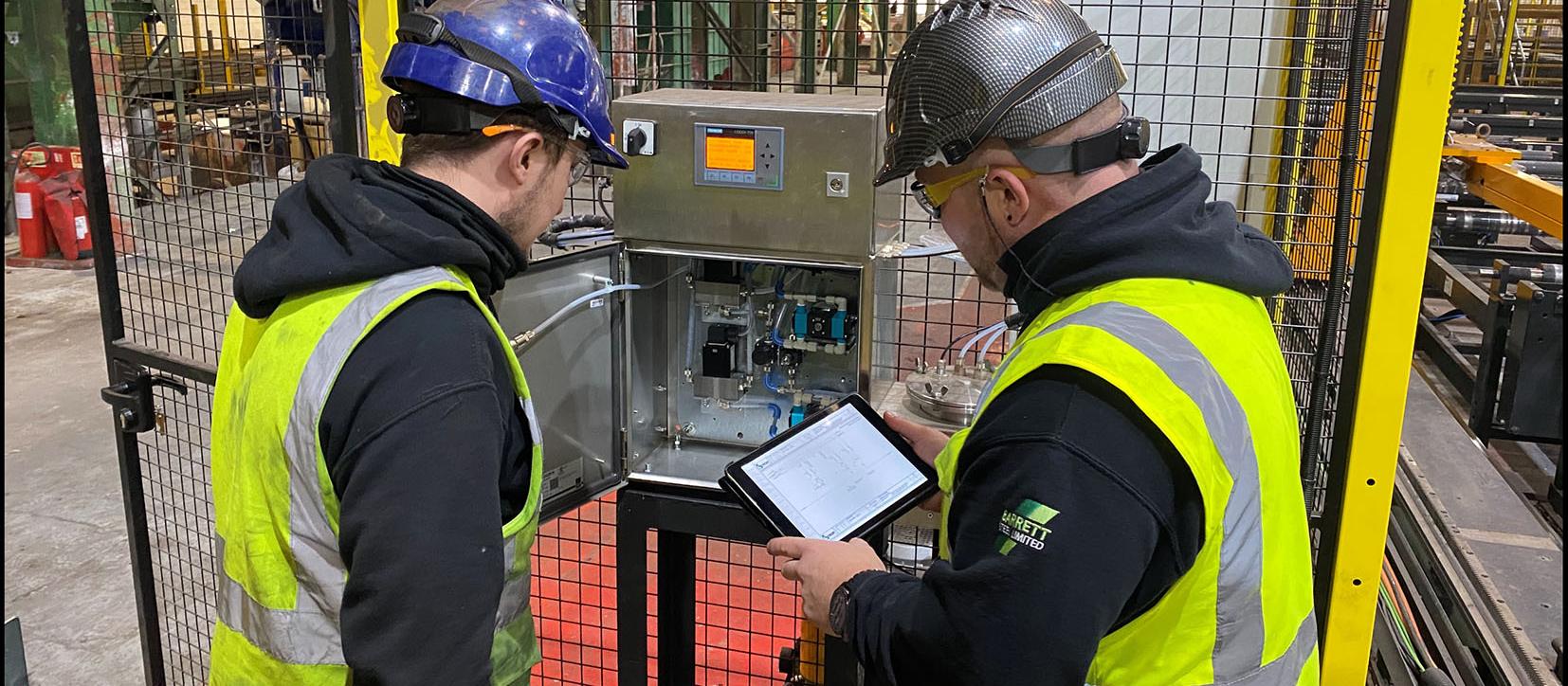
ThingWorx provides the functionality, flexibility, and scalability that businesses need to drive industrial innovation, including the ability to source, contextualise and synthesize data, while orchestrating processes and delivering powerful web, mobile and AR experiences.
Malte Dieckelmann, regional vice president, software sales EMEA at Rockwell Automation, commented: “We put forward a digital transformation plan that focused around ThingWorx coupled to a powerful but easy-to-use CMMS solution that would allow them to simply raise work-order tickets, identify outstanding health and safety jobs, and digitise paper-based processes. The resulting package reduces risk to both day-to-day operations and personnel.”
Peter Clarke, director at CHG, explained: “We set up a trial of Fiix and incorporated some value-added demonstration data, based on an installed-base evaluation. Using this information, we then created some preventative maintenance schedules that Barrett Steel was able to simulate and test using mobile phones and tablets – a major part of the initial brief.”
“We have been at the forefront of the UK steel industry for more than 150 years and place our customers at the core of everything we do,” said Paul Burke, operations director at Barrett Steel.
“Downtime at any of our 26 UK sites could lead to delivery delays, which are simply unacceptable. Therefore, we always look to deploy the best possible contemporary solutions to help ensure maximum uptime. Due to the mobile nature of our operations, remote access was essential as was the ease of use, and the Fiix/ThingWorx package is perfect for our needs.”
The installation of a CMMS solution is one of the first steps in the company’s ambitious digital transformation plans, which will eventually encompass a wider spread of applications and technologies, all of which can be developed, tailored, deployed and supported by CHG Electrical and Rockwell Automation.
50 Manufacturing & Production Engineering Magazine
Technology
CMMS Software: How a digital approach is enhancing maintenance culture
Manufacturing organisations know that the breakdown of critical machines will quickly create multiple issues on a production line. Gary Marsden, global product manager for Elecosoft’s ShireSystem maintenance and facilities management software, explains how a building product manufacturer is using software to protect uptime, and how Elecosoft is introducing software to help manufacturing companies mitigate health and safety risks.
A global manufacturer of insulation boards and insulated panels for the building industry, relies on continuous production lines that run on a 24/7 basis. The most critical step on its lines is when metal sheets and chemical foam insulation are combined while the foam is still curing. This is a time and temperature-critical step where an unplanned outage at any point on the line can quickly escalate into a major issue. Therefore, a team of mechanical and electrical technicians is in place on each site to plan carefully in order to maximise uptime.
They use our Computerised Maintenance Management System (CMMS) to keep track of machine performance, track maintenance schedules and also analyse the frequency of component failures and replacement part availability. Its engineers use these records to better predict when critical parts are approaching the end of their life and proactively replace them to avoid unplanned downtime.
As a result, they are able to optimise maintenance schedules and avoid line operators standing idle while maintenance is underway. It also aligns with their sustainability goals and prevents products and raw materials from becoming spoiled or wasted.
Digital permit to work
The latest development in CMMS systems is something that I feel complements the planned and scheduled maintenance capabilities, by underpinning the safety culture within a production environment which can also impact production line efficiency. This development adds digital permits and risk analysis modules to our ShireSystem CMMS. It is something every customer I talk with is either digitalising or planning to implement in 2023.
This new capability allows for pre-work safety checks of maintenance workers
who are exposed to high levels of risk on tasks such as working at height, with extreme temperatures or high-voltage electrical equipment.
Manufacturing organisations typically use a paper-based process to ensure technicians have the right qualifications, equipment and are following the correct processes. However, these systems are not infallible. The HSE has recorded 61,000 non-fatal and 123 fatal accidents in 2021-22, and the manufacturing industry experiences higher accident rates than average.
A study by the University of Bristol found that three of the top underlying risk factors are: weak safety management systems; a poor safety culture; and a lack of adequate risk assessments. The permit to work process is at the centre of these three factors – and upgrading to a digital system can help overcome them.
Under the conventional approach, workers apply for safety permits to a local safety coordinator using email or paper, who shares permit data with a central health and safety manager. This can create compliance gaps and delays.
Software overcomes these issues by automating the allocation of permits and risk analysis to a maintenance task.
Paper permits can be lost on site, teams use different processes or there may be inconsistency in reporting.
Software overcomes these issues by automating the allocation of permits and risk analysis to a maintenance task. It therefore provides a consistent and accessible platform for all parties. Maintenance managers can easily access and check permits, local coordinators experience less administrative burden and the HSE lead has full visibility. As a result, they can easily run reports, track performance and follow up on issues.
Using a digital permit to work as part of a CMMS will help manufacturing organisations to create a strong safety process, culture and practices.

51 Manufacturing & Production Engineering Magazine Technology
The manufacturing industry is the world’s most cyber-attacked industry
The manufacturing industry is failing to protect itself from cybercrime, according to MSP – the leading manufacturer of stampings and springs.
With research showing the manufacturing industry faced almost one in four of the cyberattacks in any industry, MSP is urging manufacturers to start putting cybersecurity at the top of their agendas both for themselves and their upstream customers.
Neil Matthews, Managing Director at MSP comments, “While cybersecurity affects every company in all industries, the manufacturing industry overall is particularly vulnerable and prone to cyberattacks and can face considerable challenges such as the theft of intellectual property.”
“Malware and ransomware attacks are increasingly using sophisticated new tricks to infiltrate and exploit weaknesses. These attacks can result in a loss of competitive advantage, denial of access, or damage to operational systems including production facilities. Significantly, it can also negatively impact a manufacturer’s trading reputation, leading to a loss of customers or suppliers.”
By the end of 2021, cyberattacks cost the global economy an estimated $6 trillion, which would reportedly escalate to $10.5 trillion by 2025.
Neil noted, “For the first time in five years, the manufacturing industry has outpaced the insurance and finance industries in the number
of cyberattacks levied against the industries. With nearly half of British manufacturers having fallen victim to cybercrime since 2018, the industry can no longer adopt the notion that ‘it won’t happen to us’”

The manufacturing industry had a reported 23.2% share of cyberattacks and a further 33% increase in the number of incidents caused by vulnerability exploitations from 2020 to 2021. In that same period, 63% faced losses of up to £5,000, with 22% revealing a cost to their business of between £5,000 and £25,000.
Neil continues, “As manufacturing businesses grow increasingly digital, it is now more important than ever that companies’ cybersecurity is just as proactive, because reactive improvements are too late, and damages will already have occurred.
“Vulnerabilities like singlelayered protection, lack of firewall implementation, lack of protection to broadband connections and others can all be easily exploited by cybercriminals when the reality is that these vulnerabilities can be easily fixed and remote working infrastructures strengthened.”

Neil has outlined four tips for manufacturers to protect themselves from cybersecurity attacks:
1. As a starting point, manufacturers need to evaluate their cyber threat landscape and introduce regular cybersecurity awareness training for staff.

2. Companies should avoid unauthorised system access by using Multi-Factor Authentication and have timely updates of security patches on computers and systems.
3. Manufacturers should increasingly look to take out cyber insurance and undertake regular security risk assessments, introducing a robust backup and disaster recovery policy and plan.
4. Strict processes should be in place around sending sensitive files externally to combat the risk of breaches and minimise the damage an attacker can do by accessing them.
Neil adds, “The increasing technative nature of criminals, who have similarly adapted to the changing landscape of technology, and the lucrative nature of data means that manufacturing experts agree that cybersecurity can no longer be taken for granted. Instead, we firmly believe it should become an integral element of all company’s strategies and plans for the future.”
Technology 52 Manufacturing & Production Engineering Magazine
For the first time in five years, the manufacturing industry has outpaced the insurance and finance industries in the number of cyberattacks levied against the industries.
TRUST IN CHAS
HASSLE FREE ACCREDITATION
CHAS are the UK’s award winning and leading accreditation scheme for contractors and supply chain management services for clients. We make getting an accreditation quick, easy and hassle-free. You could achieve compliance in all areas of risk management in as little as 2 days.

JOINING IS EASY

Simply visit chas.co.uk and you’ll find everything you need about our accreditations and the benefits. Or call our expert, friendly team on 0808 599 0115
QUICK & EASY ACCREDI TATION
Save money
2 DAYS

Prequalify
Manage risk

for
of
with leading
1000s
opportunities
organisations





























































































































 Jonathan Hamill
Jonathan Hamill


























